
We've been tracking GPU prices on all the best graphics cards and the latest additions to our GPU benchmarks hierarchy for the past couple of years. To do this, we scrape eBay's sales data to get details on what sort of prices people are paying for (typically used) GPUs — if you're only interested in retail prices on current generation hardware, check our GPU price index.
We provide monthly (-ish) updates on eBay's prices for the latest generation Nvidia Ada Lovelace, AMD RDNA 3, and Intel Arc Alchemist GPUs, as well as previous generation Nvidia Ampere, Turing, AMD RDNA 2, and RDNA graphics cards. Depending on the month, we provide an analysis of the latest trends in pricing.
The past few months have seen a bit of up and down movement, as we head into the holiday season. Some of the fluctuations may be due to a potentially limited supply of Nvidia's top RTX 4090. At the same time, we're also seeing a lot of "too good to be true" prices on some of the fastest cards. Beware of what you're buying, in other words, and look for signs of scamming: If you see a price that's less than half the going rate we list here, it's probably not real.
There haven't been any new GPU launches since last month's Arc A580. Not surprisingly, there aren't any eBay sales of that particular GPU — scalpers aren't trying to turn a profit on a near-budget GPU that's perhaps already overpriced. The RX 7800 XT and RX 7700 XT have started to show up in limited quantities, though only GPUs that have sold at least 50 units in a month have any real significance.
We're in November now — all hail the Black Friday GPU madness — so our last full month of data comes from October. We filter the sold listings on eBay, doing our best to remove junk listings (e.g. box only, image of card, bundles, broken cards, etc.) to collect average prices. Some people pay quite a bit more while others pay substantially less, but the month to month trends are the primary focus.
Most of the Nvidia RTX 40-series parts show a downward trend, but the RTX 4090 price has spiked upward by 6%. Again, there seem to be a lot of what I would classify as fake listings, which I eliminated from the pricing trends — it's difficult to imagine anyone selling a functional 4090 for under $800, basically. The RTX 4070 Ti prices also seem a bit suspect, though certainly we agree that the $799 MSRP is too high so it's a bit more believable. All of Nvidia's RTX 30-series cards meanwhile slow a slight downward trend, which is what we would expect.
AMD's RX 7000-series parts are mostly flat, unless you want to include the single data point for the RX 7700 XT. The RX 6000-series GPUs meanwhile continue to drop, sometimes by a large percentage. As with some of the Nvidia GPUs, we're a bit skeptical that prices on certain models have falling by nearly 20% in a single month. At the same time, the new RX 7800 XT basically matches the RX 6900 XT in performance, has a $549 MSRP, and uses less power. It also has some new features, so we wouldn't pay more than $500 for a previous generation AMD card at this point and that could be reflected in the eBay prices.
Intel's Arc GPUs meanwhile have only sold in very limited quantities on eBay. The A750 is the most popular, for good reason, with an average price of just $165. It generally competes with the Nvidia RTX 3060 and AMD RX 6600 XT in performance, with similar pricing to the AMD card.
The next older generation of AMD and Nvidia GPUs continue to drop as well, and games like Alan Wake 2 suggest a lot of people may start looking at potential upgrades. Even the RTX 2080 Ti only managed a playable 69 fps at 1080p medium, with DLSS Quality upscaling. Turn on ray tracing and it dropped to just 35 fps, and only 21 fps with path tracing. Yikes! Not that newer cards were all massively better, but the 4070 managed a playable 43 fps with path tracing at least (and that's without Frame Generation).
There are a few curious fluctuations in monthly pricing on these older graphics cards, like the RX 5600 XT and GTX 1650 GDDR5 both increasing in price by over 10%. It's difficult to come up with good reasons for buying that level of hardware at anything above $100 or more, but there appear to be a decent number of people willing to do just that.
The best overall value, assuming you don't care about ray tracing or DLSS, continues to be the RX 5700 XT at just $116. In most games (i.e. games that aren't Alan Wake 2), it will still average over 70 fps at 1080p ultra, roughly matching the RX 6600 XT for $50 less. That's of course assuming you're willing to risk a used GPU that would have been around during the heyday of GPU mining in 2020–2022.
Here's the eBay GPU pricing data and commentary from the month of September, 2023.
The past few months have seen a bit of up and down movement, curiously, with some of the top Nvidia cards jumping up in prices during August and then coming back down in September. We've also seen the launch of the RTX 4060 Ti 16GB, RX 7800 XT, and RX 7700 XT (with the Arc A580 arriving this month, so it's not in the data yet). We're in October now, so our last full month of data comes from September.
Nvidia's RTX 40-series parts show a downward trend compared to last month (except for the 4070 Ti), but that's because most of their prices spiked upward during August. Back to school shopping fever, or people upgrading PCs using student loans? Or maybe just some oddities in eBay's data. Whatever the cause, the GPUs are mostly back to where they were in July.
AMD's hardware also saw a few upticks in eBay pricing during August, and some different GPUs trended upward in September, but mostly things are still trending down. We suspect the supply of many of these GPUs is also becoming more limited, though there are no clear patterns in how many GPUs will be sold each month. July was a slower month, August picked up slightly, and September was down on units sold again.
We probably need to shift all the RTX 30-series and RX 6000-series cards down into the "legacy" table below, but we'll leave them for now. Most of the Nvidia cards appear to have bottomed out on pricing, with a slight upward trend during September. Perhaps that's just people hoping to get a little bit extra for the cards during the holidays, though with the launch of faster and generally better RTX 40-series and RX 7000-series parts, I don't really see that working out.
The previous generation GPUs (n-2 now) aren't moving as much overall. July say a 6% drop in average prices, August showed no change at all, and September shows a slight 2% dip. While these cards are mostly still capable (at least on the higher spec models), our latest testing of Alan Wake 2 shows how these older GPUs are really starting to show their age. Even the RTX 2080 Ti didn't mange great results in that game.
But if you're not worried about maxed out settings and path tracing, and just want a modest GPU for gaming purposes, these previous generation cards can still be competitive. The best values unfortunately are on cards at the lower end of the performance ladder, or cards that lack more recent features.
AMD's RX 5000-series for example are basically going for a song these days. $115 for an RX 5700 XT? That still competes with the RTX 2070, RTX 3060, and Arc A770. But it has no support for ray tracing, plus it was popular for GPU mining for a while, so people don't seem as interested in picking one up these days.
August 2023 eBay GPU Prices
Here's the eBay GPU pricing data from the month of August, 2023.
July 2023 eBay GPU Prices
Here's the eBay GPU pricing data from the month of July, 2023.
Original text from July follows:
We're going to do full quarterly updates moving forward, with the intervening months focusing just on the price tables. The RTX 4060 also became available at the end of June, but so far no one has purchased such a card off eBay — no real surprise considering the GPUs are readily available online at MSRP.
Since we're now in July, the previous full month of data comes from June. We filter the sold listings on eBay, removing junk listings (e.g. box only, image of card, bundles, broken cards, etc.) to collect average prices. Some people pay quite a bit more while others pay substantially less, but the month to month trends are the primary focus.
Other than the "new" GeForce RTX 4060, GeForce RTX 4060 Ti, and Radeon RX 7600 cards that didn't have any significant volume (and the same goes for the Intel Arc A770 8GB and A380), nearly everything trended down slightly and you can find some good deals — if you're willing to buy a used graphics card. Note that there's less risk with the latest generation hardware, since all of those GPUs launched long after Ethereum mining ended.
Despite what you might think represents rock bottom pricing, the previous generation Turing and RDNA GPUs continue to get cheaper. Some of these cards even dropped by 10% or more compared to last month.
It's still pretty amazing how little the Radeon RX 5000-series GPUs cost. The RX 5700 XT uses more power than the latest GPUs, but in terms of performance, it's roughly at the same level as the RTX 3060, Arc A770, and RX 6600 XT in our GPU benchmarks hierarchy. Of course, it also doesn't have any ray tracing support, though for $130 we think that's pretty forgivable.
Given their age, it's a safe bet that nearly all of these older GPUs were used for mining, potentially for a couple of years or more. The exception would be cards with only 4GB of VRAM (GTX 1650, RX 5500 XT 4GB). Caveat emptor, in other words.
Original text from early June follows:
It's been a bit since our last full update, which we're now going to do on a quarterly basis. However, we still collected data for the intervening months, which you can find (without commentary) on the following pages. We've also seen a few more GPUs launch since the last update, namely the RTX 4070, RTX 4060 Ti, and RX 7600. None of those are going to set the world afire with their value propositions, but there's good news in that eBay sales on those are decidedly grim. There's little in the way of demand that could push prices above MSRPs, in other words.
As we're now in June, our latest full month of data comes from May. We filter the sold listings on eBay, as best as we're able, to collect average prices. That does mean that some people are paying quite a bit more, while others may get a great deal and pay substantially less. Here's how things stand.
The GeForce RTX 4060 Ti and Radeon RX 7600 both launched this past month, with reviews ranging from "okay" (we scored both 3.5 out of five stars) to downright bad. A lot of that depends on perspective, but there's little reason to "upgrade" from a single generation back to the new offerings — the 4060 Ti on average is only about 15% faster than the 3060 Ti, while the RX 7600 barely exceeds the RX 6650 XT, with a higher price.
At the same time, if you were going out right now to buy a new graphics card, we're not sure we'd want to buy a previous generation part. Unless it was a great deal, which brings us to the eBay results. You'll notice first off that no RX 7600 GPUs were sold in the last week of May (it launched on May 25), and only a single RTX 4060 Ti was sold during that same period (it launched on May 24). Potential buyers are clearly not impressed.
Elsewhere, average GPU prices on eBay fell about 5% compared to April, or if you prefer, they're down about 13% since February. Some of that comes from the introduction of lower-priced GPUs like the RTX 4070, but many of the higher cost GPUs have dropped substantially in price over the past three months.
If you're looking for a good deal, AMD's RX 6600 ranks as the best overall bang for the buck, followed by the RX 6600 XT, RX 6700 10GB, RX 6700 XT, and then RX 6650 XT. Nvidia's best values right now are the RTX 3070 and RTX 3060 Ti, averaging just a bit above and below $300 in price. If you're in the market for a sub-$300 GPU, trying to pick up one of those via auction isn't a bad idea. Still, an RX 6700 XT for potentially $250 or less would be even better.
Besides the downward trend in prices, the number of GPUs sold on eBay has also been steadily dropping. All these "current" generation GPUs accounted for 9,000 total sales on eBay last month, compared to 10,597 for the previous month. That's about half of the peak rate in mid-2021.
What about the previous generation Turing and RDNA GPUs? Most of these have dropped in price, though the RX 5500 XT 4GB bucks that trend. Overall, the average price per GPU dropped over 6% since April, with the RTX 2070 showing a double-digit percentage drop — it's even cheaper than the slower RTX 2060 Super. The GTX 1660 (GDDR6) also dropped significantly, down 11.6% month over month and averaging less than $100. Not bad for a GPU that's about 30% faster than an RX 6500 XT.
Keep in mind that most of the RTX 30-series and earlier RX 6000-series GPUs (RX 6800 and above for sure) were released during the massive cryptocurrency mining boom of 2020–2022, and the RTX 20-series cards all came out before that started. There's at least a reasonable chance that any of these older cards was used for mining purposes, which could influence its stability and longevity.
You can see how these older cards stack up in our GPU benchmarks hierarchy, and we also have advice on buying a used graphics card. The short summary: We'd look for really good deals, like 25% below the average eBay price. And then if you do manage to buy a card, make sure to do some stress testing as soon as you receive it to confirm it's fully functional.
As with the more recent GPUs, the supply of these older GPUs is trending down. Total eBay sales last month were 3,421, compared to 4,005 in April. Not surprisingly, with lower potential earnings and expensive latest generation GPUs, fewer people are ready to part with their old cards at these prices.
April 2023 eBay GPU Prices
Here's the eBay GPU pricing data from the month of April, 2023, presented without any additional analysis. Take it as you will.
March 2023 eBay GPU Prices
As with the previous month, we didn't originally write up the March eBay GPU pricing data. Here it is, presented without additional commentary (after the fact).
February 2023 eBay GPU Prices
We didn't write an update for this month, but here's the data from eBay if you're interested.
The original text from early February 2023 follows:
The first month of 2023 is now in the books, and the news for the PC market is looking grim. PC and GPU sales are both down, and PC shipments in particular dropped precipitously at the end of 2022. That's not too surprising, considering the massive spike in sales during the pandemic — and all of those PCs should be doing just fine for several more years, particularly in the business sector. Meanwhile, JPR reports that discrete GPU sales hit a 20-year low, no doubt helped by the end of GPU mining just prior to the most recent update period.
Into that mix, Nvidia launched its RTX 4070 Ti, aka the GPU formerly known as RTX 4080 12GB, just with a $100 price reduction. Reviews were again lukewarm at best, angry and offended at worst. Performance is better than the RTX 3090, mostly, but often below the RTX 3090 Ti — and with half the VRAM. It's also a relatively minor increase in performance over the RTX 3080 10GB, but with a higher price. Perhaps eBay scalpers won't have much luck moving this newcomer.
The good news is that lower demand and sales means prices are coming down. We're looking at eBay specifically, where we can readily pull information for sold auctions over the past month, but retail prices are also trending down now. Here's a look at the eBay prices for the various current generation (including RTX 30- and RX 6000-series) GPUs.
The average eBay price for most of the current Nvidia RTX 30-/40-series cards dropped, particularly on the high-end ($500 and above) models. That mostly gets us back to where prices were several months ago, and there's certainly room for further downward movement.
RTX 4090 still averaged more than $2,000, but some of that is skewed by sales of "rare" models that command higher prices. The RTX 4080 dropped 9% and averaged just slightly higher prices than the official MSRP. RTX 4070 Ti meanwhile averaged $910, 14% above the base MSRP, but many of the custom cards retail for $900 and more. Only 39 4070 Ti cards were sold during the entire month, which is far fewer than other Nvidia cards.
AMD's new RX 7900-series cards also dropped in price, with the 7900 XTX falling 13% to $1,240 — still 24% above MSRP. The 7900 XT on the other hand dropped 26% to an average price of $846, 6% below MSRP. As we noted in our launch review, the XT seemed priced far too high compared to the XTX model, so it's little surprise that aftermarket sales show a wider gap.
The rest of AMD's RX 6000-series cards didn't show much in the way of changes. Some GPUs are a bit cheaper, others were a bit more expensive, but overall AMD's GPU prices remained about the same. Don't get fooled by the large dip in RX 6700 10GB or RX 6650 XT prices, either, as those had very low volumes and are thus prone to larger fluctuations.
And speaking of, Intel's Arc GPUs also showed some fluctuations, but with only 16 total Arc GPUs sold on eBay last month, you can't read too much into it. Considering Intel dropped the Arc A750 price to $250, there's plenty of evidence that the cards aren't selling all that well (at least in the consumer sector).
January traditionally ends up being a much slower month than December and November, and that's the case once again. The total number of "current" generation GPUs sold on eBay was about 15% lower compared to last month — just under 12,500 sold versus 14,700 in December.
Previous generation Turing and RDNA GPUs generally dropped in price, though the RTX 2080 Super and RX 5700 (non-XT) bucked that trend and showed 7% higher eBay prices compared to December. If you could somehow guarantee you weren't getting a card that had been used 24/7 for cryptocurrency mining for much of the past two years, these cards would be far more enticing.
If you're thinking about picking up an older GPU for cheap, check our GPU benchmarks hierarchy to see how it stacks up against other cards. Also keep in mind whether buying a used graphics card is even something you want to risk.
As above, January was slower than December in terms of units sold, though the change isn't as large. The total number of previous generation GPUs sold on eBay was 4.4% lower compared to last month, 5,074 versus 5,306.
We didn't provide a full updated in January showing the December prices, so we're catching up now. Prices on some of the latest generation GPUs came down a bit, but previous generation cards generally went up — perhaps the last gasp of holiday shopping fervor. This month also marked the introduction of AMD's new RX 7900 XTX/XT cards, which tended to go for quite a bit more than MSRP on eBay for at least a few weeks. Here's the data.
Nvidia's RTX 4080 came down 9% in price compared to last month, which isn't too surprising considering the somewhat lukewarm reviews. RTX 4090, 3090 Ti, and 3090 dropped slightly in price, as did the RTX 3060, but the bigger picture for Nvidia was a reduction in the number of 4090 cards sold, which led to a 4.4% decrease in average GPU price from Team Green.
AMD in contrast shows mostly higher prices than last month, the RX 6950 XT being the exception with a 13% drop. Meanwhile, the RX 7900 XTX had 141 sold cards on eBay, with an average price of $1,433 — 43% above the official MSRP. That's despite the vapor chamber problems, though those weren't really uncovered until later. RX 7900 XT on the other hand only sold 13 cards, with an average price of $1,140 — still 27% above MSRP, but the 7900 XT cards were generally available at retail for lower prices.
What about Intel? Pricing for the A770 16GB dropped 12% on eBay, but that's probably due to lack of demand. Only 16 cards were sold in December, compared to 30 in November. There was also one A770 8GB sold, at a rather extreme markup, probably someone just trying to get an early sample.
There's not much new to say about the previous generation Turing and RDNA GPUs. Most showed a slight upward trend, except for the 2080 Super, RX 5600 XT, and RX 5500 XT 4GB. The average GPU price for these previous generation cards decreased, mostly due to increased sales of the lower spec cards.
Here's the text from our early December update that looked at November prices.
It's the final month of the year, but of course we're looking at all the data from last month — we'll have to wait for January 2023 to see how 2022 wraps up. And sadly, the news on the eBay and retail fronts isn't particularly promising. RTX 4090 and 4080 prices have come down a bit, though they're still very high. Meanwhile, prices on nearly all of the RTX 30-series increased, and the same happened for the RX 69x0/6800-series parts. What gives?
We predicted last month that perhaps retailers were looking to boost the "fake sales" discounts on graphics cards for Black Friday, and there was certainly some of that going on... but there also seems to have been a lot of demand for new graphics cards. Just about every decent deal over the weeks of Black Friday and Cyber Monday ended up selling out, along with a fair number of not so great deals.
Who's buying RTX 3080 cards for $800 still? I couldn't tell you. Perhaps the excess inventory of RTX 30-series parts, particularly the 3080 and 3090 models at the top of the stack, has dried up. We're definitely not seeing any decent deals on the 3090 and 3090 Ti at this stage, nor the 3080 Ti for that matter.
Here's a look at the eBay prices for the various GPUs. This doesn't necessarily say much about retail prices, but auction sites remain a good way of tracking the pulse of GPU supply and demand.
The RTX 4080 is now available, and the average price for cards sold on eBay sits at a hefty $1,500 — $300 above the MSRP. RTX 4090 did come down a bit from the $2,300 range to "only" $2,215, but it's still priced higher than most gamers can afford. The quantity of 4090 cards sold on eBay dropped 28% as well, though it's still over 800, more than all the AMD 6800 and 6900 series cards combined.
What's particularly perplexing is the increasing prices on RTX 30-series and upper tier RX 6000-series parts. Only the RTX 3050 dropped in price, while for AMD all the cards below the RX 6800 at least went down a bit. Intel's eBay prices have also dropped, though they're mostly still above MSRP, likely due to limited supply — some people are still trying to get an Arc A770 16GB.
Despite the increasing price on so many Nvidia cards, the average price per Nvidia GPU did drop: from $621 to $600 even. That's mostly due to the decrease in 4090, 3090 Ti, and 3090 unit sales. Quantity sold on the most other Nvidia cards increased, except for the RTX 3060 which saw an 11% decline.
The average price of an AMD GPU actually increased slightly, but that's partly because it's quite a bit lower than Nvidia. Last month it was $330, and this month it's $332, so the bump in RX 6700 XT, 6800, and 6800 XT unit sales pulled the overall average up. Intel's average price fell 18% as well, again almost entirely thanks to the A770 16GB, but then Intel's total volume was only 45 cards.
Month over month, average GPU prices on eBay decreased 3.3%, while the quantity of cards sold was up 2.1%. That's only looking at the latest generation parts.
Previous generation Turing and RDNA GPUs continued the downward slide, though it's a relatively tame decrease of just 1.6% compared to last month. There were also 5.2% more cards total sold on eBay, probably people looking to upgrade to something newer and faster.
AMD's RX 5700 XT and RX 5700 continue to lead the pack in price drops, with 5.5% and 4%, respectively. If you could somehow guarantee you weren't getting a used mining card that's been chugging away 24/7 for several years, we could almost recommend picking up a 5700 XT. Outside of ray tracing games, which it can't run, it still delivers performance roughly on par with the Arc A750 and slightly ahead of the RTX 3060.
If you're thinking about picking up an older GPU for cheap, check our GPU benchmarks hierarchy to see how it stacks up against other cards.
Here's the update from last month, unedited below this point. Enjoy!
The updates have been coming fast and furious over the past month. We reviewed multiple RTX 4090 cards, then AMD spilled the beans on its RDNA 3 architecture and RX 7900-series cards, followed by the RTX 4080 launch. While we saw some steady downward trending retail prices on the previous generation RTX 30-series and RX 6000-series over the past several months, Nvidia's upper tier of RTX 30-series cards are now heading the wrong way.
Perhaps that's thanks to the high launch prices on the RTX 4080 and RTX 4090, which still managed to sell out. Alternatively, the retail outlets might be bumping up prices in advance of potential Black Friday GPU sales. It also sounds like the supply of 30-series cards has started to taper off and match demand, but that still doesn't explain why anyone would be paying premium prices for soon to be outdated hardware.
Whatever the cause, here's a look at the eBay prices for the various GPUs. While we don't recommend buying used graphics cards in general, unless you're getting a great deal and are willing to deal with returning a defective part, auction sites remain a good way of tracking the pulse of GPU supply and demand.
The RTX 4090 made its debut on October 12, which of course meant scalpers were quick to try and turn a profit. Look at those numbers for a moment. Over 1,100 RTX 4090 cards were sold on eBay in the latter two-thirds of the month, with an average price of $2,333. Yikes. We'll see where the RTX 4080 lands next month I guess.
Prices on the remaining Nvidia and AMD cards mostly trended down again, which is nice to see, though the rate of decline has definitely slowed. We also noticed that retail prices on the RTX 30-series cards have started to head back up. Overall, Nvidia prices are down just 2.8% compared to last month, while AMD prices dropped 5.6%.
Not every card dropped in price, though. The RTX 3080 Ti stayed flat, and the RX 6500 XT and RX 6400 increased about 1%. Nvidia's higher-end 3080/3090 models fell by 0–4%, while the 3050/3060/3070 cards are down 8%. AMD's cards were down by 3–11%, except for cards with little to no eBay sales like the 6750 XT, 6700 10GB, and 6650 XT.
While the rate of decrease may have slowed down some on the current generation cards, previous generation cards dropped another 12% on average. Just about everything showed a double digit percentage drop. The RTX 2080 and GTX 1650 didn't drop as much, nor did the RX 5500 XT cards, but many of these are still decent cards.
The RX 5700 XT and RX 5700 are near the top in terms of decreasing prices, falling 14% and 19%, respectively. The RX 5600 XT also dropped 19%, and the GTX 1660 was down 18%. At the same time, these used cards could be up to four years old, and may have been heavily abused for GPU mining, so we wouldn't recommend buying them.
If you're thinking about picking up an older GPU for cheap, check our GPU benchmarks hierarchy to see how it stacks up against other cards.
Here's the previous October update. The past few weeks have been crazy busy with GPU updates, like the reviews of the Intel Arc A770, Intel Arc A750, and Nvidia GeForce RTX 4090. Those all landed in the first two weeks of October, so the launches didn't directly impact GPU prices for September. Indirectly, however, people have been anticipating the arrival of Ada Lovelace GPUs and are less likely to pay high prices for previous generation models.
Comparing the entire month of September to the month of August, GPU prices dropped by 10% on average for current generation cards. A lot of that drop came shortly after the Nvidia RTX 40-series reveal, however.
The highest priced cards again showed the biggest cuts, though plenty of the lower tier models showed decent drops as well. AMD's RX 66xx cards for example all dropped 12–13%. The biggest price drops came on the RTX 3060 Ti (16%) and RX 6800 (14%), with four cards tying at a 13% drop. Meanwhile, the RTX 3060, RTX 3050, RX 6750 XT, RX 6500 XT, and RX 6400 all had less than a 10% decrease — though the last two are getting close to rock bottom.
With the RTX 4090 now officially available, even in the wake of the "unlaunched" RTX 4080 12GB, we expect we'll see further price cuts on any cards that are still selling for more than $700. AMD's RX 7000-series RDNA 3 GPUs will also be revealed (at least in part) on November 3, and many are hoping those will bring some serious competition to the $400–$800 market.
Previous generation cards showed a slightly higher 11% drop in eBay prices over the past month, though that's skewed by massive cuts on the RX 5700 XT and RX 5700, both of which plummeted about 25%. While those two were quite good at cryptocurrency mining, it's also worth noting that they continue to easily outpace any of Nvidia's non-RTX cards in performance. In fact, for standard gaming performance, the RX 5700 still matches the 2060 Super and comes in just behind the RTX 3060, while the 5700 XT ends up matching the new Arc A750 and leads the 3060.
If you're still set on picking up an RTX card so that you can get DLSS and ray tracing support, the RTX 2070 strikes a good blend of price and performance. It's a touch faster than the 2060 Super for nearly the same price, while the 2070 Super and above are a decent bump in cost.
Be sure to check our GPU benchmarks hierarchy if you want a closer look at the performance offered by the various cards.
Here's the pricing data for the month of August, published at the start of September.
Nvidia's highest priced cards have fallen another 14%, for the RTX 3090 Ti. In fact, that's one of the few graphics cards where the current best retail prices beat the average eBay price — the RTX 3090 Ti Founders Edition is in stock for just $1,100 at Best Buy, while Newegg has the Asus TUF for $1,200. Both of those are better than the average eBay price.
Other current generation cards that you probably shouldn't buy on eBay include the RTX 3080 Ti ($810 after instant rebate right now), RX 6650 XT ($314 at Amazon), and the RX 6400 ($135 after $15 rebate). The retail prices are prone to large fluctuations, of course, but with the reportedly high inventory levels and the pending arrival of Nvidia's RTX 40-series and AMD's RX 7000-series RDNA 3 GPUs, we can expect a continued erosion in prices on the current generation cards.
Previous generation cards also continue to drop in price. It's shocking to think that many of these cards were selling at more than their original MSRPs just six months ago. Now, the average is one third below MSRP, and that's being propped up by the relatively high prices on cards like the GTX 1650 and GTX 1650 Super.
If you're after a good deal on a graphics card, Nvidia's RTX 2060 is staging a comeback. The EVGA RTX 2060 routinely goes for $230 an Amazon, sometimes lower. Performance is lower than the RX 6600, at least in non-DXR/non-DLSS scenarios, but it's also double the performance of a GTX 1650 and 20% higher performance than the GTX 1660 Super. It's one of the few previous gen GPUs other than the GTX 16-series that's still available at retail.
Here's the unedited July pricing update (posted at the start of August).
GPU prices continued to drop compared to the previous month, though the rate of decrease slowed quite a bit. Where average GPU prices dropped by 14% in June, they only fell 6% in July. That's perhaps partly because of a modest rebound in cryptocurrency prices, though with an average income of just $2.50 per day on an RTX 3090 Ti or RTX 3090, it would require about 500 days to break even.
Buying a used graphics card has some risks, so we don't strongly encourage people to go the used route. Still, if you're comfortable servicing a card or potentially returning it for a refund, there are some decent deals to be had.
We're now at the point where 18 of the 21 current generation graphics cards are selling on eBay for less than their official MSRPs. The last remaining holdouts are the RTX 3060 Ti, RTX 3060, and RTX 3050, which were perhaps priced too aggressively to begin with. Everything else is anywhere from a few percent below MSRP, to as much as 30% below MSRP in a few cases. Here's the overview of eBay GPU sales for the month of July 2022.
You can see the month-to-month change in GPU prices on eBay, alongside the current retail prices. Obviously, retail has the advantage of guaranteeing you a brand-new graphics card, whereas eBay usually means used cards. Currently, retail prices are 7% higher on average, though several GPUs (RTX 3090 Ti, RX 6750 XT, RX 6650 XT, and RX 6400) are cheaper at retail.
It's unusual to see changes in MSRPs for graphics cards, particularly from Nvidia, but the highest priced Nvidia GPUs (3090 Ti, 3090, 3080 Ti) are no longer able to justify their extreme pricing. Unofficially, at least, it seems Nvidia has given its partners the option to reduce prices on those cards quite a bit. The flip side is that the three least expensive Nvidia cards — RTX 3050, RTX 3060, and RTX 3060 Ti — are the only current generation GPUs that are still selling above MSRP on eBay.
Overall, Nvidia's average eBay price is 6% below MSRP across all ten of its Ampere GPUs. AMD has substantially lower pricing, both for comparatively equal performance as well as relative to MSRPs. The average eBay price for AMD's RDNA 2 GPUs currently sits at 17% below MSRP.
As we've said before, while these prices might feel tempting, we expect additional price drops in the coming months. After that, all bets are off as we should hopefully see Nvidia Ada and AMD RDNA 3 GPUs enter the market. We'll continue to see the current generation parts alongside the newcomers, but that will mostly be in the midrange and budget sectors.
The monthly volume of GPUs sold on eBay dipped slightly, down 1.4%, but that's close enough to a tie. Nvidia's numbers were down 3%, while AMD's were up 5%, at least on eBay, suggesting more people are starting to give AMD a shot.
Getting a previous generation card basically requires you to go through eBay or some other secondhand market, as very few of these cards are available at retail. The exception, sort of, are Nvidia's GTX 16-series parts, which also have a (very sluggish and overpriced) GTX 1630 as a new option. Our review will be up soon, but as you'd guess by the reduction in GPU cores and memory interface width, there's not much reason to spend basically as much on a GTX 1630 as you'd pay for a GTX 1650 (GDDR6 version, even).
Prices on Turing and RDNA 1 GPUs dropped again, by 8% on average, while the number of GPUs sold on eBay shot up 26% compared to last month. Still, the total number of previous generation GPUs sold on eBay is only 4,700 — a drop in the bucket compared to the retail GPU market.
As with last month, AMD's RX 5700 XT, RX 5700, and RX 5600 XT saw the biggest price cuts, but only by around 10–12% this time. The GTX 1650 Super also saw a decent 12% dip in pricing, which finally puts it below Nvidia's official MSRP — and about $50 below the typical price of a brand-new GTX 1630. If you're after a decent budget option, the GTX 1650 Super is one of the few instances where buying a used card still makes more sense then getting a new card.
July GPU Pricing Summary: The Deluge

The supply and pricing on used graphics cards has certainly become more enticing in recent months. If you're willing to set a lower maximum, it's quite easy to pick up a card via an auction for even lower prices — that's what "average pricing" means, after all. A bit of cleaning, some new thermal pads, and some testing is potentially all that stands between you and a high performance GPU. Or you could get unlucky and end up dealing with a return, which tends to favor buyers on eBay so it's not too bad.
Still, buying a used graphics card comes with some risks. We'd assume any GPU with 6GB or more VRAM was mining for the past year or more. If you take the chance on a used card, be sure to thoroughly test it, and buy from someone that offers returns.
Nvidia's upcoming RTX 40-series Nvidia Ada GPUs are starting to hit the rumor mill hard. It's possible some of the "leaks" are just guesses, but some of the more reputable Twitter people have started posting information. For example, one recent leak suggests the RTX 4070 Ti will match or exceed the RTX 3090 Ti in performance — not too surprising, given the same thing happened with RTX 3070 and RTX 2080 Ti. Though the rumored specs on the 4070 Ti suggest Nvidia has seriously overhauled the architecture, possibly with lots of extra cache.
AMD's RDNA 3 hasn't been doing the rounds quite as much, so we figure it's still a few months out. It will likely arrive in November, two years after the RDNA 2 cards launched. AMD's use of chiplets will be very interesting to see in action, as that could make or break the design.
While waiting for the next-gen GPUs to launch does make sense, we also have to point out how much scalpers affected pricing on the early RTX 30-series and RX 6000-series launches. Even before cryptocurrency mining really killed retail availability, scalpers were marking up cards by 50% or more in late 2020. Let's hope Ada and RDNA 3 don't repeat that pattern.
Here's the update from July 1, 2022, covering the June 2022 data. Text below this point remains unmodified.
Other than the introduction of the rather lackluster GeForce GTX 1630, which cuts performance quite a bit compared to the GTX 1650 but currently sells at a higher price, there aren't any new GPUs slated to arrive until RDNA 3 and Ada Lovelace drop. We're not going to bother adding the 1630 to our pricing list just yet, since it's only been available a few days, and pricing and availability aren't yet sorted out.
As we've been predicting for a while, GPU prices continue to drop on a monthly basis. Bitcoin and Ethereum also fell to their lowest points since January 2021, with GPU mining profitability and returns now floating in the toilet. That's resulted in more mining firms shutting down and selling off inventory, though we expect many more will come in the next few months unless cryptocurrencies rebound in dramatic fashion.
Compared to the previous month's worth of data from May, eBay prices on current generation GPUs dropped by 17% (looking at average price per GPU sold). The previous generation GPUs were hit even harder, with prices that were 20% lower on average. Buying a used graphics card has some risks, however, so even if the prices look a lot better now, we wouldn't necessarily recommend going that route — not unless you're comfortable servicing the card or potentially returning it for a refund.
As things currently stand, 14 of the 21 current generation graphics cards are selling on eBay for less than the official MSRPs, and four of those GPUs are only a few percent above MSRP. The RTX 3060 Ti, RTX 3060, and RTX 3050 are the only cards that cost over 10% more than MSRP now — not that the MSRPs are necessarily reasonable either. Here's the overview of eBay GPU sales for the month of June 2022.
We've add a column showing the month-to-month change in GPU prices on eBay. You can also check our July GPU retail availability update for additional details, where we track retail prices. One key point from that article is that brand-new cards purchased at retail currently cost 13% more than eBay on average, though a few models have a bigger gap. Spending an extra 10%–15% to get a new card instead of a secondhand card represents the more sensible choice these days, in our book.
While the more popular GPUs still tend to sell for close to their official MSRPs, more expensive GPUs like the RTX 3080 Ti, RTX 3090, RTX 3090 Ti, and RX 6900 XT can be had for 20%–25% below MSRP. The RX 6600 XT and RX 6600 also sell for 20% below MSRP, and we'd skip the RX 6650 XT "upgrade" at this point as it costs more for a relatively negligible performance increase.
If you're tempted by these prices, keep in mind that additional drops are almost certainly incoming. There are literally tens of millions of GPUs still being used for Ethereum mining, and while many might be from previous generation architectures, there are certainly plenty of Ampere and RDNA 2 cards that are barely breaking even at current Ethereum and electricity prices. Many of those will likely start flooding the market in the near future.
The monthly volume of GPUs sold on eBay dropped again, by 4%, probably because some hopeful people are still waiting for cryptocurrency prices rebound. That's about the only thing that could stop the falling prices, and so far it hasn't happened. [Fingers crossed]
People holding onto previous generation cards also appear to be clearing inventory. Some of them might be gamers who can finally find a current generation card in stock at not-obscene prices, though certainly a lot of these cards were used for mining as well. Since these cards are generally two to four years old, prices are falling more quickly than on the newer models, and the average GPU price for Turing and RDNA1 cards was down 20% compared to last month.
AMD's RX 5700 XT, RX 5700, and RX 5600 XT saw the biggest drop in eBay prices, by 25%–30%. The first two in particular were popular with miners, and are now selling for about one third the price compared to the beginning of 2022. Elsewhere, the only previous gen GPUs that didn't see at least a 15% drop in price on eBay were the GTX 1650 Super, GTX 1650, and RX 5500 XT 4GB — all budget-class GPUs that were already getting pretty cheap.
One unfortunate fact about Nvidia's recent introduction of the GTX 1630 is that it suggests Nvidia isn't actively making more GTX 16-series cards. It probably had some TU117 chips that couldn't work as a GTX 1650, and now it's selling those off as cut-down 1630 cards. The fact that we're seeing prices of over $150 for such cards doesn't bode well for the supply of additional 1650 or 1650 Super GPUs.
June GPU Pricing Summary: Checking the Used Card Lots

Secondhand markets like eBay are becoming the used car lots of the GPU world. The good news for potential buyers is that the glut of cards should continue to push down GPU prices. The bad news is that some of the cards might not function all that well. Still, there's a lot you can do to refurbish a used card and get performance back up to where it was when it was new, sometimes higher.
Despite their high prices, many graphics cards don't use top-tier thermal pads on the GDDR6 and GDDR6X memory. Miners who didn't bother replacing the pads due to the time required may pass on a "flaky" GPU, where $25 and an hour of work could get it working great. However, it's also possible to end up with an "RTX 3080" that only has 8GB of memory still working — we've heard of at least one such card in the wild. That's still better than a 3070 or even 3070 Ti, but definitely not worth paying $700 or more.
If you're willing to take the risk, pick up some good quality thermal pads and some of the best thermal paste, and be prepared to kick the tires, take a test drive, and return the card if necessary. I recently helped a friend service an RTX 3080 and dropped the memory temperatures from 104C–106C while gaming (110C with mining) down to 74C–80C. Yes, it was a card that was previously used for mining, but now it's running games as fast as any other RTX 3080 I've tested.
There are now rumblings of AMD and Nvidia cutting back on their TSMC 5nm wafer orders, likely due to the glut of existing cards still in the channel. That's not good news for people hoping to get a next-generation GPU at a reasonable price, but we'll see how things shape up in the next few months. Hopefully, Ada and RDNA 3 still arrive on schedule and in sufficient quantities — and the dropping GPU prices make us more optimistic that the initial cards won't immediately end up in scalper hands.
Here's the update from early June 2022, covering the May 2022 sales, unmodified below this line.
We mostly skipped the update last month, due to the launch of several new AMD graphics cards, though you can see a belated update for April on the next page. For May, we have four newcomers: the RX 6950 XT, RX 6750 XT, RX 6650 XT, and RX 6400, and you can find benchmarks for those in our hierarchy already.
Month over month, GPU prices took another hit, and that's coming from several months of 10% or more drops. In May, the average Nvidia GPU price on eBay dropped by 14%, headlined by the RTX 3090 Ti and RTX 3090 that were down about 20%. AMD took an even bigger hit, with average GPU prices down 15.5% from April. All indications are that, with the drop in cryptocurrency values and mining profitability, demand from that sector has effectively evaporated. Actually, it's worse than that, as many miners appear to be clearing out inventory. AMD and Nvidia make projections for sales typically six to twelve months in advance, and there's every reason to suspect we'll now be entering a phase of oversupply for the current generation graphics cards.
What's bad for the graphics card makers is good for consumers, as this should hopefully spur price cuts. You can almost see the gamers chanting, "How low can you go?" as GPU prices do the limbo with MSRPs. At present, eleven of the 21 current generation graphics cards are selling at prices at or below the official MSRPs. Here's how things looked during the month of May 2022.
Outside of the new AMD RX 6x50 XT cards, which had very low sales volumes on eBay — another good indication that scalpers and miners just aren't interested in risking the purchase of additional GPUs — all of the current generation cards dropped again in price. We're particularly pleased to see the RTX 3090 Ti selling for around $200 less than the official MSRP, which was severely overpriced to begin with.
Of course, the most desirable cards, meaning the ones that didn't have extreme MSRPs, continue to sell at inflated prices. Nvidia's RTX 3050 through RTX 3080 are still going for 28% more than their official MSRPs on average, with the RTX 3060 Ti being the worst offender at 45% over the $400 starting MSRP. AMD's GPUs are in a better state, with only the RX 6800 XT and RX 6800 selling above MSRP, though many of AMD's MSRPs are higher than their direct Nvidia counterparts to begin with.
With the increase in supply and an apparent drop in demand, at least as far as eBay sales go, fewer cards exchanged hands. There were over 10,600 current gen GPUs sold on eBay in April, compared to about 9,000 GPUs sold in May. That's a 16% drop in sales, with AMD's unit numbers down 28%, though do note that AMD unit sales were up 15% in April.
The best values continue to be AMD's RX 6600 and 6600 XT, followed closely by the RX 6700 XT, RX 6650 XT, and RX 6750 XT. For Nvidia, the RTX 3060 and 3050 represent the best bang for the buck, with diminishing returns as you go up the performance scale from there.
GPU prices on previous generation cards fell by 15% on average as well, though generally speaking you'll get a better value buying a current generation GPU over the previous generation. Or at least, that used to be the case. Most of these GPUs are now used models, though, so you should pay less.
Nvidia's GTX 1660-series cards all had significant price cuts this past month as well, with the 1660 Super falling 21%. AMD's RX 5700 XT and RX 5700 also dropped by around 20% month over month. Again, all of those GPUs were popular among cryptocurrency miners, hinting at an increased rate of sell off. Should you buy a used graphics card? In the current market, we'd exercise caution, particularly on models that were popular mining cards. Basically, you get what you pay for.
May GPU Pricing Summary: Oversupply Incoming

Just like we saw with the last major cryptocurrency boom in late 2016 to mid 2017, eventually things return to some semblance of normal. Basing production and sales forecasts on the cryptocurrency market is risky, and with the long expected collapse now upon us, all the new AMD and Nvidia GPUs getting manufactured now have to compete with used cards flooding the market.
We're far from done with the crypt-apocalypse, as most of the GPUs are still within spitting distance of their official MSRPs. The biggest markdowns are on the RX 6900 XT and RX 6600, with both of those selling at around 12% below MSRP. The 6900 XT had a big margin to work with, and even the RX 6600 was quite overpriced since it nominally replaces the RX 5600 XT level GPUs from the previous generation.
If you want to get an idea of where things may end up, remember the Radeon RX 570, a GPU that launched at $160 and then shot up to well over $400 during 2017. When Bitcoin prices and mining profitability tumbled, the RX 570 cards ended up selling for $120 for the next two years, and it wasn't until the latest crypto boom in late 2020 that the Polaris 20 GPU supply finally dried up. We suspect AMD and Nvidia were more cautious this round, but there's still a good chance to see some cards selling well below MSRP in the coming months.
What will happen with the launch of Ada and RDNA 3? The Turing launch in 2018 was likely delayed by several months just to help clear out excess inventory. Rumors are swirling that RTX 40-series GPUs will arrive in the next few months, but if there are a lot of RTX 30-series cards sitting on shelves, don't be surprised if there's a bit of a delay once more.
We didn't manage to write a full update in early May, due to the pending launch of AMD's RX 6950 XT, RX 6750 XT, and RX 6650 XT. However, to keep our data collection consistent, we did grab the pricing information from eBay and have updated the tables for current and previous generation GPUs below.
April continued the shift toward more GPUs being available at retail, sometimes for lower prices than what you could find on eBay. There was also a jump in the number of AMD RX 6000-series GPUs sold, along with an increase in the sales of many previous generation GPUs. This suggests a clear beginning of the mining exodus, as miners tried to sell off cards while prices were still high. Alternatively, it might be gamers holding on to older cards finally opting to upgrade. Either way, prices dropped around 15%, month over month.
Below is the GPU pricing data for March, written in early April and not updated since then.
GPU prices continued to fall in March, and we're even starting to see cards in stock at somewhat reasonable prices at many online stores. Newegg for example has basically stopped doing its GPU bundles (at least for now), and you can find cards like this GeForce RTX 3080 for $1,000. No, that's not as low as Nvidia's $699 theoretical starting price, but it's actually cheaper than buying a card from eBay, which is great to see. Once again, every single GPU we checked on eBay dropped in price, by 12.5% if we include all cards from the prior two generations of hardware. Perhaps even better, the volume of cards sold increased month over month, which is another indication of improving supplies.
GPU prices tend to track with the profitability of cryptocurrency mining, which also tracks with cryptocurrency prices. Over the month of March, Bitcoin was a bit more stable than we've seen in the recent past, and even showed a slight upward trend. It started around the $43,000 mark, dropped as low as $37,000 over the next two weeks, and then climbed back to nearly $45,000 by the end of the month. Similarly, Ethereum started around the $2,900 price, dropped to a low of $2,500 over the next two weeks, and then climbed back to nearly $3,250 by the end of the month. Despite ending the month on a relative high note, however, mining profitability hasn't improved much and graphics cards continued to go down in price.
Here's a look back at the month of March 2022. Note that February only had 28 days, compared to 31 for March, but we take the whole month's worth of data regardless. Also, we've switched to using performance data from our updated 2022 GPU benchmarks hierarchy, so the FPS/$ figures have dropped compared to previous months.
Month to month, every GPU is down in pricing, most by 10% or more. Of course, the RTX 3090 Ti just arrived, and with only three days of sales we wouldn't put too much stock in the listed eBay price. In fact, multiple retailers seem to have inventory of the 3090 Ti available, at far more attractive prices — matching or beating the eBay RTX 3090 price in some cases. Clearly, some people haven't gotten the memo about dropping GPU prices — even Amazon has at least one RTX 3090 Ti listed as in stock (though it "ships in 3–5 days").
Compared to February data, the latest generation GPUs dropped 12.1% in price on average. Individually, the GPUs dropped in average price by at least 9% (RTX 3050 and RTX 3060), with every other GPU posting double digit percentage decreases. Also of note is that all of AMD's GPUs now show an average markup vs. the MSRP of less than 53%, with the RX 6600 and RX 6500 XT only costing about 20% more than MSRP.
Overall, the average eBay selling price for a GPU in March was $983, compared to $1,094 in January. That's an average 10% decrease in price, with AMD posting a more impressive 13% drop compared to Nvidia's 9% dip. More inexpensive cards were produced and sold as well, with the RX 6700 XT as an example falling 18% in price with unit sales going up 43%. The RX 6600 XT also sold 52% more cards (on eBay) compared to last month.
The total number of cards sold on eBay was pretty static compared to February (10,983 vs. 10,889), but the ratio skewed more toward AMD this month. Nvidia still outsold AMD by 4.6 to 1, but it was 5.9 to 1 in February. There were a few more days in March, so daily unit sales were down slightly, but things are definitely improving.
AMD's RX 6700 XT, RX 6600 XT, and RX 6600 continue to offer the best bang for the buck in terms of FPS/$, ranging from 0.166 on the RX 6600 to 0.148 on the RX 6700 XT. The best Nvidia can do is only 0.123 with the RTX 3050, though we're not factoring in DLSS or DXR performance in the above figures.
Graphics Cards Available at Retail
Looking outside of eBay, again we note that multiple stores are now carrying inventory on current gen GPUs, often at better than eBay prices. Here's the quick rundown of a few of the 'better' deals, though we expect the downward trend in GPU prices to continue throughout 2022.
- EVGA RTX 3090 Ti for $1,999.99 at EVGA
- MSI RTX 3090 for $1,679.99 at Newegg
- MSI RTX 3080 Ti for $1,269.99 at Newegg
- EVGA RTX 3080 12GB for $1,107.94 at Amazon
- EVGA RTX 3080 10GB for $919.99 at EVGA
- EVGA RTX 3070 Ti for $759.99 at EVGA
- Gigabyte RTX 3070 for $729.99 at Newegg
- MSI RTX 3060 Ti for $579.99 at Newegg
- PNY RTX 3060 for $488.99 at Amazon
- EVGA RTX 3050 for $249.99 at EVGA
- MSI RX 6900 XT for $1,019.99 at Newegg
- Sapphire RX 6800 XT for $859.00 at Newegg
- ASRock RX 6800 for $799.99 at Newegg
- ASRock RX 6700 XT for $528.99 at Newegg
- XFX RX 6600 XT for $429.99 at Newegg
- ASRock RX 6600 for $335.99 at Newegg
- PowerColor RX 6500 XT for $199.99 at Amazon
- XFX RX 6400 for $179.99 at Newegg
You'll note that nearly all of those come via Newegg, which lost a lot of good will with its Shuffle program over the past year. The majority of the Nvidia cards are also Gigabyte and MSI models, while ASRock nearly sweeps the AMD category. Not surprisingly, all three of those companies were purportedly selling a lot of GPUs direct to mining farms during the past year — google Ethereum mining farms and look at how many GPUs are all apparently the same model and brand.
Anyway, with miners showing less interest in expanding right now, it's good news for gamers looking to upgrade their PCs. Or at least, it would have been good news a year ago. Now that Nvidia's Ada architecture and AMD's RDNA3 are both supposed to be coming out later this year, buying hardware that launched in 2020 may not be quite so enticing, especially considering prices are still inflated by 20% or more.
GPU prices on previous generation cards fell a slightly larger 12.8% on average, though again we're seeing most of the cards in the double digits — the RTX 2080 series (2080 Ti and 2080 Super included) didn't drop quite as much as the others. That's probably because they at least cost less than their launch MSRPs, which isn't the case with the rest of the previous gen GPUs. Also of interest is that unit sales for Turing and RDNA cards increased 20% month over month, likely because a bunch of mining farms are clearly out inventory.
Which brings up an interesting topic: Should you buy a used graphics card? We'll be updating that advice soon, but basically: no, unless you really know what you're in for, you're okay with the risk, and you're getting a decent price. Even the cheapest of these previous gen cards still cost over $200, so they're not great budget options, but they're getting better.
We're not going to look at non-eBay prices for all of the previous gen offerings, but the GTX 16-series cards are still considered "current" for the budget and midrange sectors, so let's at least check out prices there.
- Asus GTX 1660 Ti for $359.99 at Newegg
- MSI GTX 1660 Super for $359.99 at Amazon
- Asus GTX 1660 GDDR5 for $339.99 at Newegg (not a good choice)
- MSI GTX 1650 Super for $349.00 at Amazon (a terrible choice)
- Asus GTX 1650 GDDR6 for $219.99 at Newegg (possibly the best choice)
- Asus GTX 1650 GDDR5 for $229.99 at Newegg (get the GDDR6 model)
These "budget" cards are still pretty screwed up in pricing, and you'll generally be better served by purchasing a latest generation GPU from above. Keep in mind that even the "too slow" RX 6500 XT is faster than the GTX 1650, and the RX 6600 easily outperforms the GTX 1660 Super, by about 50%! The GTX 1650 GDDR6 at $220 is really the only card in this bunch that might be worth considering.
GPU Prices Summary: Express Train to Down Town

There are a multitude of factors that caused the massive spike in GPU prices that we've seen over the past 18 months. The pandemic disrupted the supply chain, more people were at home and apparently wanted to upgrade their gaming PCs, and cryptocurrency miners came in droves. Thankfully, it looks like all of those trends are abating.
Based on the latest reports, the overall supply of graphics cards on the market has improved substantially over the past months. It's also likely that miners — both institutional miners as well as hobbyists — are toning down their purchases. Add in the pending summer months in the northern hemisphere, when temperatures rise and AC costs could further cut into profits, plus the pending Ethereum proof of stake transition, and we suspect backroom deals where millions of GPUs ended up going straight to mining farms are no longer happening, and certainly not at the eye watering prices of last year.
We also have strong rumors indicating both AMD and Nvidia will release their next-generation RDNA 3 and Ada architectures later this year, and Intel has officially launched Arc mobile and will be releasing desktop cards likely in the June timeframe. That means every company in the graphics card industry will want to clear out existing inventory quickly, which can further erode prices.
One interesting corollary to the GPU price trends we've seen is that while eBay is perhaps the easiest place from which to glean data on sales and prices, if things continue down the current path, most people will likely go back to buying from retail outlets, and the scalpers won't have much demand for their offerings. As we noted above, there are already significantly better prices than eBay out there for many of the GPUs.
Take the GeForce RTX 3080 as an example, which remains as our theoretically best overall pick for a modern graphics card. I know of multiple people in the past two weeks that finally got selected from the queue to buy an RTX 3080 FTW3 Ultra for $999. The average price for that particular card on eBay is now just $1,172 over the past week. Tack on shipping and taxes, give eBay its 14% cut, and a potential scalper wouldn't be able to turn much of a profit. (Don't let the door hit you on the way out...)
What remains to be seen is just how quickly the remaining price premium evaporates. The average markup (over MSRP) for the current generation GPUs is still 48%. With many of these being custom AIC partner offerings that will inherently cost about 10–20% more than the reference, we're now looking at a 30–40% premium on the most desirable cards. Note also that we've used the entire month of March for this update, but the past week shows even lower prices.
If you've been waiting to upgrade for a couple of years, the end may finally be in sight. Just remember that we're due for another round of new GPUs before the end of 2022, and those could be worth the wait... or they could end up with inflated MSRPs due to the past year of shortages.
Below is the original text for our look at GPU prices for the month of February, 2022. The text below here has not been edited since the original post.
-----------------------------------------
GPU prices in February continued the downward plunge, and this time every single GPU we checked dropped at least a few percentage points in price. Overall, the average price of a GPU dropped by 12% compared to the previous month, but much of that is due to higher volumes (relatively speaking) on the lower priced parts.
As we've mentioned before, GPU prices on eBay tend to mimic the profitability of cryptocurrency mining, albeit with a bit less volatility. Bitcoin started February hovering in the $38,500 range, before dipping below $37,000, rebounding to over $45,000, and then dropping once again to a low of less than $35,000, with the current price sitting at just over $41,000. Did we mention the volatility of cryptocurrencies? Yeah. Ethereum followed a similar pattern, starting the month at around $2,700 range, reaching a high of $3,257, and dropping to a low of $2,337.
GPU prices are thus a trailing indicator when you take the long view of things. Daily prices can fluctuate quite a bit, but they're never quite as volatile as the cryptocurrencies they track. Much of the downward trend continues because of the massive drop in crypto mining profitability from its peak in early 2021, and prices are still in search of a new equilibrium. Here's a look back at the month of February 2022.
If you flip to the next page, you can see that every GPU dropped in price, but the quantity of GPUs sold on eBay also dropped on most of the cards. The exceptions are mostly the GPUs that launched last month: The RTX 3050 arrived at the end of January and sold just 17 cards at an average price of $539 the first month, compared to selling 330 cards with an average price of $455 in February. Similarly, there were only 14 RX 6500 XT cards sold in January at an average price of $365, compared to 124 GPUs sold with an average price of $272 in February. The RTX 3080 12GB also had better availability and prices, though still fewer than 100 were sold during the entire month.
Overall, the average eBay selling price for a GPU in February was $1,094, compared to $1,248 in January. Remember when everyone was appalled at the launch price of $1,199 for the RTX 2080 Ti back in the day? Thousands of people are paying that much and more for a graphics card upgrade right now, all thanks to cryptocurrency miners and the pandemic induced shortages.
There were fewer cards sold on eBay as the prices declined, which makes sense if you consider the source of most of these sales. Scalpers and other profiteers are hoping to milk buyers for as much money as possible, but they also need to turn a profit. If a potential scalper bought a card like the RTX 3060 for $600, selling it on eBay for $636 would be a net loss, once eBay takes its ~14% share of the sale price. Put another way, there are plenty of cards still being offered at inflated prices, but fewer fish are biting.
Overall, AMD continues to offer the best value, with the RX 6600 and RX 6600 XT taking the top two places in terms of FPS/$. The RX 6700 XT comes in third, and even the mediocre RX 6500 XT takes fourth place overall — thanks to its sub-$300 price point. But it should really be a sub-$150 card, so don't jump at the "opportunity" to overpay for a GPU just yet, whether it's a budget card sold at high-end prices, or a high-end card sold at an extreme price! We expect the downward trend in GPU prices to continue throughout 2022.
GPU prices on previous generation cards followed a similar pattern, though with an interesting twist in that 10% more previous generation GPUs were sold compared to December. AMD's RX 5500 XT, both the 4GB and 8GB models, showed the biggest price drop, falling around 20%. Part of that is likely due to the 6500 XT launch, but considering the 8GB card performs better overall, it's the better pick right now. Nvidia GTX 1660 models, all three of them, also dropped 10–14% in price, possibly thanks to the previously pending RTX 3050 arrival.
The average markup on the previous generation GPUs is still 66% over the launch MSRPs, sadly, so none of these are truly good deals. Still, they're getting better, bit by bit. As you can probably guess, the GPUs that deliver the highest relative mining performance for their price, like the GTX 1660 Super and RX 5700/5700 XT, have the biggest markups.
It's interesting that, where Nvidia outsold AMD by a ratio of 5.1 to 1 for the latest generation GPUs, that ratio drops to just 2.9 to 1 for previous generation cards. The total number of cards sold didn't change much compared to December, but the RX 5700, RX 5600 XT, and RX 5500 XT 8GB units sold increased by 30–75%.
In terms of best value, the RX 5500 XT 4GB takes the top position, followed by the GTX 1650 Super. Given the cost of the rest of the system, however, we'd try to finagle an RX 6600 into the budget if possible, as it's a much better GPU overall. Or, you know, just keep waiting and hopefully the current trend continues.
GPU Prices Summary: Going Down, Down...

While there's a very strong correlation between GPU prices and cryptocurrency prices, the former usually trails the latter, with less dynamic swings. With cryptocurrency valuations dropping 35% on Bitcoin and 45% on Ethereum over the past two months, there was no way GPUs would continue to sell at their previous prices. At the same time, miners aren't the only ones buying graphics cards, so while prices did head south, it was only to the tune of a 5–10% dip in most cases.
With the RTX 3050 and RX 6500 XT launches now in the rearview mirror, we can also hope that overall supply of graphics cards will improve across all price segments, further helping to bring down prices. Of course, if we were cynical [raises hand...], we'd also suggest that AMD and Nvidia might be averse to flooding the market and getting prices back to 'normal.'
You only need to look at the two recent launches to see how the base level MSRPs are pretty much meaningless. All the factory overclocked models sell at radically inflated prices, even if the overclock is only 1–2%. Would an add-in card partner prefer to list a card at AMD's or Nvidia's MSRP, or would they rather apply a tiny overclock, tack on "OC" in the name, and mark the price up by 50% or more? Since the scalpers and retailers are just going to mark up prices regardless, you can guess that most of the supply will end up with higher MSRPs.
There's one potential 'savior' for graphics cards still waiting in the wings, though. The Intel Arc graphics cards are supposed to launch in the next month or two. Intel appears to be going after laptops first, and it's really hard to say how prices, availability, and performance will truly match up to the existing AMD and Nvidia cards. (Hint: Geekbench is not a meaningful look at gaming performance.) We suspect the entry-level Intel Arc solutions will try to compete with the RX 6500 XT and similar cards, which isn't saying a lot, but perhaps real-world prices will be more attractive. We'll find out more soon enough.
For now, we continue to play the waiting game. Graphics might not be as impressive as on some of the latest games, but at least the price is right.
Below is the original text for our look at GPU prices from early February, 2022, showing eBay prices for the month of January. The text below here has not been edited since the original post.
-----------------------------------------
GPU prices in January were down across all graphics card models, with the only exception being the RX 6900 XT that stayed flat. That's no surprise, as there's a strong correlation between GPU prices on eBay and the current profitability of cryptocurrency mining. With a slump in prices over the past two months, it seems miners are no longer quite so keen to pay exorbitant prices. Hopefully, that combined with increased supply of graphics cards, plus the launches of the Radeon RX 6500 XT and GeForce RTX 3050, will mean more GPUs for gamers.
Ethereum's price at the start of the year was around $3,700, and it's now hovering in the $2,700 range — nearly a 30% drop! Bitcoin didn't do much better, going from around $47,000 on January 1 to a current price of $37,450. That's a 20% drop, and it includes the recent recovery from a low of just $33,500 on January 24. Profits for mining are now under $4 per day for an RTX 3090, and less than $2 per day for anything that does around 60 MH/s or less. That means the RTX 3070 non-LHR and below, and the RX 6900 XT and below, all net less than $2 per day.
As you'd expect, with plummeting crypto prices and a lack of demand from the mining sector, GPU prices continue to drop, but there's a long way to go. Here's a look back at the month of January 2022.
The RTX 3050 had an inauspicious start, at least on eBay, selling just 17 cards at an average price of $539. That's double the MSRP, and definitely not one of the best values overall, considering previous generation GPUs like the RTX 2060 and RX 5600 XT can outperform it. The other RTX 30-series GPUs dropped in price an average of 5–11%, with the RTX 3090 showing the biggest change. The average price of an Nvidia GPU dropped by 6.7% compared to the previous month, which is good to see.
The story from AMD was similar. The RX 6500 XT launched on January 19, to the excitement of pretty much no one. While the average selling price on eBay was 'only' 83% higher than AMD's $199 MSRP, only 14 cards were sold. Kudos to sanity winning out. Nearly all of the AMD GPUs also dropping in price, from 6–11%, though the RX 6900 XT did increase $1. Overall, the average prices on RX 6000 cards was down 12.4%.
Given the decline in prices, it's no surprise that many GPUs sold fewer cards in January compared to December. There are a few cards that bucked that trend, however. There were 5% more RTX 3090 and RTX 3080 GPUs sold from Nvidia, but numbers were down on everything else, with the 3080 Ti dropping by 24%. AMD meanwhile clearly increased supply on some models, with the RX 6600 selling nearly twice as many cards (on eBay) compared to the prior month. All told, 4% fewer cards were sold, but the number of AMD cards sold increased by nearly 20% month over month.
That's not too difficult to understand, once you look at the value proposition. AMD's RX 6600 XT and RX 6600 continue to offer the best bang for the buck, even in these days of overpriced GPUs, with the RX 6700 XT coming in third overall. Those three cards deliver 0.13–0.15 fps per dollar spent, while most of the other cards are in the 0.10–0.12 fps/$ range. Not surprisingly, the 6900 XT, 3080, 3080 Ti, and 3090 deliver the worst overall value. Also note that the RX 6500 XT ranks below most of the other options.
GPU prices on previous generation cards followed a similar pattern, though with an interesting twist in that 10% more previous generation GPUs were sold compared to December. AMD's RX 5500 XT, both the 4GB and 8GB models, showed the biggest price drop, falling around 20%. Part of that is likely due to the 6500 XT launch, but considering the 8GB card performs better overall, it's the better pick right now. Nvidia GTX 1660 models, all three of them, also dropped 10–14% in price, possibly thanks to the previously pending RTX 3050 arrival.
The average markup on the previous generation GPUs is still 66% over the launch MSRPs, sadly, so none of these are truly good deals. Still, they're getting better, bit by bit. As you can probably guess, the GPUs that deliver the highest relative mining performance for their price, like the GTX 1660 Super and RX 5700/5700 XT, have the biggest markups.
It's interesting that, where Nvidia outsold AMD by a ratio of 5.1 to 1 for the latest generation GPUs, that ratio drops to just 2.9 to 1 for previous generation cards. The total number of cards sold didn't change much compared to December, but the RX 5700, RX 5600 XT, and RX 5500 XT 8GB units sold increased by 30–75%.
In terms of best value, the RX 5500 XT 4GB takes the top position, followed by the GTX 1650 Super. Given the cost of the rest of the system, however, we'd try to finagle an RX 6600 into the budget if possible, as it's a much better GPU overall. Or, you know, just keep waiting and hopefully the current trend continues.
GPU Prices Summary: Going Down, Down...

While there's a very strong correlation between GPU prices and cryptocurrency prices, the former usually trails the latter, with less dynamic swings. With cryptocurrency valuations dropping 35% on Bitcoin and 45% on Ethereum over the past two months, there was no way GPUs would continue to sell at their previous prices. At the same time, miners aren't the only ones buying graphics cards, so while prices did head south, it was only to the tune of a 5–10% dip in most cases.
With the RTX 3050 and RX 6500 XT launches now in the rearview mirror, we can also hope that overall supply of graphics cards will improve across all price segments, further helping to bring down prices. Of course, if we were cynical [raises hand...], we'd also suggest that AMD and Nvidia might be averse to flooding the market and getting prices back to 'normal.'
You only need to look at the two recent launches to see how the base level MSRPs are pretty much meaningless. All the factory overclocked models sell at radically inflated prices, even if the overclock is only 1–2%. Would an add-in card partner prefer to list a card at AMD's or Nvidia's MSRP, or would they rather apply a tiny overclock, tack on "OC" in the name, and mark the price up by 50% or more? Since the scalpers and retailers are just going to mark up prices regardless, you can guess that most of the supply will end up with higher MSRPs.
There's one potential 'savior' for graphics cards still waiting in the wings, though. The Intel Arc graphics cards are supposed to launch in the next month or two. Intel appears to be going after laptops first, and it's really hard to say how prices, availability, and performance will truly match up to the existing AMD and Nvidia cards. (Hint: Geekbench is not a meaningful look at gaming performance.) We suspect the entry-level Intel Arc solutions will try to compete with the RX 6500 XT and similar cards, which isn't saying a lot, but perhaps real-world prices will be more attractive. We'll find out more soon enough.
For now, we continue to play the waiting game. Graphics might not be as impressive as on some of the latest games, but at least the price is right.
Below is the original text for our look at GPU prices at the start of January, 2022, showing prices from eBay for the month of December. The text below here has not been edited since the original post.
-----------------------------------------
After trending upward the previous month, prices basically remained stagnant throughout December. Those who really wanted a new GPU for the holidays apparently did their shopping earlier, though the downward trend in cryptocurrency prices in the second half of the month may have also helped keep things in check. The overall supply of GPUs, at least as indicated by sales on eBay, dropped a bit, with a bigger dip on AMD's latest GPUs.
Bitcoin's price dropped about 20% over the course of December, with a short-lived rebound into the lower $50K range from the 24 to the 27. Ethereum started the month at close to $4,700 and ended at around $3,700, again reinforcing the volatility of even the biggest cryptocurrencies. With daily profits from even the best GPUs for mining (i.e., the RTX 3090) now sitting at less than $6 per day, we can only hope that miners will be less keen to expand their hardware holdings. It would currently require 486 days or more of 24/7 mining to break even on an RTX 3090 card, using the average eBay price.
We've switched to doing monthly updates now, with data for all of AMD's RDNA and RDNA 2 GPUs along with Nvidia's Turing and Ampere GPUs. Here's a look back at the month of December 2021.
While the RTX 3070 Ti and RTX 3090 dropped a bit in average price compared to last month, the remaining RTX 30-series GPUs all increased slightly. Overall, Nvidia's average price per GPU was up by 0.3% for December. AMD's prices dropped a bit on most of the RX 6000-series GPUs as well, but there was a higher percentage of expensive cards sold, leading to an overall average price increase of 5.2%.
All of the cards continue to sell at prices that are anywhere from 50% (RX 6900 XT) to 150% (RTX 3080) higher than the nominal MSRPs, showing just how meaningless MSRPs have become. It's sometimes possible to find better prices at other online stores, but in general the market as a whole tends to be within about 10–15% of the eBay price. Note that we don't try to differentiate between LHR and non-LHR Nvidia cards (for the 3080, 3070, and 3060 Ti), though the earlier non-LHR models definitely carry a price premium.
Shifting over to the unit sales (on eBay, just in case you forgot — we have no good way of tracking other resellers), the total number of Nvidia GPUs sold dropped by 4.1%, with 15–25% dips on the 3080 Ti, 3070 Ti, and 3070 coupled with a rather large 29% jump in sales on the RTX 3060 Ti. AMD meanwhile had 15% more RX 6900 XT cards sold compared to the prior month, while all of the other RX 6000-series GPUs were down — with the RX 6600 XT dropping by 67%, from 857 sold in November to just 282 sold in December.
AMD's RX 6600 XT and RX 6600 continue to offer the best ratio of price to performance, not counting the rest of the system, at about 0.13 fps per dollar spent, with the RX 6700 XT coming in third overall. Nvidia's "best value" Ampere GPU was the RTX 3060, with a score of 0.11 fps per dollar. Most of the other GPUs fall close to the 0.10 fps per dollar range, with the RTX 3080, 3080 Ti, and 3090 as usual bringing up the rear — the latter offers just 0.05 fps per dollar.
With the recent announcement of new RTX 3050 and RTX 3090 Ti cards slated to launch at the end of January, along with the RX 6500 XT and RX 6400, things likely won't improve much this month but could look better come February.
GPU prices on previous generation cards likewise remained mostly flat compared to November. The RX 5600 XT showed the biggest increase in price of 10%, with the GTX 1660 Ti and GTX 1660 (GDDR5) both dropping by 6%, but the overall average price per GPU sold was only 1% lower. That's the second month in a row where RX 5600 XT prices on eBay increased quite a bit, likely because it was a bit too good of a value before.
The markup on Nvidia's RTX 20-series GPUs (relative to the original MSRPs) ranges from about 10% in the best case (RTX 2080 Super — we're not counting the overpriced RTX 2080 Ti) to a 135% price premium on the GTX 1660 Super. AMD's RDNA GPUs are in some cases even worse than the RDNA 2 cards, with the best value being the RX 5500 XT 4GB that's 'only' priced 89% above it's original MSRP, while the RX 5700 and RX 5700 XT sold for 2.53x and 2.33x times their launch prices.
Availability of previous generation GPUs was again quite variable, though on the whole only 1% fewer GPUs were sold on eBay in December compared to November. The GTX 1660 Super and GTX 1660 Ti both increased by 20–30%, but the biggest jump was the RX 5600 XT that sold 56% more cards on eBay last month. Most of the RTX 20-series showed fewer cards sold, as did the GTX 1660 (GDDR5), and the RX 5500 XT 4GB also showed a nearly 20% drop in units sold.
As far as performance per dollar spent, the GTX 1650 Super and RX 5500 XT 4GB are the top options right now, basically matching the RX 6600/6600 XT at around 0.13 fps per dollar spent. The RTX 20-series GPUs also tend to fall in the 0.11–0.12 fps/$ range. For gaming purposes, the RX 5700 (non-XT) represents the worst value right now, likely because it tends to be quite potent as a mining GPU.
GPU Prices Summary: Post-Holiday Slump

Welcome to 2022, where the painful GPU prices of last year keep on rolling along. We've now been tracking GPU prices for nearly a year, and the current thought among "People That Know" seems to be that GPU shortages and high prices are likely to last at least until the latter part of 2022. Whether things will then improve due to increased supply or if GPU prices will simply be closer to MSRPs because the next-gen RDNA 3 and Lovelace GPUs will arrive with inflated prices remains to be seen.
There's some slim hope that the recently announced RTX 3050, RX 6500 XT, and pending Intel Arc graphics cards will help improve the situation in the near-term, mostly because those cards shouldn't be particularly attractive to miners. However, the GTX 1650 series and RX 5500 XT 4GB likewise shouldn't be attractive to miners, and yet those cards are still selling at close to double their MSRPs. Alternatively, if you have very deep pockets, perhaps you can look forward to the new halo GPU from Nvidia, the GeForce RTX 3090 Ti. That should launch by the end of the month — obscene MSRP yet to be determined.
If you want another example of the painful state of affairs, I recently called a local PC shop because a friend had a power surge that killed off their GPU (and possibly more of the system, but that's another story). The only new GPU that was in stock was a GTX 750 Ti, and the shop wanted $149 for the card. That was a $149 card when it first launched nearly eight years ago! Another place tried to sell me a GTX 1050 Ti for $299.
Hopefully you already have a graphics card that will tide you over for another year or two. If not, at least this guide to GPU prices will give you a clear idea of what you can expect to pay on eBay — and while we report average prices for sold listings, you can probably pay 10–20% less if you're willing to be patient and keep bidding on auctions. Note also that getting support or warranty coverage for a card purchased off eBay can be difficult at best, so buying from a reputable retail outlet for a similar price would be preferable. Holding out until prices come down would still be better, however, as we don't want to encourage scalpers or retailers to continue charging unconscionable prices.
Below is the original text for our look at GPU prices at the start of December, 2021, showing prices from eBay for the month of November. The text below here has not been edited since the original post.
-------------------------------------
As we predicted last month, the looming holidays and beginning of the Black Friday and Cyber Monday sales didn't do GPU prices any favors. Every GPU (minus one) increased in average eBay pricing compared to October, with the overall trend being about 6% higher. Perhaps because of those higher prices, the quantity sold on most cards was down quite a bit, with a few exceptions we'll discuss below.
Bitcoin and Ethereum prices reached all-time highs in early November, but Bitcoin's price contracted slightly toward the end of the month, seemingly stabilizing at just under $60,000. Ethereum meanwhile sits at around $4,700, just a bit shy of its $4,850 peak on November 10. Any hope of Ethereum's shift to Proof of Stake helping things has been pushed off to some time in the first half of 2022, though it's anyone's guess as to whether it will really happen this time or get delayed again (I'm betting on the latter).
We've switched to doing monthly updates now, with data for all of AMD's RDNA and RDNA 2 GPUs along with Nvidia's Turing and Ampere GPUs. Here's a look back at the month of November 2021.
Average prices for Nvidia's RTX 30-series GPUs increased by 9.2% compared to October, while the average price for AMD's RDNA 2 GPUs was mostly flat (1.1% higher). However, part of that is thanks to significantly higher numbers of RX 6600 cards sold — 156% more than in October — which brings the average down. Individually, every current generation GPU increased in eBay pricing by anywhere from 3% to 10% (7.8% average across all GPUs).
With the increase in prices, it's no surprise to see reduced numbers of cards sold — at least on eBay; we don't have any direct insight into the number of GPUs sold elsewhere. Nvidia's unit sales dropped by 18.2% while AMD's dropped 11%, with an overall drop of 17.1%. Nvidia continues to outsell AMD by a ratio of nearly 5 to 1, while overall sales in dollars spent favor Nvidia by a 7.5 to 1 ratio.
We don't try to distinguish between Nvidia's LHR and non-LHR cards, though that only applies to the RTX 3080, 3070, and 3060 Ti. If you're specifically looking for a non-LHR model, prices tend to be about 10–20% higher. That's because most of the eBay sales are still likely going to cryptocurrency miners, though certainly there are desperate gamers trying to get a new GPU still.
As far as value — if we're only looking at the cost of the graphics card, which isn't necessarily the best approach as the rest of the PC should also factor into things — in terms of fps per dollar spent the AMD RX 6600 XT comes out on top. The RX 6600 comes next, followed by the RX 6700 XT and then the RTX 3060. As you'd expect, halo cards like the RTX 3080 Ti and RTX 3090 deliver the worst overall value. That of course changes if we factor in $750 for the rest of the gaming PC. Do that and the RX 6800 XT and RX 6700 XT take top honors, followed by the RTX 3070 Ti and the rest of the RX 6000-series. Food for thought.
There weren't been any real graphics card deals during the Black Friday and Cyber Monday weekend, and we expect that to continue for the coming months. In fact, last-minute shoppers may drive GPU prices even higher during December — we'll be back next month to sift through the numbers.
As with the current generation GPUs, GPU prices on previous generation cards were almost universally higher in November compared to October. The sole exception was the RX 5600 XT, which showed a 7.5% drop on eBay, and the GTX 1650 was flat. Everything else increased in price by 4–12%, with an overall average GPU price on previous generation GPUs going up 2.8%.
The only GPU selling at less than its original MSRP is the RTX 2080 Ti, and that's only if you use the $1,199 MSRP of the Founders Edition and not the "sometimes available" $999 starting price on basic cards. The average price on Turing cards increased 3.7%, while average pricing on AMD's RX 5000-series was up by 7.4%.
Unit sales were mostly down, with two exceptions: The GTX 1650 Super and the RTX 2060, with the 1650 Super shooting up by 42%. But perhaps that's because we're only talking about a few hundred GPUs total. As a whole, the number of previous generation GPUs sold on eBay dropped 8% compared to October, with AMD's numbers plummeting by 25% thanks to a big dip and RX 5700 XT, 5600 XT, and 5500 XT 8GB numbers.
Looking just at the GPU, the GTX 1650 Super and RTX 2070 Super come pretty close to matching the fps/$ of the best current-gen GPUs. Factor in a PC price of $750 and most of the RTX 20-series cards come close to matching the "value" of the best RTX 30-series and RX 6000-series GPUs. The RX 5700 and 5700 XT continue to be the worst overall picks as far as gaming value goes, thanks to their rather decent mining performance.
GPU Prices Summary: Holiday Shopping Spree

Even without the effect of cryptocurrency mining, December generally isn't a great time to find GPU deals — unless there's a massive surplus and companies are trying to clear inventory, which clearly isn't the case right now. In fact, Nvidia has confirmed the upcoming RTX 2060 12GB cards are real with its latest drivers. Miners didn't want old Turing GPUs and didn't want to pay Nvidia's high CMP prices, so instead gamers have the chance for some warmed over entry-level RTX 20-series. Nice.
The best way to get a reasonable price on a GPU right now is to buy a complete PC. If you factor in $200 for the assembly and support, plus the Windows license, those willing to buy a complete prebuilt may only be paying about 25–50% more than MSRP on the GPU. Which is why GPU shucking on prebuilts is becoming more of a thing.
If you can hold off on any GPU upgrades for the time being, that's the best course of action. Alternatively, if you have a working previous generation GPU, selling it to help finance the purchase of a current generation card isn't a terrible idea, and you might be able to get top dollar in the coming weeks. But then you're likely stuck paying top dollar as well.
Early 2022 should at least see the arrival of Intel's Arc GPUs, and we can only hope that they hit the performance and price targets we've seen floating around. Intel isn't using its own fabs, though, so Arc ends up competing with AMD and Nvidia for wafers and that means pricing could end up looking similar. Except, at least at launch, we suspect there will be less demand from miners, at least until the mining software gets updated to work properly on Intel's DG2. Let's hope that takes a while.
Below is the original article showing pricing data for the month of October, 2021. We track eBay prices on the best graphics cards and past two generations of hardware found in our GPU benchmarks hierarchy.
-------------------------------------
Our previous update noted that Bitcoin and Ethereum prices were trending up, and that continued throughout the remainder of October. At present (November 8), Bitcoin and Ethereum are now at their respective all-time highs: just over $66,000 for BTC, and around $4,800 for ETH. Whether they'll stay that high, continue to increase, or drop back to previous levels is, as usual, anyone's guess. I can't tell you how many emails I receive on a monthly basis predicting where cryptocurrency will go next and offering interviews with "experts," but it's a lot.
We're going to switch to just doing everything on a monthly basis going forward, since checking on these things more often doesn't usually tell us much and requires more time. And with that said, here's a look back at the month of October, 2021.
The average prices for Nvidia's RTX 30-series GPUs have been mostly stagnant over the past month — they're 0.2% lower overall. AMD's GPUs meanwhile had an average price increase of 5.2%, which is a bit surprising since October was the first month of the RX 6600 being on sale. Of course, only 106 of those cards were sold, which isn't particularly significant. Overall, the average price per GPU sold on eBay was 0.6% higher in October than September.
Both AMD and Nvidia had higher numbers of GPUs sold last month, at least on eBay. That's not actually good news, of course, since eBay mostly consists of people selling the cards they acquired elsewhere for a profit. The number of Nvidia GPUs sold increased by 7.4% while AMD sales was up 3.1%. Overall, there were 5.3 times as many Nvidia GPUs sold as AMD GPUs, on eBay, with gross combined sales that were 7.6 times higher for Nvidia.
It's important to note that we're not trying to separate the LHR from the non-LHR GPUs on the RTX 3080, 3070, and 3060 Ti. Generally speaking, the non-LHR cards go for higher prices, but trying to filter things to show only LHR and only non-LHR was difficult, since many listings don't indicate which type of card it is. That only matters if you're mining with the cards, which most likely a lot of the people buying these things on eBay are planning to do.
Given the continued shortages with graphics cards, not to mention packaging of chips, wire bonding, and substrate shortages, it's going to be interesting to see what happens in the next month of holiday shopping. We don't expect to see any Black Friday deals on graphics cards — well, maybe a pretend deal, but certainly not at anything close to AMD or Nvidia MSRPs in significant quantities. But there will undoubtedly be some people that decide they simply must have a new graphics card for the holidays, which could mean going to eBay, and that means we could see prices continue to increase in the next month or two. We'll see what happens over the course of November in the next update.
Incidentally, if you're looking for the best current-gen graphics card, in terms of fps per dollar spent, we've added that data to the tables. This uses the geometric mean of performance across nine games at three resolutions and two settings (54 tests). It's not a perfect look at GPU value, and it doesn't factor in ray tracing, DLSS, or any other potential bonus features, but it's at least an interesting data point. Of the thirteen latest generation GPUs, the best overall value goes to the Radeon RX 6600 XT, followed closely by the Radeon RX 6600 and then the Radeon RX 6700 XT. The best value Nvidia card is the GeForce RTX 3060, no surprise there, but it's about 14% below the 6600 XT in the FPS/$ metric.
While the previous generation GPUs are mostly discontinued, the shortages and increased demand mean we're still seeing plenty of those sold on eBay. Prices are often closer to the launch MSRPs as well, but then these are mostly two or three year old GPUs. As you'd expect, mining performance still plays a big role in how much the cards cost on eBay, as well as how many have been sold.
The average prices for Nvidia's RTX 20-series, GTX 16-series, and RX 5000-series GPUs trended downward slightly, by 2.6% — Nvidia's Turing GPUs dropped by 2.6% while AMD's RDNA GPUs dropped by 1.8%. Meanwhile, the number of previous generation GPUs sold on eBay increased month over month by 11% (12.8% for Nvidia, 8.1% for AMD), with the RX 5700 XT as the most popular single GPU by far at about 20% of all GPUs sold.
As far as performance per dollar spent, the previous generation GPUs at best match the best deals on current generation GPUs, though they fall in different price and performance categories. The RTX 2070 Super, GTX 1650 Super, and RX 5500 XT 4GB rate as the best deals, though the latter are very much budget GPUs at upper-midrange pricing. It's also a bit weird that the RTX 2070 Super had a lower average price than the RTX 2070, matching the 2060 Super, so that may have just been a blip caused by a few lower priced sales. In terms of performance, the RTX 2070 Super comes out just ahead of the RX 6600 XT, which in turn comes out ahead of the RTX 3060, so paying less for more performance isn't a bad idea — assuming you can actually find a card at these prices.
Summary: Prepping for the Holidays

It's difficult to pin down a precise reason for the increased cryptocurrency prices, and frankly we're not even going to try. They're going up right now, sort of like they went up last November and December, but hopefully not to the same extent. GPU prices generally lag crypto price changes by a month or two at least, so things haven't changed much yet, but they still could. With the delay in Ethereum's switch to proof of stake, GPU miners seem to be attempting to get as much of the currency as possible while they still can — not to mention Ethereum's London fork that destroys coins on every transaction is helping to reduce the number of coins in circulation, while appears to be helping to drive the price up.
With Black Friday on approach, plus the continued shortages in numerous areas of the supply chain, we don't expect much in the way of welcome changes during the next couple of months. If you really want a new high-end graphics card, you might want to check out the best pre-built gaming PCs. The deals there aren't necessarily great, but when Newegg and other retailers are selling individual GPUs at extreme prices and limited quantities, it's at least something to consider.
We do expect an increase in demand from shoppers during the next month or so, regardless of price — it's the most wonderful time of the year, after all. If we're correct, we could see eBay prices go up in the short term. But that only works if people are willing to pay the markup, and just like we were taught back in school, you should just say no. Unless you want to say yes, in which case who are we to judge?
There's also word of new Nvidia RTX GPUs with increased memory capacities, though that could easily be fake news. Even if those do materialize, they're more likely to launch at even higher prices than existing models rather than helping to drive prices down. For PC gamers, it's probably best to just hang onto whatever graphics card you have right now, and maybe hope Intel's upcoming Arc GPUs launch with reasonable performance and prices. But don't hold your breath.
Here's the data from the first two weeks of October for this update, along with the full month of data for September for current and previous generation graphics cards. We track eBay prices on the best graphics cards and past two generations of hardware found in our GPU benchmarks hierarchy. Original text follows below this line.
-------------------------------------
The previous update had cryptocurrency prices dropping to the lowest levels in several months. Now? Yeah, both Ethereum and Bitcoin have rebounded, with Bitcoin now hitting it's all-time high — it's currently at $64.1K. Ethereum sits at $3,845, not quite a record, and as usual the volatility means either one could go up or down at a moment's notice.
We're going to provide a look at the first two weeks of October for this update, along with the full month of data for September for current and previous generation graphics cards. Unfortunately, despite the fluctuations in crypto prices, graphics card prices have remained relatively stable — which means relatively high, if that's not clear. Let's start with the October 1–15 data.
Compared to our previous update, there are plenty of fluctuations, but nothing that really stands out. eBay prices on the Radeon RX 6600 XT increased by nearly 8% compared to late September, while prices on the RTX 3070, RTX 3070 Ti, and Radeon RX 6800 all dropped 5–7%, and everything else showed up or down swings of 3% or less. That's basically just margin of error stuff, and as you'd suspect, there's a correlation between the current supply and prices.
The number of RX 6600 XT cards sold dropped by 44%, which likely explains the price upswing. RTX 3060 sales also dropped by 22%, though the price wasn't really affected. At the same time, GeForce RTX 3070 and GeForce RTX 3070 Ti numbers were both up — 48% in the case of the 3070 Ti — which would explain the slightly lower prices.
The total number of Nvidia RTX 30-series GPUs sold in this 15-day period is within 1% of the number of cards sold in our previous update, while AMD's RX 6000-series GPU numbers (sold on eBay) dropped by 14%. That's despite the arrival of the Radeon RX 6600, though it came out right at the end of our data collection period and only accounted for 19 sales on eBay.
We're adding a look at the monthly pricing data for both current and previous generation GPUs, starting with the latest Ampere and RDNA 2 offerings. The RX 6600 didn't come out until October 13, so it's not listed yet, but everything else has been available for at least a month. Compared to the August data for the latest GPUs, prices were generally higher in September while supply (units sold) was far more variable.
For Nvidia's Ampere GPUs, everything in the charts has been out since June at least, giving plenty of time for the supply and pricing to "stabilize." The supply of RTX 3090, 3080 Ti, 3060 Ti, and RTX 3060 were all higher than in August, by anywhere from 10% to as much as 30%. RTX 3080, 3070 Ti, and 3070 units sold were down by 18–23%. There's no clear pattern, in other words. Prices didn't change all that much, with the RTX 3090 increasing by 8% month over month but everything else changing by 4% or less.
AMD's RDNA2 GPUs tell a similar story. Units sold was up 23% on the RX 6900 XT, though total sales was still only 189. The RX 6600 XT also had its first full month of availability, and it accounted for half of all the AMD GPUs sold. Pricing was stagnant on the 6900 XT, increased by 10% for the 6800 XT, 13% on the RX 6800, 4% on the RX 6700 XT, and dropped by 6% on the RX 6600 XT. Total AMD GPU sales were up 34% overall, but again that's all because of the RX 6600 XT.
The previous generation GPUs are mostly no longer in production, but units still continue to change hands. AMD's RX 5700 XT was the biggest seller, by far, with 45% more cards sold in September than in August, and average prices on those cards increased from around $850 to nearly $900. That's because the RX 5700 XT remains one of the better GPUs for mining.
The RTX 2070 also showed a rather large spike in units sold, going from 320 in August to 435 in September. Oddly, the RTX 2070 Super showed a similar drop in units sold, so perhaps there's some confusion about naming on those cards (though we attempted to account for this).
Besides those two GPUs, all of the other previous generation graphics cards show fewer units sold in September than August, which is what we'd expect from discontinued hardware. Prices meanwhile were up on virtually every card, with the only exceptions being the RTX 2080 Super and RTX 2070 Super — the former basically didn't change in price while the latter dropped by 7%. Month over month, pricing on the previous generation GPUs increased by about 5%.
Summary: GPU Supply Remains Very Limited

While China's crackdown on cryptocurrency mining and general use continues, it appears most mining operations have managed to migrate to other countries. Bitcoin's total network hashrate hasn't quite reached its all-time high, but the Ethereum network now has 15% more total hashing power than it's previous peak in May. That's not too surprising to see, based on the continued extreme pricing we see for graphics cards sold on eBay.
When you also factor in the difficulties in getting shipments around the world, it's a safe bet that we won't see anything approaching "reasonable" pricing on graphics cards for some time. AMD and Nvidia have both attempted to build up supply for new GPUs prior to launch, but everything always sells out in a day or less, and then prices shoot up at other online stores. Sadly, eBay pricing on some GPUs is actually about the same as you'll find for cards sold through the Newegg Shuffle.
Given the current upward trend in Bitcoin and Ethereum prices, we can't expect help from that area either. I talked about the Radeon RX 6600 launch in a recent episode of the Tom's Hardware Show, and speculated that large mining groups still see an upside to cryptomining. Right now, even though it might take a year or more to break even on the hardware costs, that's still likely better than many other potential business plans. Unfortunately, that means big miner groups are almost certainly still buying plenty of graphics cards for mining, they're just not using them in China.
Hopefully you already have a reasonable graphics card and can continue to use that. If not, console gaming might be an option, but getting one of the latest consoles is also difficult. At the same time, paying $750 for a console plus controllers and getting a game or two thrown into the bundle generally makes more financial sense than spending $750 on a PC graphics card that's technically slower than either the PlayStation 5 or Xbox Series X (I'm looking at you, RX 6600, RX 6600 XT, and RTX 3060).
Previous Update, September 9–23, 2021:
The volatility in Bitcoin and Ethereum prices continued, and the latest China crackdown on cryptocurrency trading at any level caused the expected tumble in prices. Ethereum is now below $3,000 for the first time in a while, and Bitcoin is approaching the $40K mark. It's a bit too recent to have impacted graphics card prices, but if the current trend continues we could see more GPUs start showing up on sites like eBay.
We're looking at the past two weeks of data for the latest generation graphics cards, for the middle weeks of September. We check eBay's sold auctions, filtering for junk data and confining results to actual real GPUs (as much as possible). Some junk listings may slip through, but we're mostly looking at the overall trends.
With no 17,000 Nvidia Founders Edition GPU restock at Best Buy supplying scalpers with extra cards to sell, unit sales on nearly every Nvidia GPU are down compared to our previous update. The total number of Nvidia cards sold dropped by 15%, with the RTX 3080 Ti being the only card to buck the trend, selling 4% more cards than last time. AMD on the other hand showed overall growth of 16%, thanks mostly to the 60% jump in the number of RX 6600 XT cards sold.
Total sales for Nvidia cards in dollars spent (on eBay) dropped by 16% as well, while money spent on AMD GPUs increased by 10% — more people were buying the cheaper cards, basically. Nvidia GPU prices remained mostly flat, though the RTX 3090 average price went up 5% while the RTX 3080 Ti average price dropped by 3%. AMD GPUs in contrast showed larger swings. The RX 6900 XT average price dropped by 6%, the RX 6800 XT, RX 6800, and RX 6700 XT all increased in average price by 4–7%, and the RX 6600 XT price dropped by 2%.
This is one of the few times where any of AMD's RX 6000-series GPUs outsold multiple Nvidia's RTX 30-series cards. It's also the closest AMD has been to Nvidia in terms of market ratio. Nvidia still outsold AMD by 4.7 GPUs to 1, but that's a lot better than previous updates where the ratio was 6 to 1 or more. Money spent on GPUs still favors Nvidia by 7.2 to 1, though.
Summary: No Crypto-Crash Yet

Despite continued crackdowns on the use of cryptocurrencies in China, we haven't seen the predicted crash in prices. Sure, Bitcoin is down over 33% from its all-time high, and Ethereum is down over 25% from its high, but both are still trading at nearly 10X their price from a year ago.
The current profitability for cryptocurrency mining has also dropped quite a bit since earlier in the year, but the RTX 3080, RTX 3080 Ti, and RTX 3090 can all still net over $5 per day. Other cards like the RTX 3070 and RTX 3060 Ti, along with all the Navi 21 GPUs (RX 6900 XT, RX 6800 XT, and RX 6800) can net about $3.50 per day. That means it would take nearly a year to break even on the cost of the hardware, but clearly there are still people buying cards for mining purposes.
It's not just miners buying GPUs, though. There are still plenty of PC gamers that wouldn't mind an upgrade. Look at the latest generation consoles as another example: Both the PlayStation 5 and Xbox Series X are averaging close to $800 on eBay, 60% more than their official prices. Best-case, we'd expect the latest RTX 30-series and RX 6000-series GPUs to track closer to the console markup, and right now only the cards with the highest MSRP, like the RTX 3080 Ti and RX 6900 XT, are marked up that far.
Actually, that's not quite true. If you want a latest generation graphics card, AMD's RX 6600 XT is only marked up about 50%. So you can buy that card for under $600, a real bargain! (That's sarcasm, FYI.) It's a better deal than the RTX 3060, which costs a bit more and is generally slower in most games that don't use ray tracing, but the most desirable cards cost about double the AMD and Nvidia MSRPs.
If we can get several months in a row of downward trending cryptocurrency prices, and then if the prices stay down — or maybe if we're lucky they'll roll over and play dead — prices on the best graphics cards might finally recover. That's a big "if," unfortunately for PC gamers.
As this is the first update for September, we'll provide the full Turing and RDNA1 August rundown. With the recent volatility in Bitcoin and Ethereum prices — Bitcoin jumped from around $47K to over $52K before 'crashing' back to the current ~$46K, and Ethereum shot from around $3,100 to over $3,900 early in the month before dropping back to the current ~$3,450 — the impact on GPU prices has been less dramatic. Cryptocurrency mining continues to affect GPU prices and availability, though the potential to make a big profit has definitely trailed off.
We're looking at the past two weeks of data for the latest generation graphics cards now, and below we'll have all of the August data for previous generation GPUs. We check eBay's sold auctions, filtering for junk data and confining results to actual real GPUs (as much as possible). Some junk listings may slip through, but we're mostly looking at the overall trends. Here's how things looked at the end of August and beginning of September.
Remember last month when there were 17,000 Nvidia Founders Edition GPUs sent to Best Buy? They all immediately sold out, as far as we could discern when we visited a local store, and we mused about the potential for many of those cards to end up on eBay. Compared to the prior two weeks, the number of graphics cards sold on eBay shot up 36% for Nvidia GPUs — and 30% for AMD GPUs as well.
That might be coincidence, so we checked on RTX Founders Edition models specifically. There were 1,915 sold in the past two weeks, compared to 868 during the previous two weeks. The good news is that potentially only 1,000 or so of the Best Buy GPUs got sold on eBay, so that's only 6% of the GPUs. Better than nothing, maybe, but the GPU drought continues.
With more GPUs sold, we'd expect a slight decrease in prices, and it's there. Again, it can get a bit fuzzy, but the average price per GPU sold dropped by 2.5% during the past two weeks. The problem with that figure is that RX 6600 XT unit sales increased substantially, which mostly counteracts any overall change in prices, and most of the cards continued to sell at roughly the same cost as before, give or take a few percent. The RX 6900 XT, 6800 XT, and RX 6800 all went up by 4–6% as well.
Looking at AMD vs. Nvidia GPUs sold on eBay, for the latest generation models, Nvidia beat AMD by 6.4 to 1 on quantity and 9.3 to 1 on gross sales — the latter is much higher as Nvidia's Ampere GPUs generally sell at higher prices than the roughly equivalent AMD GPUs. That's another $11.6 million worth of graphics cards sold on eBay, with eBay claiming about $1.6 million of it in fees.
What about the prior generation of GPUs? Here we've tracked all the August sales of Nvidia's RTX 20- and GTX 16-series GPUs along with AMD's RX 5000-series cards. Most of these continue to sell at prices that are significantly higher than the launch prices, with the exception (again) of the RTX 2080 Ti. The AMD GPUs and GTX 16-series cards are particularly poor 'deals' right now, with average prices nearly double the original MSRPs.
The ratio of AMD to Nvidia GPUs shifts more toward Team Red here, though Nvidia still outsold AMD by a 3.8 to one ratio. But the difference in gross sales only favors Nvidia by 2.8 to 1, as the RX 5000 cards tend to do quite well at mining efficiency and command relatively higher prices. That's because the number of GPUs sold relative to July dropped quite a bit for AMD on the RDNA GPUs, but increased for Nvidia's Turing cards. Overall numbers dropped by about 10% as well, month over month.
There were also some odd swings in the numbers, like the GTX 1660 Ti number of units sold basically doubled while the GTX 1660 Super numbers dropped by over 40%. We were under the impression that the 1660 Super replaced the 1660 Ti, as both use the same TU116 GPU and deliver nearly identical gaming performance, but perhaps both are still in active production. The 1660 Super does deliver slightly higher mining performance, thanks to its higher memory clocks, which is another reason for Nvidia to prioritize 1660 Ti (from a gaming perspective).
Summary: More of the Same

Wouldn't it be great if the graphics card shortages would go away? Wouldn't it be awesome if the Covid pandemic stopped being an ongoing concern? And while we're wishing, how about some money growing on trees? At least the first two problems should eventually clear up, unlike the lack of money trees, but that's not happening any time soon.
Based on what we saw with the Best Buy GPU drop last month, it looks as though Nvidia and it's partners likely are only shipping tens of thousands of new graphics cards every week. Meanwhile, demand for reasonably priced GPUs probably exceeds that by an order of magnitude or more. It should eventually equalize, but with millions of PC gamers worldwide, not to mention supercomputers and businesses
and miners that also want a piece of the GPU pie, don't be surprised if the next generation GPUs arrive in 2022 at substantially higher prices.
At least we'll have plenty of other things to look forward to in 2022. Intel will join the dedicated GPU market with Arc Alchemist, and we should see (Ada) Lovelace and RDNA 3 GPUs from Nvidia and AMD at some point as well. That's just the graphics part of the equation as well, with Alder Lake CPUs, V-Cache Zen 3 CPUs, and maybe even Zen 4 CPUs also in the pipeline. But with manufacturing capacity constraints, having more new chips joining the fray may not do much to help people actually acquire the hardware.
Our GPU price index tracks all the best graphics cards and the latest additions to our GPU benchmarks hierarchy. We scrape eBay's historical data to get details on what sort of prices people are paying for GPUs. It's not just eBay, either, as many retail stores end up with prices that are only a bit lower than eBay. Take Newegg as an example, where "winners" of the daily often have to buy unwanted extra hardware just to get a GPU, still at high prices.
Recently for example, the MSI RTX 3080 Ti Gaming X Trio was in the Newegg Shuffle, for $1,770. The average price for that card on eBay over past two weeks was $1,914. Considering eBay's ~15% cut, plus the profits of scalpers, Newegg must be taking a 20–25% piece of the pie! And your chances of getting selected in the Shuffle aren't even good, as I've tried over a hundred times and only got picked (usually for an item I didn't really want) three times.
Here's how things looked during the middle weeks of August.
Prices show a slight upward trend of about 5% over the past two weeks, with the RTX 3060 Ti being the only card that dropped slightly (by 0.6%). GPU prices have mostly stagnated during the past two weeks. This is also our first update to include the recently launched Radeon RX 6600 XT, which sold at an average price of $634 — 67% more than the base SEP of $380, though many cards have a much higher starting price. The RTX 3070 and RTX 3090 meanwhile increased by about 10% in price compared to the previous update. It will be interesting to see if the "flood" of Ampere GPUs slated to hit Best Buy tomorrow reverses this trend.
Overall sales of Nvidia Ampere GPUs dropped by 9% while AMD's supply increased by 9%, but most of that is thanks to the inclusion of RX 6600 XT, which accounts for 22% of all AMD RDNA 2 GPUs sold on eBay over the past two weeks. There was also a big spike in the number of RTX 3080 Ti GPUs sold, and RTX 3060 Ti and RTX 3060 sales were up a bit more than 10% as well. For AMD, supply (or at least, quantity sold) dropped by 15% for the RX 6700 XT, 25% for the RX 6900 XT, and 35% on the RX 6800, while units sold on the RX 6800 XT improved by 11%.
Thanks to the new GPU, AMD reduced the ratio of Nvidia to AMD sales to just 6 to 1, a new record. The cost of those GPUs meanwhile favors Nvidia by an 8.6 to 1 ratio. And speaking of cost, we added the Gross Sales column, showing how much money was spent on eBay over the past two weeks. The answer: $8.8 million, not including tax or shipping. Again, eBay takes at least 13% of that as its share of the profits — about $1.1 million, which is probably relatively small compared to all the other stuff that gets sold on eBay.
Weekly Summary: Wait for the Nvidia Resupply

We suspect part of the reason for the reduction in Nvidia's unit sales is that it's building up extra inventory for Best Buy's August 26 Ampere party. After AMD got some positive publicity for having "over 2,000" RX 6600 XT cards shipped to Micro Center locations for the Navi 23 launch, where potential customers are limited to one GPU each per 30 day period, Nvidia might be trying a similar tactic.
Of course, Best Buy has a lot more locations, and the leaked list of cards going out only includes about 10% of stores. If those are all Founders Edition models, sold at MSRP, don't be surprised if there's a huge jump in the number of Nvidia Ampere GPUs sold on eBay next week. We'll be sure to check on that as well come September.
We're only a few months away from Ethereum going proof of stake (unless it gets delayed), which will reduce mining profitability quite a bit and could end up causing a glut of GPUs on eBay. Let's hope that's the case, or that at least it stops miners from trying to purchase more GPUs for mining. Meanwhile, Ethereum currently sits at around $3,200, slightly higher than at the start of the month.
Given the announced TSMC price hikes and continuing shortages, we've got a long slog before GPUs get back to reasonable prices. We've also heard more details on Intel's upcoming Arc Alchemist GPUs and the Xe HPG architecture this past week. Hopefully that can prove competitive and be one more factor in reducing GPU prices, but we'll have to wait and see.
Our GPU price index tracks all the best graphics cards and the latest additions to our GPU benchmarks hierarchy. We (manually) scrape eBay's historical data to get details on what sort of prices people are paying for GPUs. For this update, we've reworked some of our data collection plans and are now tracking current and previous generation graphics cards.
The latest headlines for cryptocurrencies are bad news for graphics cards, as both Bitcoin and Ethereum have rebounded in value. Prices on GPUs haven't shot up... yet. But the profitability of GPU mining did improve, and if the current trends continue we'll likely see GPU prices respond. We're not talking massive amounts of income, though, as even an RTX 3090 only nets about $8–$9 per day. Given the current price on eBay of around $2,350, that's still nearly 300 days to break even — and that's assuming crypto prices don't drop again (which they probably will, though they're equally likely to rebound again it seems).
We update this article on a bi-weekly basis (twice per month), to check on the latest pricing trends. We're looking at the past two weeks of data for the latest generation graphics cards now, meaning Nvidia Ampere and AMD Big Navi. We're also including the past month (July) of sales for previous generation GPUs (Turing and Navi). We check eBay's sold auctions, filtering for junk data and confining results to actual real GPUs (as much as possible). Some junk listings may slip through, but we're mostly looking at the overall trends. Here's how things looked for the end of July and the first part of August.
GPU prices have mostly stagnated during the past two weeks. A couple of models went down in price (RTX 3080 Ti and RX 6800 XT), while every other GPU went up at least slightly — the RTX 3070 and RX 6700 XT showed the biggest jump in prices, with the latter increasing by 12%. Uh oh.
The good news is that the supply of all GPUs appears to be improving. Or maybe more people were suddenly excited about paying too much money for a new GPU on eBay? Whatever the case, the quantity of cards sold went up on every GPU, with the RTX 3070 Ti, RTX 3060 Ti, and RX 6800 XT basically doubling in unit sales. We should note that we also changed the way we collect data slightly, and compared prices and unit sales of July 26–August 9 with the previous two weeks (even though if you flip to the next page, you'll see data from July 8–July 22, 2021).
Nvidia outpaced AMD by a ratio of 7.3 to 1 for latest generation GPUs sold on eBay, and the cost of those GPUs was 9.5 to 1 in favor of Nvidia. Considering the fastest AMD GPUs (for mining) basically match the RTX 3070 and RTX 3060 Ti, the lower average prices on AMD cards make a bit of sense. However, LHR (Lite Hash Rate) GPUs from Nvidia definitely muddy the waters.
Which brings us to the next interesting set of data, our first monthly look at previous generation GPU prices.
Nvidia's RTX 20-series GPUs continue to sell at mostly higher than launch prices, the sole exception being the RTX 2080 Ti (which was overpriced to begin with). Considering these cards have largely been supplanted by faster RTX 30-series GPUs, we suspect most of these are being purchased by miners, but then we get to the GTX 16-series.
The GTX 1660 Super ends up being by far and away Nvidia's most popular Turing generation GPU. These cards are still in production, as far as we know, because they use TSMC's 12nm process and thus don't directly compete for wafers with any other GPUs. (RTX 20-series production was restarted as well.)
The AMD side of the equation is even more interesting. RX 6000 cards are still quite difficult to come by, but look at the RX 5700 XT! That GPU alone basically matches sales for every other RDNA and RDNA 2 GPU combined — on eBay, at any rate. That's not too surprising, considering the RX 5700 XT still delivers excellent mining performance of around 55 MH/s for Ethereum, with relatively low power requirements.
We'd like to know if AMD is still actively producing additional Navi 10 GPUs. The GPU is now over two years old and its replacement has arrived — and the RX 6600 XT has just launched as well, which basically delivers equal or slightly better performance while using less power. Except, the RX 6600 XT isn't good for mining. Unlike the RTX 20-series and GTX 16-series, however, AMD's RDNA 1 cards all use the same TSMC N7 manufacturing process as the newer RDNA 2 cards. Either AMD and/or its partners had a surplus of Navi 10 GPUs still hanging about, or AMD started producing more GPUs (unlikely), or the demand from miners has made them a better commodity for trading purposes.
The bad news is that all of the previous generation RX 5000-series cards basically cost double the original launch prices, and the same applies to most of the GTX 16-series (the not-as-available GTX 1660 Ti being the exception). The good news is that, at least compared to June, prices on all of the previous generation GPUs dropped about 13% on average. Total unit sales were down month over month, however, with the RTX 2070 and RTX 2060 Super being the only exceptions.
While Nvidia outsold AMD by 7.3 to 1 for the latest GPUs, looking at the previous generation GPUs Nvidia only leads by a 2.25 to 1 ratio. Average prices are also higher on AMD's previous generation, so that gross sales only favored Nvidia by a 1.6 to 1 ratio. We'll have to see what things look once August is over, and whether the higher than expected eBay sales figures for previous generation GPUs continues, or it the supply starts to dry up.
Weekly Summary: The Bouncy Ball Simulation

Cryptocurrencies are, if nothing else, very unpredictable. All the signs for an impending collapse are still out there, but after a few months of circling ever downward, crypto has decided to change course and head back up. Bitcoin bottomed out around July 20 at just under $30,000, and now here we are a few weeks later staring $45,000+ in the face. Ethereum has basically followed a similar path, bottoming out at less than $1,750 and now sitting at over $3,100.
We won't make any predictions on where cryptocurrency prices will go next, but if prices stay high or continue their upward trend, GPU prices will inevitably follow suit. They might not reach their former peaks where RTX 3090 cards were selling for $3,000 or more, but we definitely won't see sub-$1000 RTX 3080 cards any time soon at the current rate. We can only hope the next bounce goes in a more favorable direction.
Our GPU price index tracks all the best graphics cards and the latest additions to our GPU benchmarks hierarchy. This is the bi-weekly update (give or take) for the middle part of July. Thanks to the drop in Ethereum mining profitability and China's crackdown on large-scale mining operations, GPU prices continue to trend downward, though the rate of decline is decreasing.
It's not all good news, either (maybe). The total number of units sold for the various GPUs decreased on nearly every GPU, the exceptions being the RTX 3060 Ti and RX 6700 XT. But modest increases for those two can't offset the reduced numbers everywhere else, and compared to the start of the month in our last update, about 700 fewer cards were sold on eBay. But maybe that just means the profitability of trying to scalp on eBay has dropped, and that's why unit sales are down? After all, Best Buy did in-person store sales at a lot of locations earlier this week.
All of the GPUs averaged lower prices during the past two weeks than in the previous period, but in most cases the difference was relatively small — the average decrease in price was 3.6%. Interestingly, the two cards that showed the greatest decline in prices also happen to be the cards that showed increases in number of GPUs sold. The RTX 3060 Ti average price was down 9.3%, falling below $1,000 for the first time in ages, and the RX 6700 XT price dropped 5.6%. If you don't care about ray tracing or DLSS, the RX 6700 XT remains by far the best bang for the buck, as it generally outperforms the 3060 Ti while costing over $250 less.
As we've noted before, using eBay for this price tracking does have a lot of caveats. The fact that Nvidia has now released LHR (Lite Hash Rate) versions of all GPUs other than the RTX 3090 (and discontinued the non-LHR models), combined with the drop in mining profitability, means miners are unlikely to pay exorbitant prices. Which means everyone trying to turn a profit on eBay might end up disappointed. Let's hope so, though the scalpers appear to have moved on to Steam Deck pre-orders now.
The RTX 3070 Ti pricing in particular stands out as a bit odd. We weren't massively impressed with the performance, efficiency, and price, but it's still a faster card than the RTX 3070 — for gaming, anyway. The fact that it averaged only 3% higher prices on eBay suggests the people buying GPUs are still primarily motivated by mining. That would also explain the $600 price premium for the 3090 over the 3080 Ti, as it's barely faster in games buy nearly doubles the Ethereum hashing speed.
With the now lower prices, the average markup across all GPUs has slipped below 2.0x (it's 1.9x), but AMD's GPUs are still clearly the better buy in terms of value. Nvidia's RTX 3080 and RTX 3060 Ti remain the worst deals, at least when comparing eBay pricing to MSRPs. Actually, about half of the Nvidia cards are still over twice the MSRP, while none of the AMD cards are more than twice the MSRP. AMD also sold a larger portion of the eBay pot this round, 14.8% of the total compared to 12.6% for the last update.
Clearly, there's still a long way to go before we're back to normal pricing, and we can only recommend potential buyers continue to wait. We could probably condone paying 20% more than MSRP, for people that really want to upgrade or need a new GPU, but paying 50% to 150% above the MSRP is simply too much, even if the MSRPs are red herrings.
Weekly Summary: Deploy the Parachute

The excitement over falling GPU prices was perhaps a bit premature in our last update. They're no longer in freefall, having deployed a parachute to slow things down. We figured that would happen, but it's still disheartening. Then again, one of our members managed to snag an RTX 3060 Ti in the UK at MSRP, and European prices in general seem to be far better than what we're seeing in the US. Let's hope we can catch up in the coming weeks.
Online retail inventory for the US also remains incredibly limited. None of the cards that are in stock on Newegg, Amazon, or other sites are even close to MSRP, and some smaller online sites now actually have worse prices than eBay. Sure, you'd be getting a new card, but no one should be spending $1,000 for an RX 6700 XT or $2,000+ for an RX 6900 XT. Again, wait until the card you want actually has a reasonable price before picking it up.
We'll be back in a few more weeks to see if the current trends continue. In the meantime, flip to the next page for a look at historical charts and data.
With the drop in Ethereum mining profitability and China's crackdown on large-scale mining operations, the downward trend that started last month has picked up speed. Yes, GPUs are still severely overpriced on eBay, but overall prices dropped over 15% during the past month.
That's the good news. The bad news is that actual GPU availability, in terms of number of units sold, also dropped on many of the cards. There's almost certainly a link between price and units sold on eBay, however. People with a GPU are less likely to flip it if the potential gains from doing so aren't particularly large. With most retail outlets still charging far more than the 'official' MSRPs, that eats into the margins as well. After eBay takes its 14% pound of flesh, anyone hoping to turn a reasonable profit would likely need to sell a card for 30% or more above its initial purchase price, and if buyers aren't willing to pay that, the cards won't sell.
Here's how things looked for the last part of June 2021 and the first week of July. (We stick with a two week period so that comparisons on price and units sold are equal, though admittedly July 4 may have skewed things a bit.)
Prices are still well above what we'd recommend paying, but a 15% dip across most of the current generation GPU stack makes for some welcome news. The RTX 3080 dropped to under $1,700 for the first time since late 2020, and both the RTX 3060 12GB and RX 6700 XT are close to $750. Of course, those are theoretically $330 and $480 parts, but we're at least getting closer to reasonable prices.
The data on the latest RTX 3080 Ti and RTX 3070 Ti cards isn't quite as useful as the others, since they launched during the previous update. Still, quantities sold isn't going in the right direction (up). In early June, we counted nearly 4,483 Nvidia RTX 30-series GPUs sold on eBay. Late June and early July meanwhile show total sales of just 3,726 30-series cards. With the Ti models going into full production, units sold should have gone up, though as noted above, dropping prices mean people are less likely to try flipping a card on eBay.
AMD's figures tell a similar story. Early June had 658 RX 6000-series GPUs sold on eBay, while in late June and early July the total was 536. RX 6900 XT and RX 6800 sales were relatively flat, but RX 6700 XT units sold was down 10%, and RX 6800 XT sales plummeted by 63%. Still, the bigger story is the drop in prices.
Last month, the average markup across the 11 latest-gen GPUs was 2.3x. Now, the average markup dropped to 2.0x, with plenty of cards now selling for 'only' 60% above their MSRP. If you're looking at that as a sign of reasonable pricing, the RTX 3080 Ti, RX 6900 XT, and RX 6700 XT are the three cards closest to MSRP. That's partly because two of those are overpriced to begin with, but the RX 6700 XT is easily the best bang for the buck when looking at eBay prices. The RTX 3090, RTX 3070 Ti, and RX 6800 are also below the 2.0x markup now.
How long will it take to get graphics card prices down to MSRP levels? Depending on the GPU, three to five more months of price drops like these would get us there, though we suspect the rate of decline will start to slow the closer we get to MSRP. With component shortages still plaguing much of the tech industry, we won't see 'normal' pricing until 2022 at best, and some are even suggesting 2023 before we're fully recovered from the impacts of the Covid pandemic. By that time, we should have Nvidia's next-gen Lovelace and AMD's RDNA3 parts.
Nvidia outsold AMD on eBay by a factor of 7.0 to 1 for this update, indicating Nvidia has substantially more cards available. But dropping prices mean the total dollar value of GPUs purchased off eBay (Ampere vs. RDNA2) favored Nvidia by a 9.3 to 1 ratio, slightly lower than last month. The RTX 3070, RTX 3080, and RTX 3060 continue to be Nvidia's top sellers, while AMD's RX 6700 XT now accounts for slightly less than half of all RX 6000-series cards sold.
Weekly Summary: Taking the Down Escalator

You know the old saying: What goes up must come down. We knew GPU prices would eventually drop, and the past month brought some welcome progress on that front. Unfortunately, we've still got a long way to go, and prices of GPUs on eBay isn't quite the same as buying a new GPU from the likes of Amazon, B&H, Newegg, or other retail outlets. A quick search of those sites indicates all reasonably fast graphics cards are still out of stock, and given the number of times I haven't been selected on the Newegg Shuffle, supply remains a major problem.
Assuming current trends continue, we might actually see some reasonably priced graphics cards in stock before the end of the year. Maybe — all it would take is another swing in crypto prices and we could end up back at square one. Predicting where Bitcoin and Ethereum will go next is like guessing which way the rubber ball will bounce on an uneven surface.
In short, we continue to advise potential GPU buyers to be patient. All the mining farms shutting down in China may result in a flood of used GPUs hitting the market. While we'd normally advise against buying a GPU that may have been used for 24/7 mining, if the price is right and you know the risks (i.e., you're willing to dismantle a card to put on new thermal pads and thermal paste), it might be worth considering. Just be sure to purchase via a storefront that allows returns and refunds.
We'll be back in a few more weeks to see if the current trends continue. In the meantime, flip to the next page for a look at historical charts and data.
Our GPU pricing index shows a very strong correlation between eBay prices and potential Ethereum mining profits. The good news is that Ethereum's price has mostly settled down during the past month, after a massive jump in early May. Combined with increased mining difficulty, that means lower profits and less reason for miners to buy all the graphics cards. For the first time since we started tracking eBay prices back in February 2021, we're seeing a downward trend on nearly every GPU in our list. (The one exception: RX 6900 XT, which went up a small 1.3% since mid-May.)
It could be that the recent launch of the RTX 3080 Ti and RTX 3070 Ti are also partly to blame for the dropping prices. Those both have Nvidia's hashrate limiter, and the 3080 Ti in particular had a lot of units sold (on eBay at least) since its launch. We've added both cards to our list, but there's no "historical" data to compare them with just yet. Also: Both are incredibly overpriced, relative to the official MSRPs. Here's the data from early June.
Hooray for lower prices! Boo for still-too-high prices!
The good news, as mentioned already, is that every GPU (other than the 6900 XT) has gone down in price on eBay since our previous update. Interestingly, the RTX 3060 Ti, RTX 3070, and RTX 3080 show the biggest dip, of nearly 10% on the 3070, and over 10% on the other two cards. All three of these GPUs are now shipping in LHR (Lite Hash rate) models, with the previous higher hashrate variants being 'retired.' Only the RTX 3090 remains untouched on hashrate, and it saw less of a drop.
Of course there's another element to the story. With the launch of the RTX 3080 Ti and RTX 3070 Ti, Nvidia has added two more cards that use the same GPUs as existing models. It claimed that these are in addition to cards already on the market, but compared to data from one month ago, the quantity of cards sold dropped for many of the GPUs — RTX 3090 units were down 35%, 3080 was down 5%, 3070 was down 25%, 3060 Ti went up 1%, and the RTX 3060 dropped by 19%. AMD's unit sales are also down in general, by 27% for the 6900 XT, 5% on the RX 6800, and 29% on the RX 6700 XT; only the RX 6800 XT showed an increase in units sold of 9%.
More critically, compared to the first two weeks of May (see the next page for details), the total number of GPUs sold on eBay was lower by 240 units for Nvidia and 154 units for AMD. That means Nvidia's introduction of two new GPUs didn't increase supply of GPUs on eBay at least.
Since we're looking only at sold listings on eBay, it's difficult to say how much the trends we see there correlate with the larger graphics card market. JPR estimated about 700,000 GPUs were sold to miners last quarter, which would also mean around 2.8 million discrete graphics cards total were sold. By our estimates, only 30,000 GPUs were sold (or resold) on eBay during that same time.
Overall, most of the graphics cards are still averaging prices of over 2x the official MSRPs, with the RTX 3080 Ti (1.9x), RX 6900 XT (1.9x), and RX 6700 XT (also 1.9x) being the exceptions. The worst 'deals' on eBay continue to be the RTX 3080 (2.8x) and RTX 3060 Ti (3.1x), with the RTX 3070 and RTX 3060 doing slightly better at only 2.6x MSRP. Along with the 3080 Ti, the RTX 3070 Ti also lands closer to its MSRP, at 'only' 2.3x the MSRP. And just to complete the list, the RX 6800 XT costs 2.3x its MSRP while the RX 6800 is 2.2x its MSRP.
Nvidia outsold AMD — on eBay — by a factor of 6.8 to 1, which is higher than previous updates. Nvidia also has substantially higher prices overall, so the total dollar value of GPUs purchased off eBay (Ampere vs. RDNA2) favored Nvidia by a 9.5 to 1 ratio. The RTX 3070 and RTX 3080 were the most popular cards overall for Nvidia, and AMD's RX 6700 XT continues to account for more sales than the other three RX 6000-series GPUs combined.
Weekly Summary: Heading Downhill?

One thing that's clear after tracking GPU prices and cryptocurrency profitability for the past several months is that nothing is clear. Cryptocurrencies can be so volatile that what looks like the start of a downward or upward trend can quickly reverse course. But! Right now, prices and profitability look like they're finally heading in the right direction.
We're still many months away from seeing 'normal' prices, even if the current downward trend continues. The impact of Covid and the increased demand for graphics cards hasn't fully let up either, so all miners could halt GPU purchases and we still wouldn't have enough graphics cards to go around. Maybe by fall, though, we could see prices only 25% above MSRP instead of 125% above MSRP. We hope.
On a related note, the profitability of Chia farming has also tanked during the past few weeks, with netspace ballooning and still no proper pooled farming support. Maybe interest in Chia temporarily reduced the interest in GPU mining, though neither seems likely to disappear just yet.
Flip to the next page for a look at historical charts and data.
Here's the GPU pricing index data for the best graphics cards and the latest additions to our GPU benchmarks hierarchy, for the weeks of April 28–May 12. (For the curious, we skipped the second half of May because Jarred was busy moving to another state.)
The bad news, as noted above, is that prices are trending up slightly yet again on most GPUs. We're already at astronomical prices — the RTX 30-series cards are selling at 2.1x–3.5x their official launch prices, and the RX 6000-series cards are at 1.9x–2.4x their launch prices — so seeing any upward movement just makes a bad situation even worse. Only the RTX 3060 12GB saw a small 0.9% drop in price compared to our previous update, while overall prices went up another 2.2%.
There's some good news as well, maybe: The quantity of GPUs being sold on eBay increased for many of the models. RTX 3060 Ti quantity dropped about 8%, and RX 6900 XT and RX 6800 XT volume dropped 20–30%. However, RTX 3080 volume increased 30%, RTX 3060 12GB supply (on eBay) was up 18%, and the RX 6700 XT also sold 30% more cards than our previous update. Rounding out the list, RX 6800 volume was basically flat, while the RTX 3070 and RTX 3090 were up 4–5%.
Theoretically, then, it might be getting slightly easier to find the latest graphics cards in stock. Sadly, the higher prices suggest that's not the case as everything produced still continues to sell as fast as it can get to store shelves — and often before it ever reaches a store.
The strong correlation with Ethereum mining profitability and GPU cost also means that, short of a downturn in Ethereum prices, things aren't likely to improve at all in the near term. Bitcoin's price may have been flat, but places like NiceHash pay based on the going lease rate, which ends up going back to Ethereum for the most part — only paid out in BTC instead of ETH. NiceHash's 24-hour profitability as an example sits at over $28 per day for the RTX 3090, more than $22 per day for the RTX 3080, and close to $15 per day for all the GPUs that do around 60MH/s in optimized Ethereum hash rates. Even at these inflated prices, then, right now it's theoretically possible to break even in about 100 days. It will probably take longer than that, unless of course Ethereum's price keeps going up, but the best mining GPUs will almost certainly remain extremely hard to find/expensive to buy.
Nvidia once again outsold AMD — on eBay — by a factor of 5.8 to 1. The increase in RTX 3080 sales mean that the total dollar value of GPUs purchased off eBay (for the latest generation cards) favored Nvidia by an 8.2 to 1 ratio. RTX 3070 remained the most sold GPU for Nvidia, followed by the 3080, while AMD's RX 6700 XT alone accounted for more sales than the other three AMD GPUs combined.
Weekly Summary: Up, Up, and Away!

After the rollercoaster ride in our previous update, Ethereum has yet again jumped into a hot air balloon and headed for the skies. That's probably because some analysts suggested Bitcoin could hit $250,000 and Ethereum could hit $25,000 in the coming years — or maybe it's just hype. Whatever the cause, profitability for GPU mining is up during the past week. We don't think it can sustain the current level, but then the same was true of the previous levels.
Details continue to emerge suggesting Nvidia will soon have mining-limited RTX 30-series GPUs for all of the models except the RTX 3090. Cutting hash rates in half would certainly help, but what we really need is a large increase in the graphics card supply. Think of it like the cicada cycle: If a huge quantity of GPUs (cicadas) flooded the market all at once (brood X), all the miners (predators) wouldn't be able to gobble them all up! Fat chance that will happen, considering the ongoing chip and substrate shortages.
Flip to the next page for a look at historical charts and data.
Here's the GPU pricing index data for the best graphics cards and the latest additions to our GPU benchmarks hierarchy, for the weeks of April 13–27.
The past two weeks haven't really changed things much. Nvidia's RTX 3090, RTX 3080, and RTX 3060 12GB GPUs dropped slightly in price, while the RTX 3070 and RTX 3060 Ti increased slightly. Similarly, AMD's RX 6900 XT dropped a bit in price while the RX 6800 XT, RX 6800, and RX 6700 XT are all up slightly. Most of the changes are less than 1%, basically noise in the matrix, but the 3080 dropped by 2.1% while the 3060 Ti is up 4.1% and the RX 6700 XT is up 2.7%.
In terms of units sold (on eBay), most of the GPUs had more GPUs sold for the past 15 (14.5, really) day period than the previous 14 day period. While volumes on eBay aren't inherently tied to retail sales, there's at least some small hope that this means more cards are available for purchase. For Nvidia, only the RTX 3060 Ti was down (-13%) while the other four cards showed volumes anywhere from 21% (3060) to 44% (3070) higher. AMD's volumes are also universally up, with the 6700 XT showing the smallest improvement (5%) while the other three cards sold 34% (6900 XT) to 68% (RX 6800) more units during the past two weeks.
Of course there's still the problem of price compared to "official" starting prices. While the RTX 3090 is 'only' double the MSRP, the other Nvidia cards land closer to triple their MSRPs — the 3060 Ti is actually 3.4 times its MSRP of $329, and the 3080 is 3.1 times its $699 MSRP. AMD's GPUs meanwhile are mostly around double their official prices, with the 6900 XT and 6700 XT coming in at or below 2X while the 6800 and 6800 XT are 2.3X the launch prices.
As noted above, the data continutes to show a strong correlation with Ethereum mining profitability. It's been a bit of a rollercoaster for cryptocoins during the past couple of weeks, with all-time highs of $64.5K for Bitcoin on April 14 and Ethereum is currently at its peak of $2,636. That's despite taking a short-lived tumble to $48K on April 23, with Bitcoin starting to bounce back on April 25. Mining profitability has seen a similar trend of peaks and valleys, though difficulty for Ethereum hasn't gone up as much as in the past — it's currently 5% in the past two weeks, compared to a 17% rise over the previous two weeks. Bitcoin difficulty is only up 1.9% as well, so things have slowed down a bit, perhaps due to the mining ban in Inner Mongolia.
Current profitability for the best mining GPUs has dropped as well, with the RTX 3090 now consistently below $10 per day. If that drops below $8 per day, we'd expect miners to start losing interest in acquiring additional GPUs, which could mean prices on eBay will show a stronger downward trend.
Nvidia continues to outsell AMD — on eBay at least — by a factor of 5.2 to 1. The RTX 3070 remains the most sold GPU, basically double the next two closest options (3080 and 3060 12GB). Nvidia also has much higher average selling prices, with total sales nearly seven times higher than AMD's figure. Total eBay sales of the latest GPUs accounted for around $8.5 million on eBay — a tiny fraction of all the AMD and Nvidia GPUs likely sold worldwide. We estimate total sales of GPUs are likely at least 50 times higher than what we're seeing on eBay.
Weekly Summary: A Crypto Coaster

Despite the rollercoaster of a ride on cryptocurrency prices, no doubt helped along by Dogecoin and the $2 billion cryptocurrency exchange theft, like all good rollercoasters, we're back where we started and waiting for the next train to depart. GPU prices on eBay haven't yet shown much of a downward trend, though part of that might simply be the people selling cards on eBay refusing to take less despite dwinding profits. And of course, eBay takes its pound of flesh from every sale, which means if someone were to win a Newegg Shuffle and immediately put the card up for sale on eBay, the price would need to be at least 20% higher to garner much of a profit.
Given the continuing chip and substrate shortages plaguing the tech industry, things aren't going to improve any time soon for the GPU realm. Even if cryptocurrency mining dies off, at best we're likely to see prices similar to what you'll find from Newegg's 'overpriced' shuffling. It's still a tough row to hoe before PC gaming will become affordable for those who haven't already invested in the necessary hardware.
Flip to the next page for a look at historical charts and data.
We've switched to bi-weekly updates for our GPU pricing index, tracking the best graphics cards and the newest additions to our GPU benchmarks hierarchy. Here's the historical data for the first two weeks of March 2021.
The past two weeks haven't really changed things much. Nvidia's GPUs have all increased slightly in prices, with the exception of the RTX 3060 12GB. AMD's GPUs meanwhile have all dropped slightly in pricing. We're looking at slightly more data than last time (14 days vs. 11 days), so while volumes are a bit higher it's mostly just noise in the matrix.
Most of Nvidia's GPUs are selling on eBay for close to triple their official MSRP. That's partly because most of the MSRPs are basically fantasy land right now, unfortunately. The RTX 3090 is 'only' double its launch price, which was already extreme but sort of seems quaint in today's market.
AMD's GPUs are a bit closer to double the MSRP on average. Again, the most expensive 6900 XT actually goes for less than twice the MSRP on eBay, though of course quantities are more limited.
The data still has a strong correlation with Ethereum mining profitability. The good news is that mining profits may have dropped a bit during the past two weeks, despite increases in Ethereum and Bitcoin pricing. That's because the difficulty of mining Ethereum has increased as well. Ethereum's difficulty right now sits at 6847 TH, an 11% increase since March 31. The price went up 17% as well, however, so miners certainly aren't slowing down yet.
Nvidia continues to outsell AMD — on eBay at least — by a factor of around five to one. The RTX 3070 remains the most sold GPU, nearly double the next two closest options (3080 and 3060 Ti). Nvidia also has much higher average selling prices, with total sales nearly seven times higher than AMD's figure. Considering we're only looking at total sales in the $6.5 million range, however, this is obviously only a tiny fraction of all the AMD and Nvidia GPUs being sold. Nvidia for example claims $150 million in CMP sales for the past quarter, which equates to $25 million per two weeks.
In other words, while the eBay data is readily accessible, it's only a very small part of the total GPU market. Amazon, Newegg, and other retail outlets unfortunately don't provide easily accessible data, but likely have total sales of GPUs at least 10 times higher than eBay.
Weekly Summary: Mostly Flat

For the past month or so, GPU prices on eBay have been relatively flat. That suggests the market has reached equilibrium of some form, though that's not really accurate as there are still millions of gamers likely wanting a new GPU and unable to find one at a reasonable price. Nvidia also confirmed what we've been hearing elsewhere, stating that GPU shortages are likely to continue throughout 2021 and into 2022.
Give all the other chip shortages occuring, it's unlikely we'll see anything close to reasonable pricing any time soon. While the world's economy struggles to recover from everything that's happened in the last year, GPUs are only one small piece of the puzzle. Nvidia also mentioned that "Ampere Next" will be coming next year, which means we might see RTX 40-series GPUs before prices return to normal — and we shudder to think how much Nvidia might decide to charge for the first Hopper of its next-gen GPUs.
Mar 20 – Mar 30, 2021
This is the first week when we had to rethink our eBay tracking. Previously, we used eBay scraping to get at the data in an automated fashion, but our script gets hit with a captcha check and fails now. The data is still out there, so we've resorted to manual checks. Here's the data from the end of March.
Ampere and RDNA2 GPUs: eBay Pricing
The good news is that without the ability to (easily) scrape data from eBay, we're condensing everything down to the above table. It doesn't show pricing trends over time, but it's readily apparent that all of the latest generation GPUs continue to sell at extremely inflated prices.
Nvidia's RTX 3090 sits at double its launch price, and that's the best we get from Team Green — at least in terms of relative pricing. The RTX 3080 costs three times the official launch price of $700, while the RTX 3070 costs 2.7 times the MSRP, RTX 3060 Ti is 3.2X, and RTX 3060 sits at 2.8 times the supposed launch prices.
AMD does a bit better, with the RX 6900 XT sitting at 1.9 times the nominal $1,000 launch price. The remaining RDNA2 GPUs are all about 2.1–2.4 times their respective MSRPs, with the RX 6700 XT being the 'best' option.
The above data mostly correlates with what we see in terms of Ethereum mining potential. RTX 3090 is about twice the performance of the RTX 3060 Ti / RTX 3070, for example. That doesn't hold up entirely, however, as the RX 6800, RX 6800 XT, and RX 6900 XT all deliver similar hash rates of around 64MH/s but still vary in price, while the RX 6700 XT only manages about 46MH/s but costs proportionately more.
The other thing to note is the quantity sold. Surprisingly, to us at least, the RTX 3060 12GB hasn't made as much of a splash on eBay. The RTX 3070 remains far and away the most popular GPU on eBay, and in the past ten days around 2,275 Nvidia Ampere cards have been sold. For AMD, the RX 6700 XT sold more cards alone than the other three RDNA2 GPUs, with AMD Big Navi in total amassing 561 sales.
Weekly Summary: Still Extremely Overpriced

GPU prices on eBay remained relatively stable, which means they're still far more than we'd recommend anyone pay. The continued impact of mining profitability means there's no end in sight right now. Over the past ten days, we've seen prices decline and then head back on up cryptocurrencies.
The arrival of AMD's RX 6700 XT and Nvidia's RTX 3060 12GB hasn't done much to improve the availability of graphics cards, which isn't surprising since the previous generation GPUs could match their performance and those all sold out as well. Check back next week and we'll see if the situation has improved at all. (Spoiler: We're not expecting things to get better any time soon.)
Three Months of Data

Weekly trends are nice, but what about the past several months? We gathered that data, from mid-December through mid-March, which we're presenting with very limited commentary here. 62 GPUs, showing what we've all been watching since the middle of last year: Increasing prices. The latest Ampere and RDNA2 GPUs are particularly painful to look at, though Turing and RDNA1 aren't any better. We have additional data collected on the Ampere and RDNA2 cards, going back to their original launch dates in some cases.
Unfortunately, our scraping broke (by eBay) in March, so this was the last time it was practical to gather this data. We're leaving it here for historical purposes.
Ampere and RDNA2 Graphics Cards






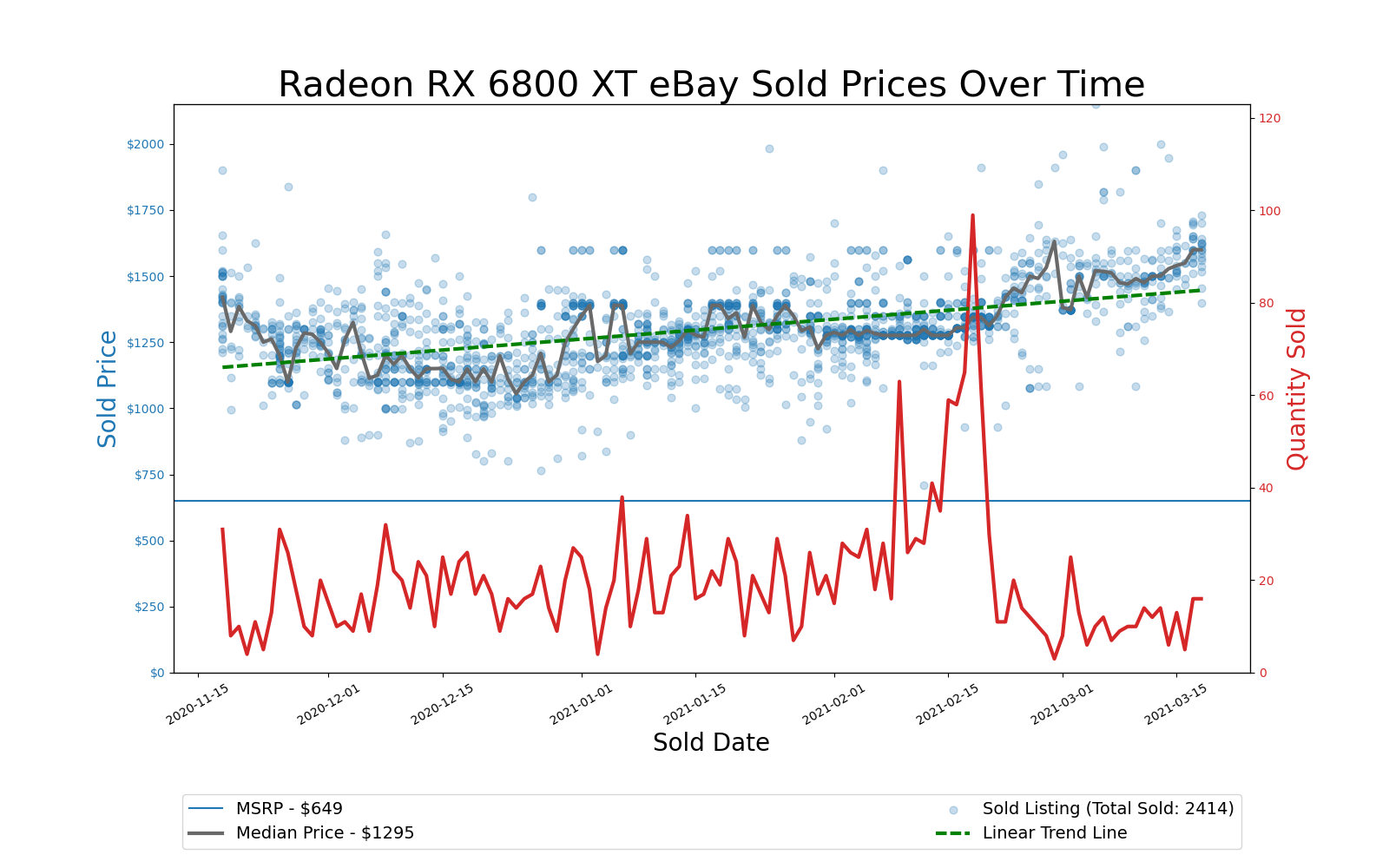


Turing and RDNA1 Graphics Cards

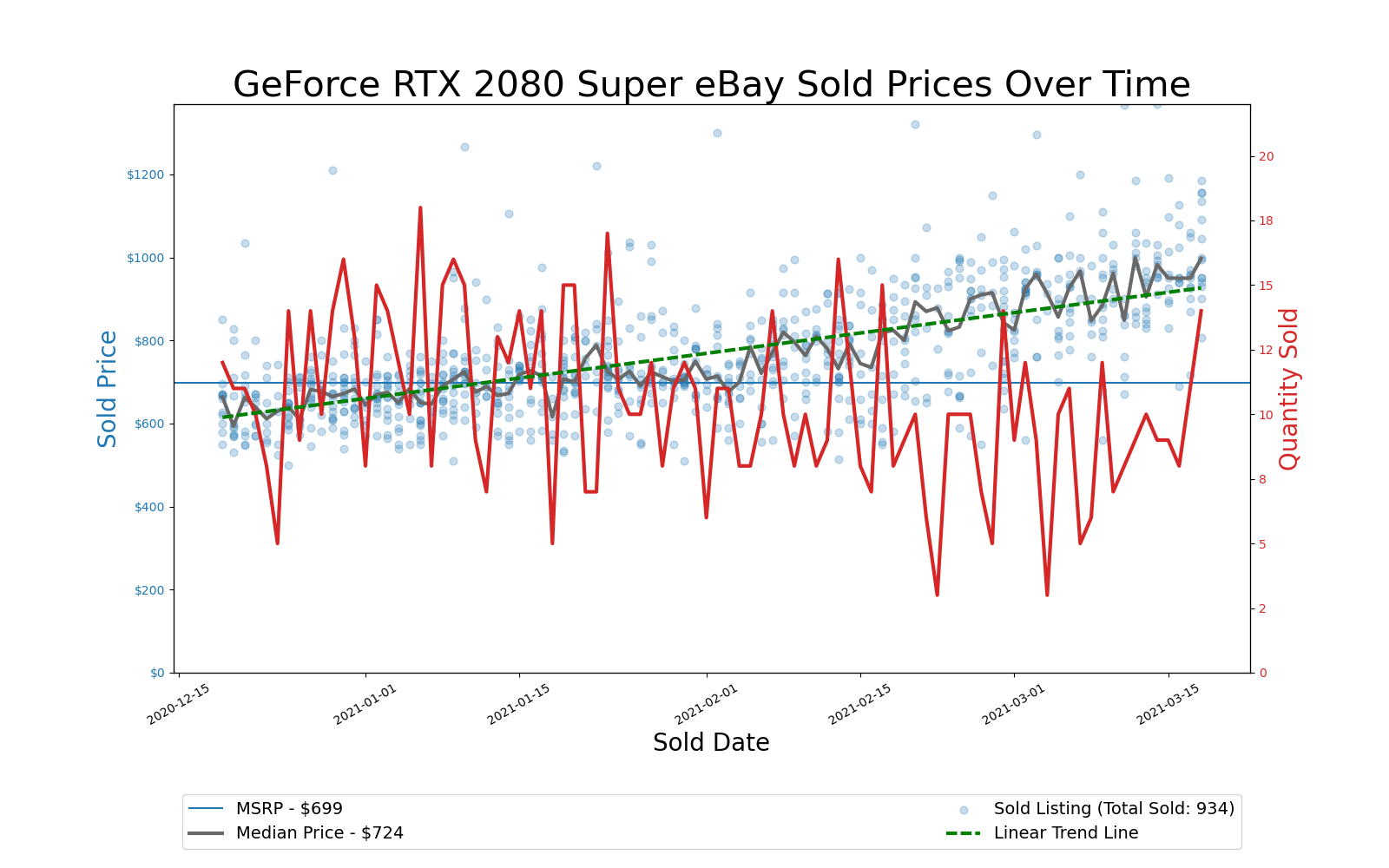

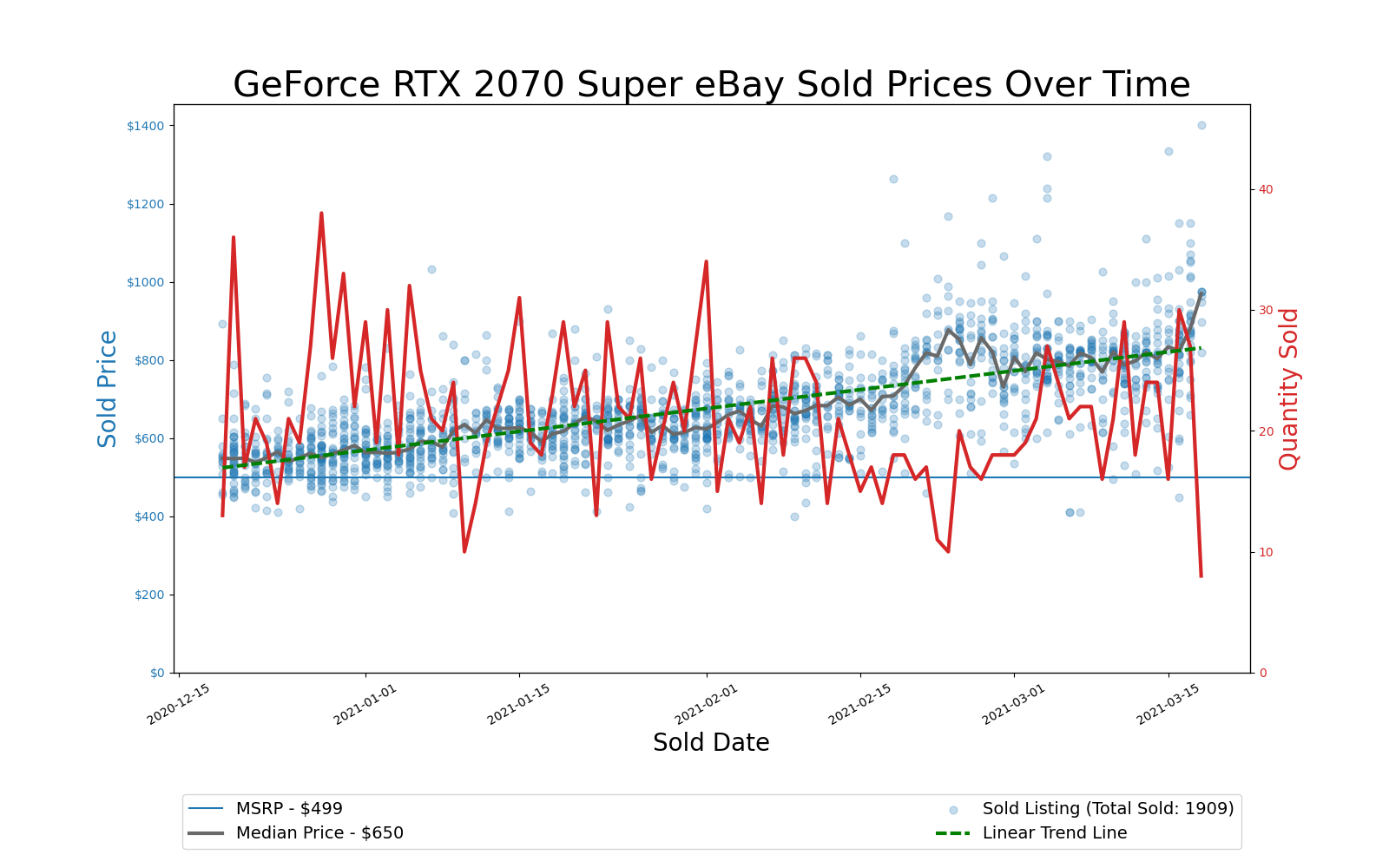













Pascal, Vega, and Polaris Graphics Cards
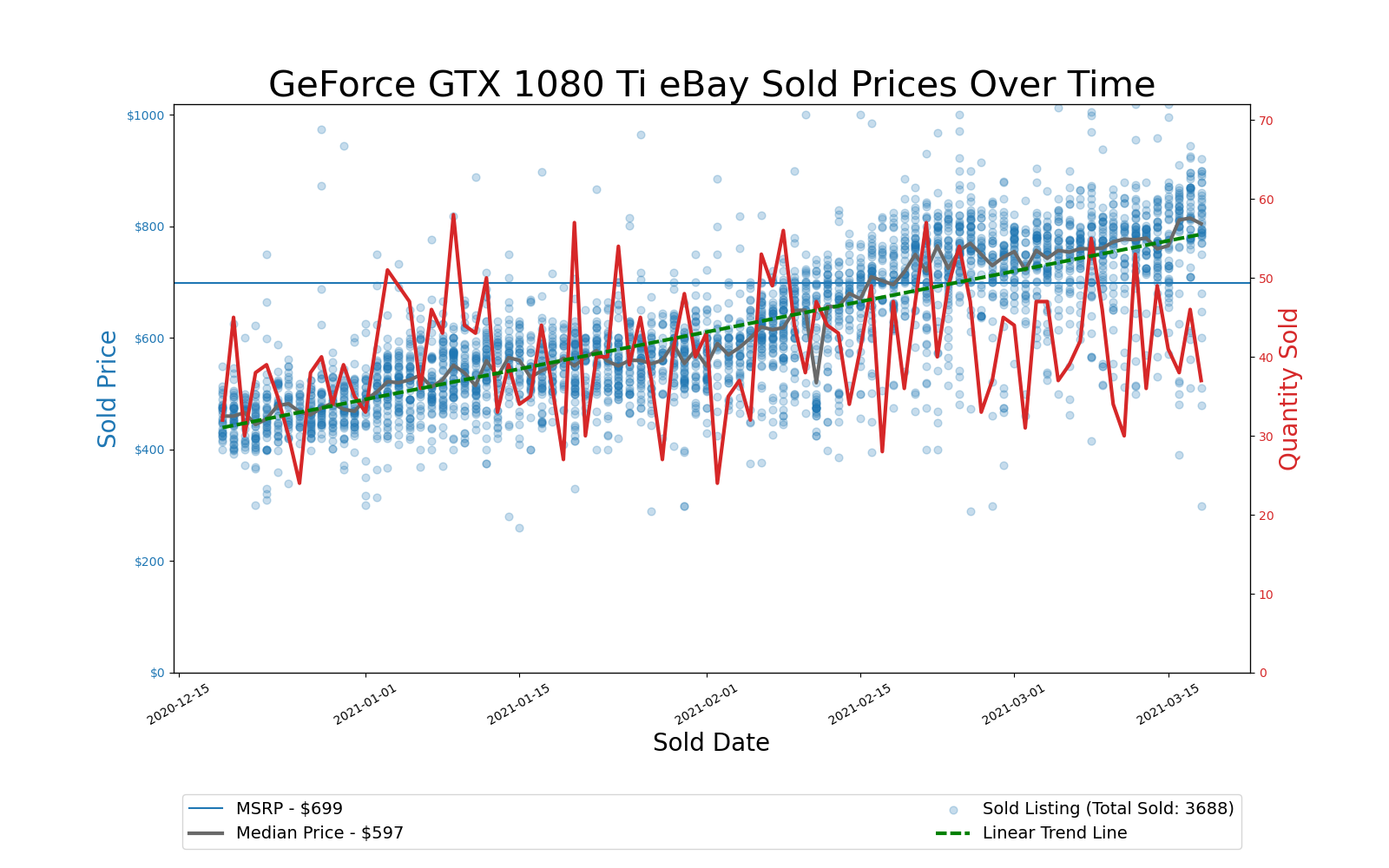









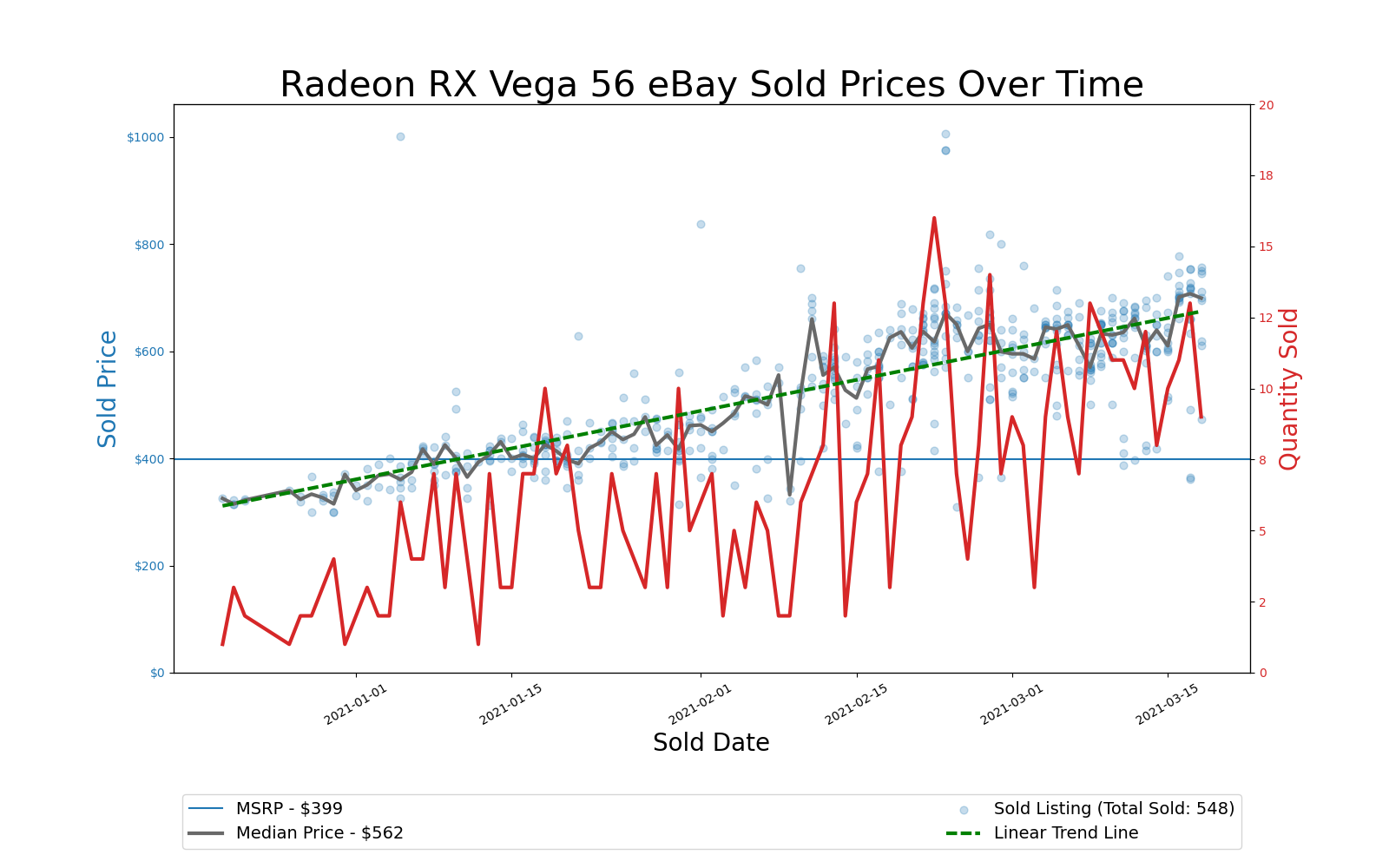


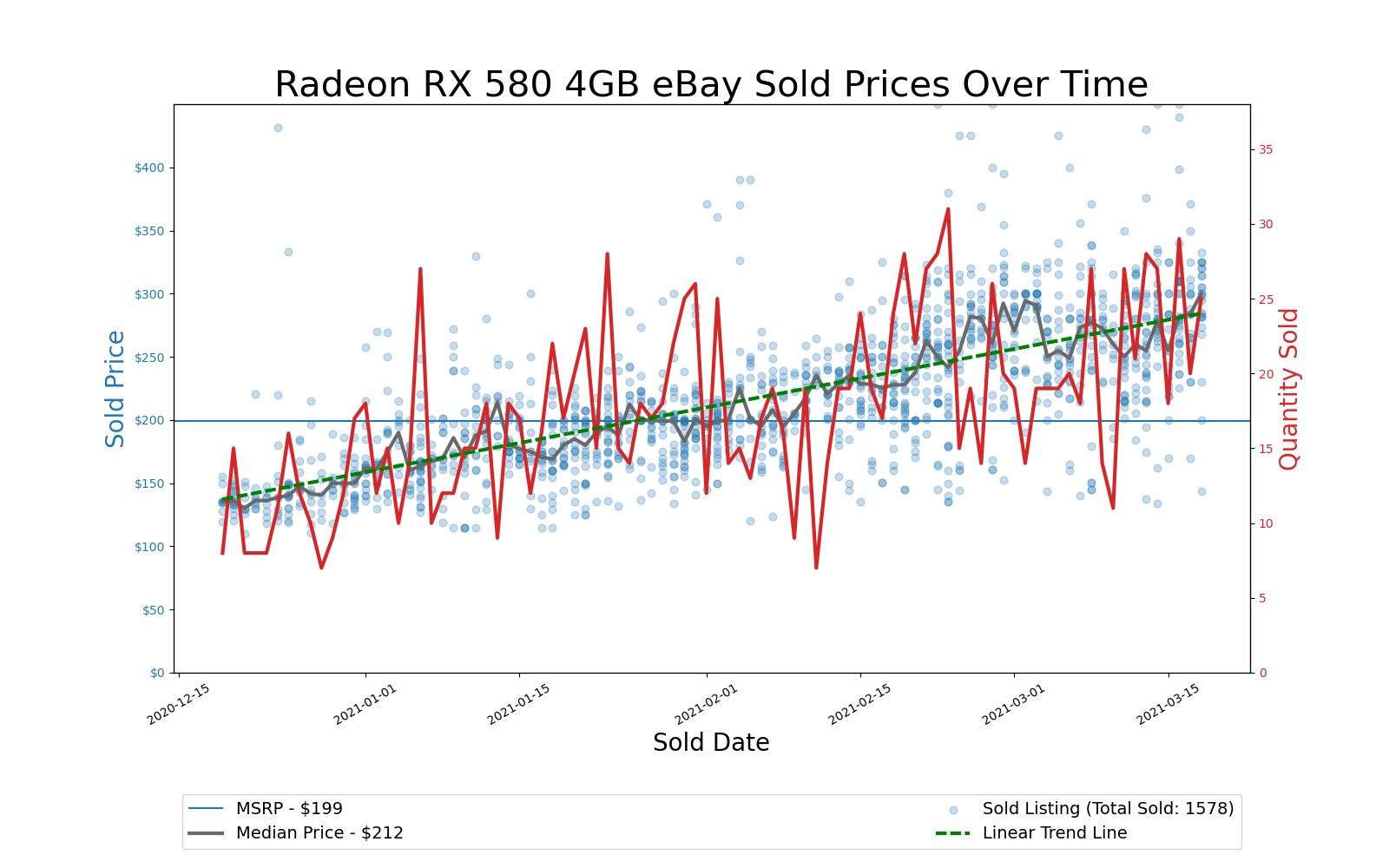

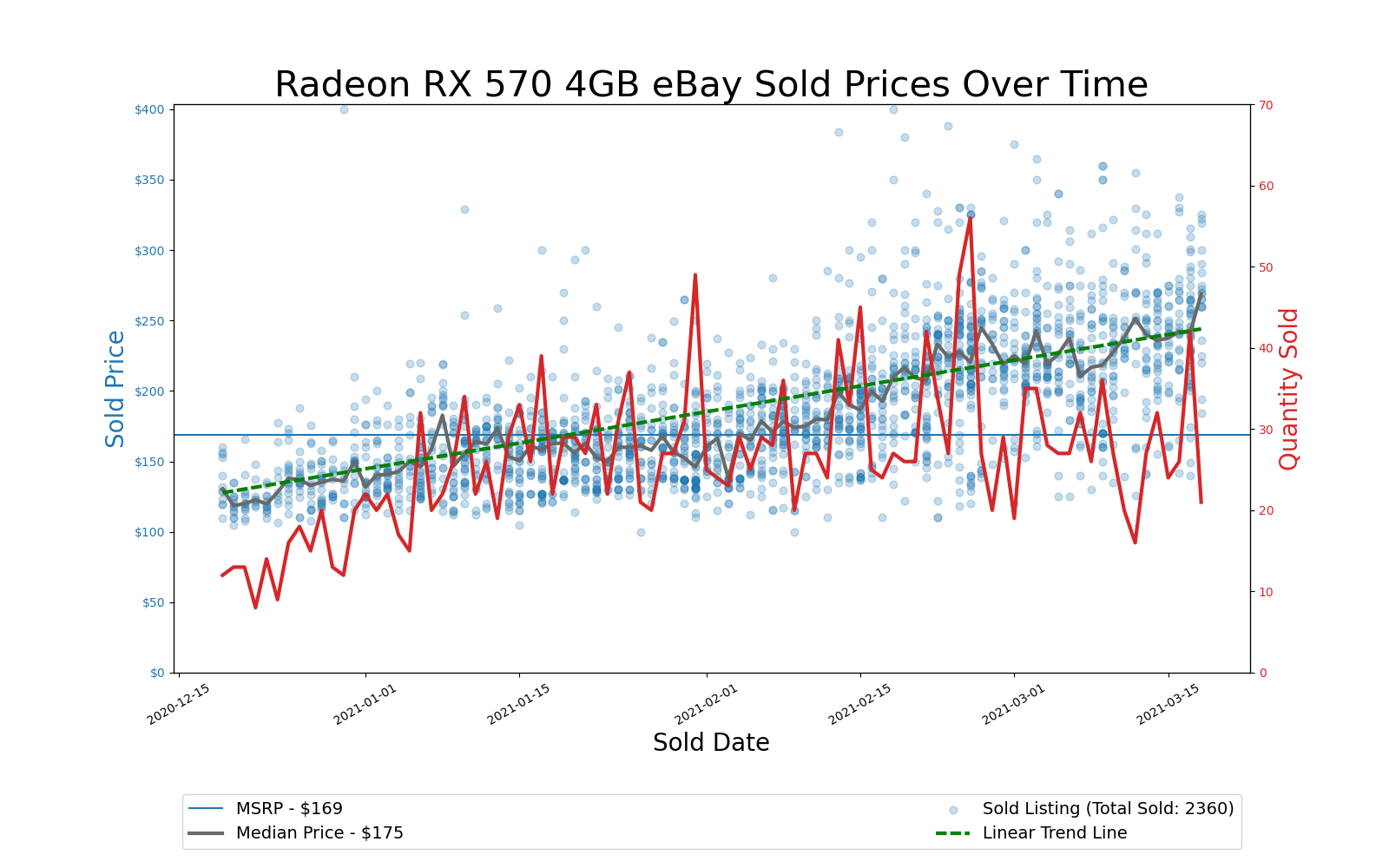






Legacy GPUs and Titans (and Consoles!)




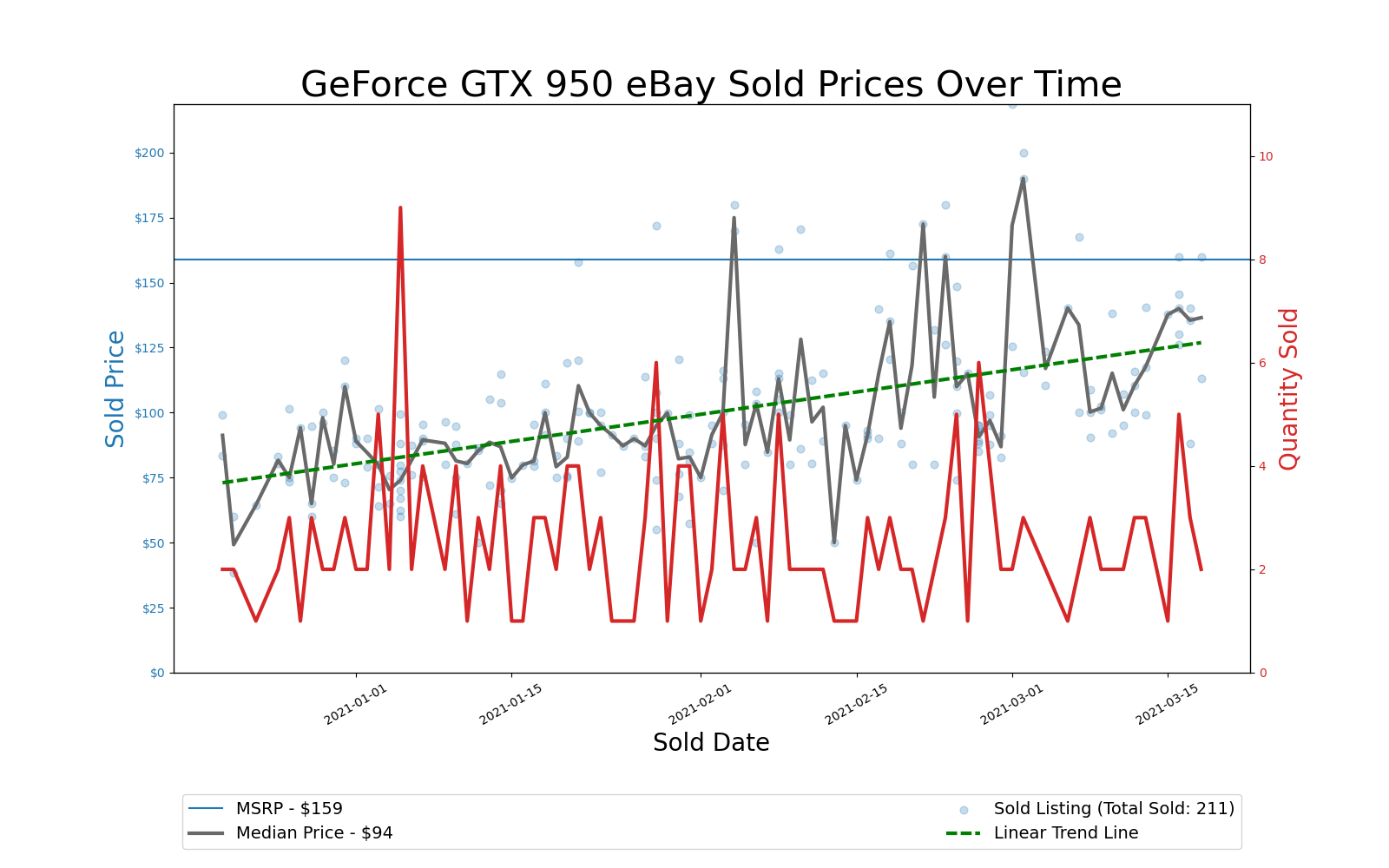










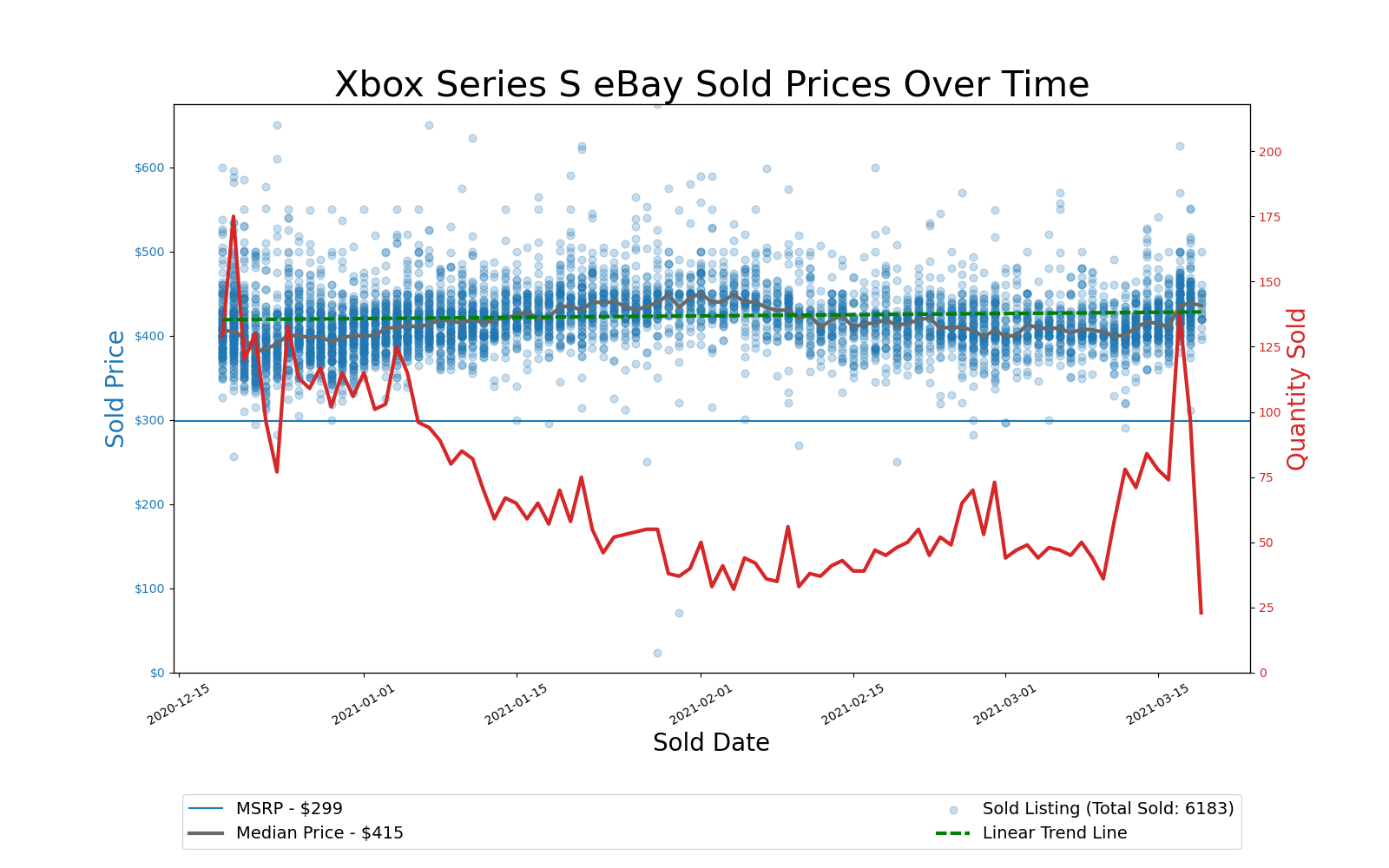


So, there you have it: Every GPU we looked at shot up in prices over the past 90 days — which is even worse when you consider many of the GPUs were already overpriced from the previous 90 days.
There's some good news, maybe: As recent pricing increased on the Ampere and RDNA2 graphics cards, the number of GPUs sold on eBay dropped off. Perhaps there just aren't as many cards being sold (on eBay, anyway). Hopefully, it's that fewer people are willing to pay these incredibly inflated prices.
The PlayStation 5 and Xbox Series X/S consoles are also trending down more quickly than GPUs, which makes sense as they can't be used for cryptomining (yet?). Considering the latest gen consoles cost hundreds of dollars less than even the budget RTX 3060 and RX 6700 XT right now, gamers looking to upgrade might be better off going that route — or just keep using what you already have in your PC, and wait for the current mining madness to end.
We also wonder how many cards have been sold on eBay, only to be sold again at higher prices later. Considering eBay takes a healthy cut on each sale, there's no question the company has greatly profited by all of these console and GPU sales.
Mar 11–18, 2021
This is the last week where our eBay scraping functioned properly (using code originally developed by Michael Driscoll, which we modified for our purposes). Mostly, we adjusted the search parameters and tweaked the look of the charts.
Here are the charts for Mar 11–18, 2021. We've gathered data on 62 different GPUs, which we'll organize into groups based on the GPU generations.
Ampere and RDNA2 Graphics Cards

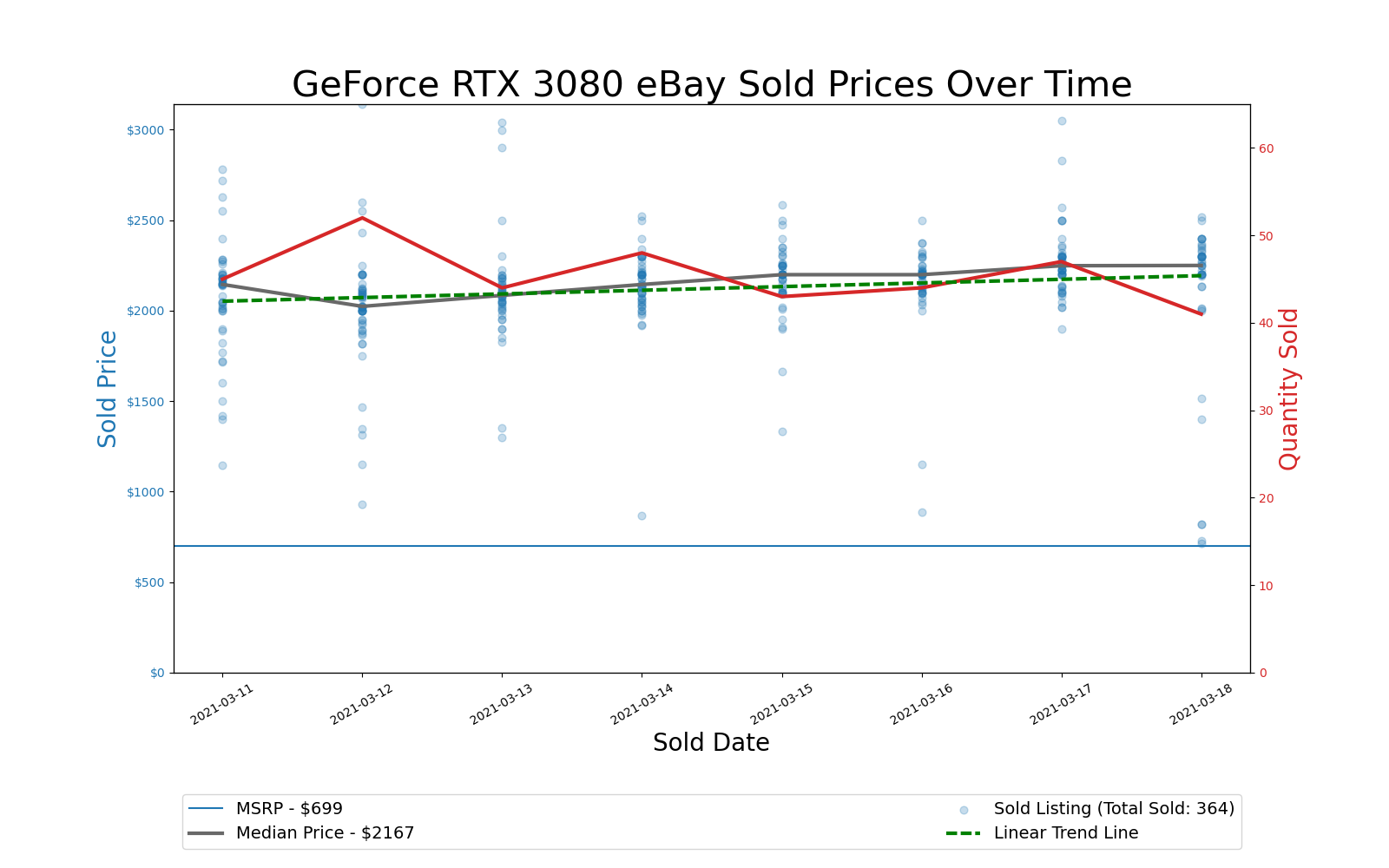

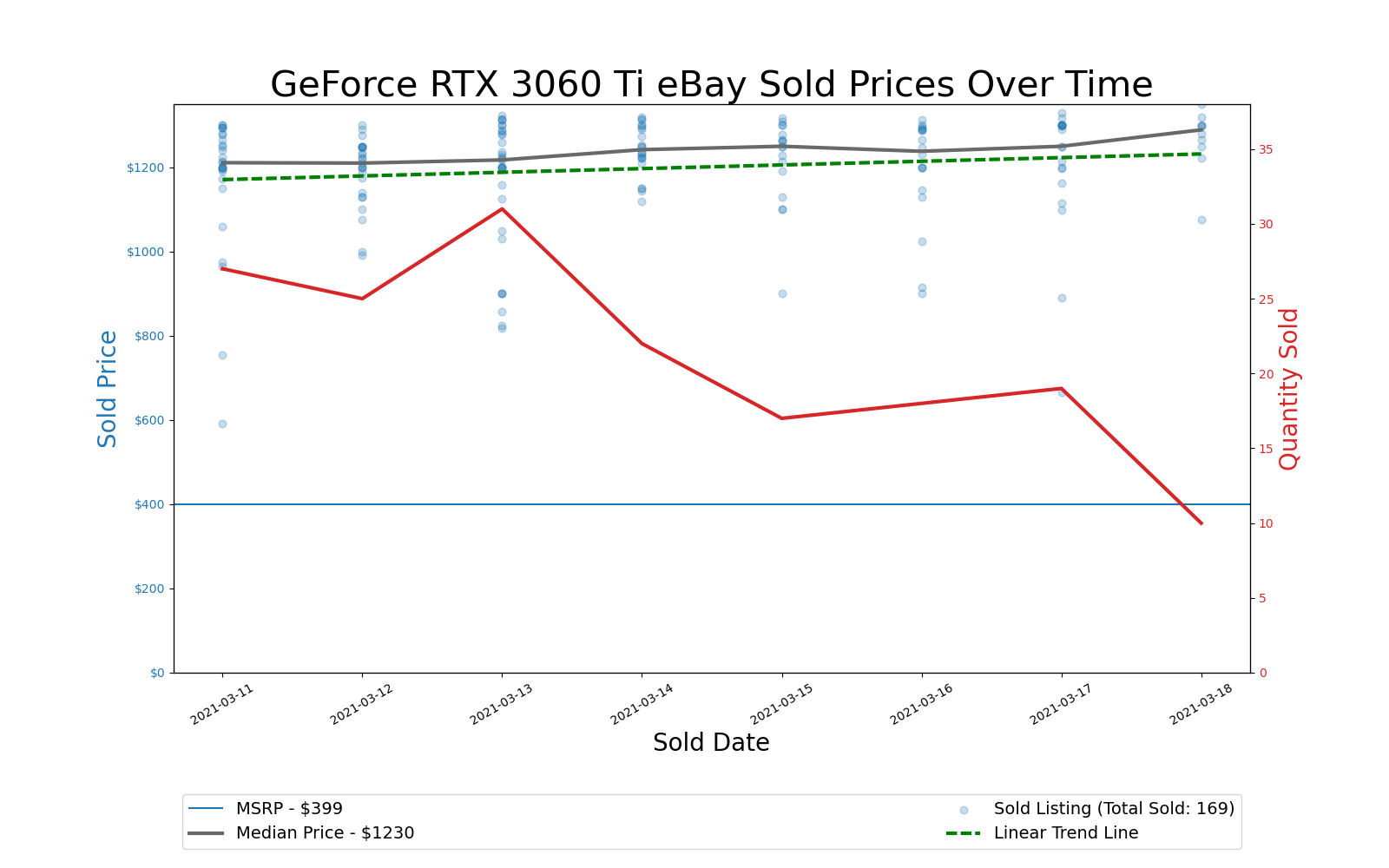





The latest generation graphics cards from AMD and Nvidia see the most demand, and every Ampere and RDNA2 card saw slightly higher prices during the past week. That's likely thanks to Bitcoin reaching a new all-time high of over $61,000 on March 13, and while prices dropped a bit after that spike, it's still up 3% over the past week. Ethereum saw a similar jump in price, but it wasn't able to eclipse it's previous high of $2,030, peaking at around $1,930.
In total, nearly 2,000 Nvidia Ampere graphics cards traded hands on eBay last week (1,984 by our count). That's a bit less than the previous week (2,085), though the time of day when we collect the data likely accounts for some of that. AMD's numbers are quite a bit lower, with 260 RDNA2 cards sold in total. That's up from the 188 sold the previous week, and the 13 RX 6700 XT units only had a small impact. We'll have to see if the 6700 XT picks up next week, though at these prices it's hard to imagine there are many buyers.
Of course, we're only able to pull data from eBay's public listings. While we suspect the relative proportion of AMD to Nvidia sales at retail is similar, there's certainly a wider margin of error. With ever major site still showing every recent GPU as out of stock or backordered, though, every GPU produced continues to get snapped up by a voracious market.
Turing and RDNA1 Graphics Cards

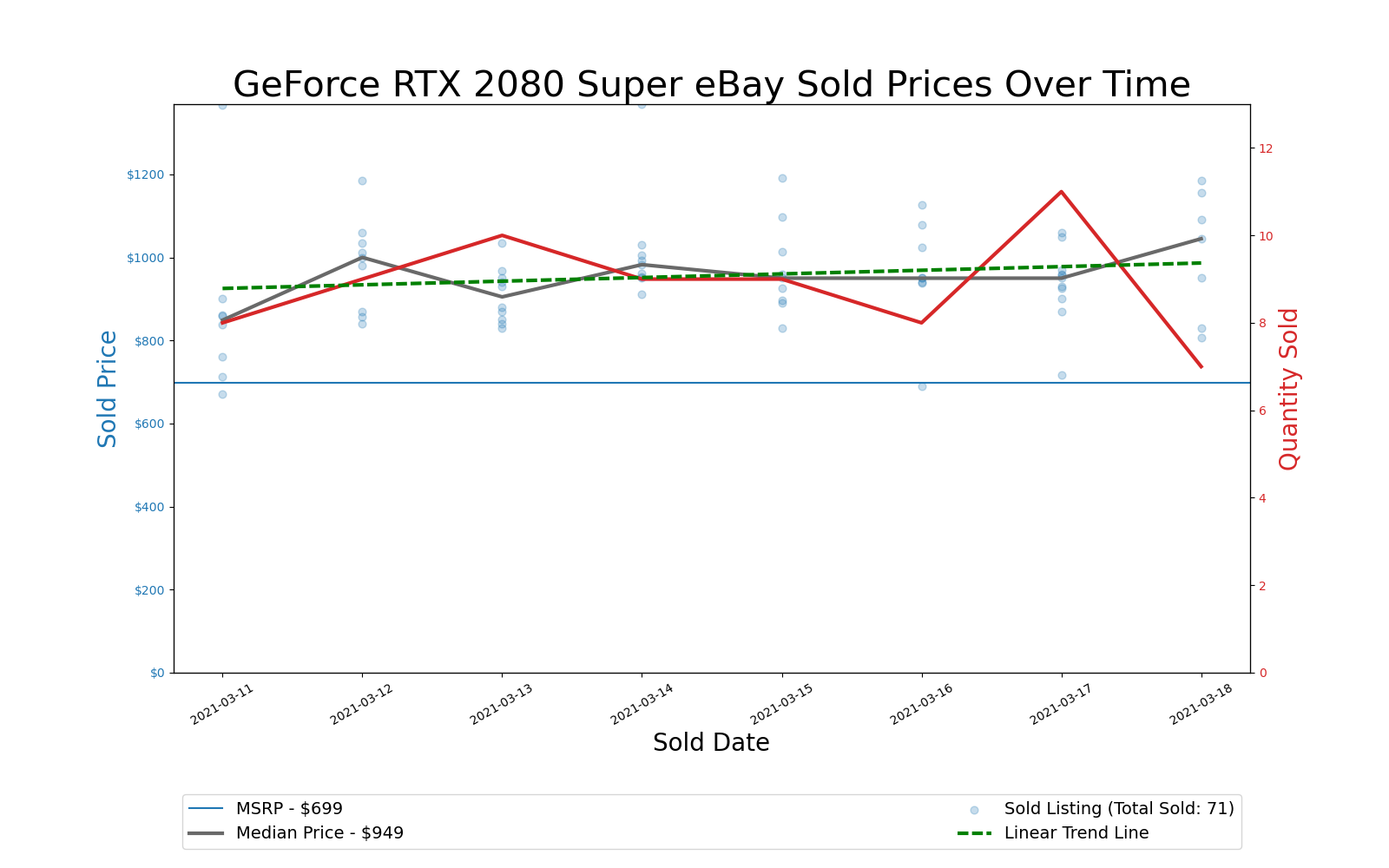
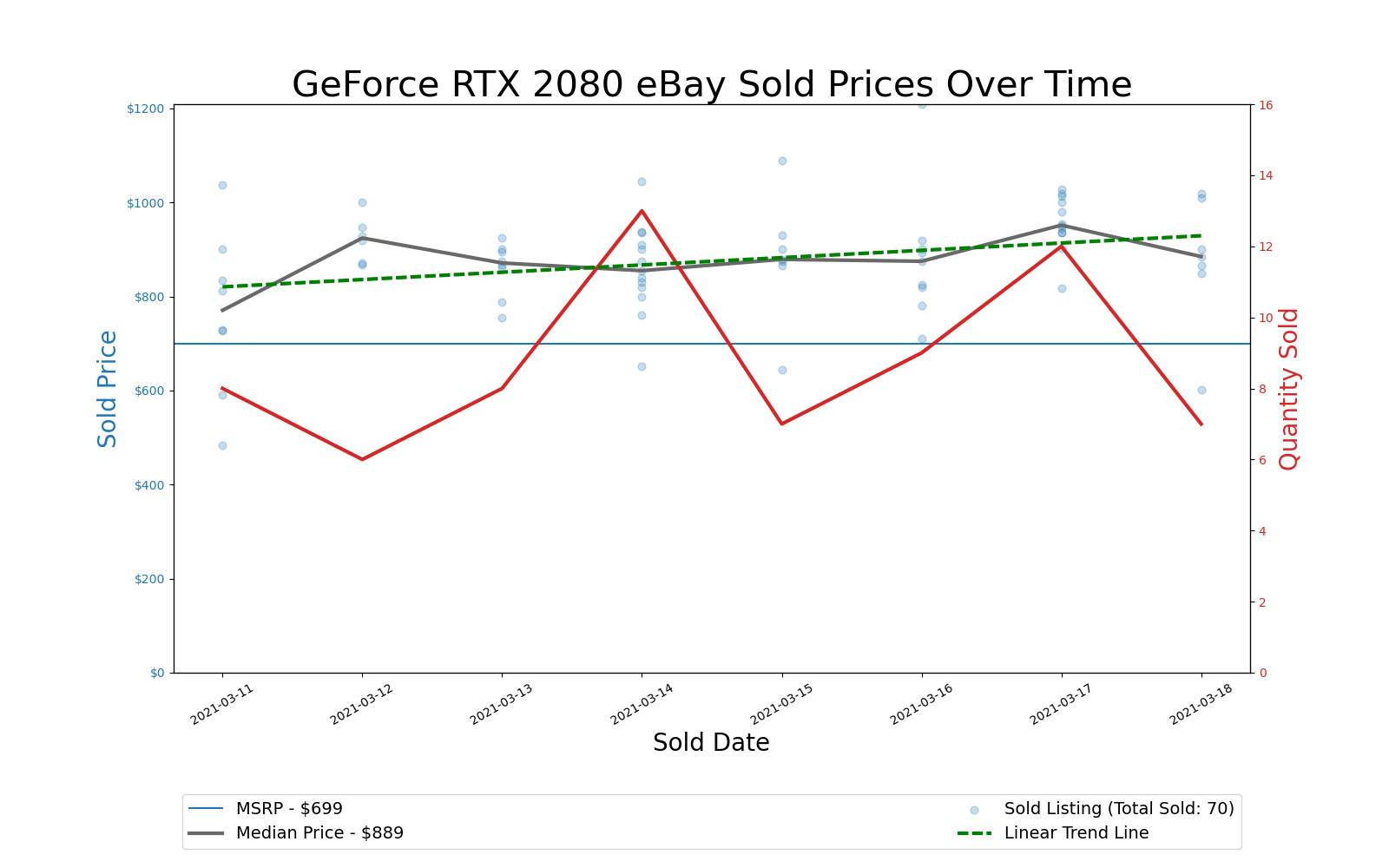




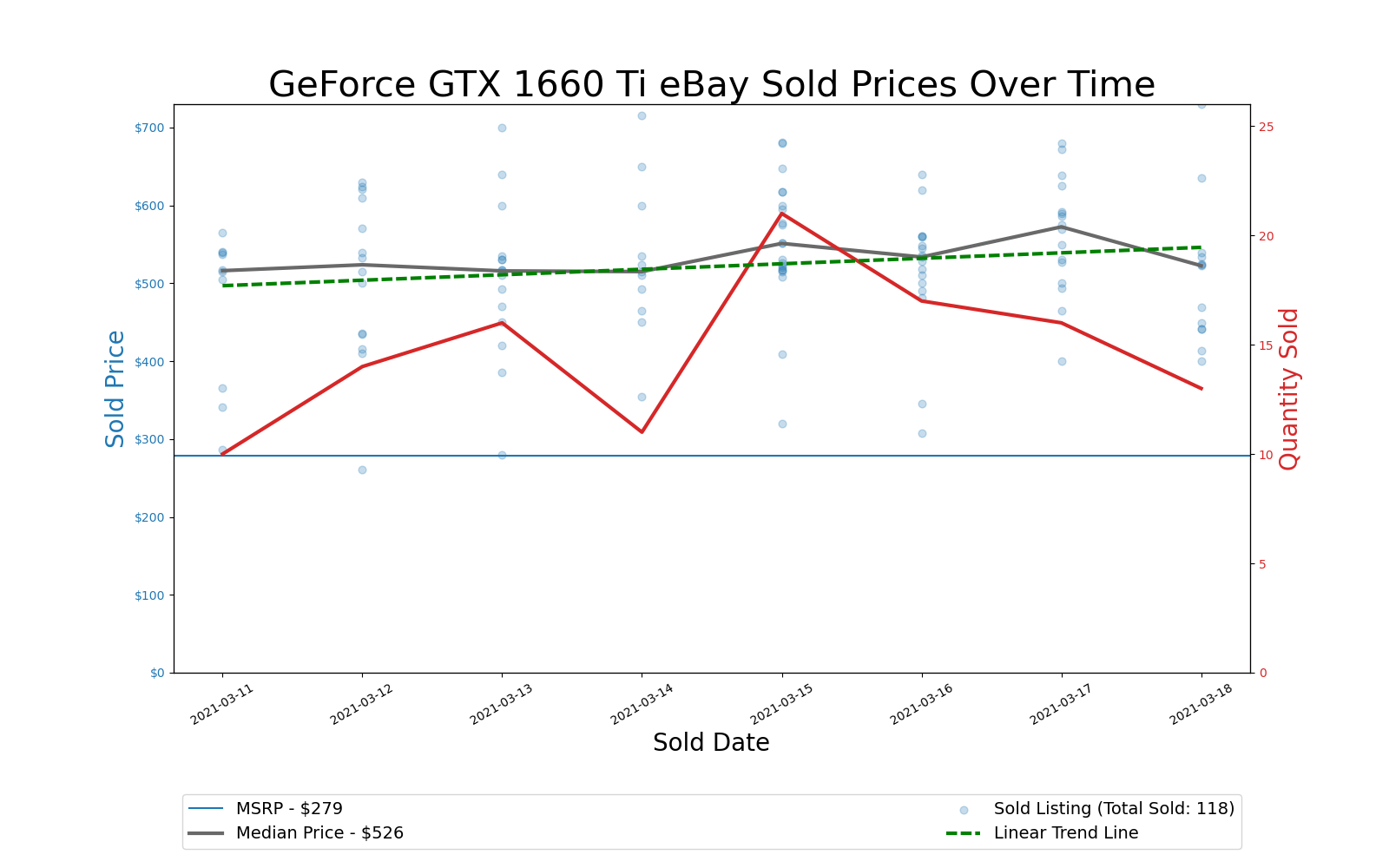



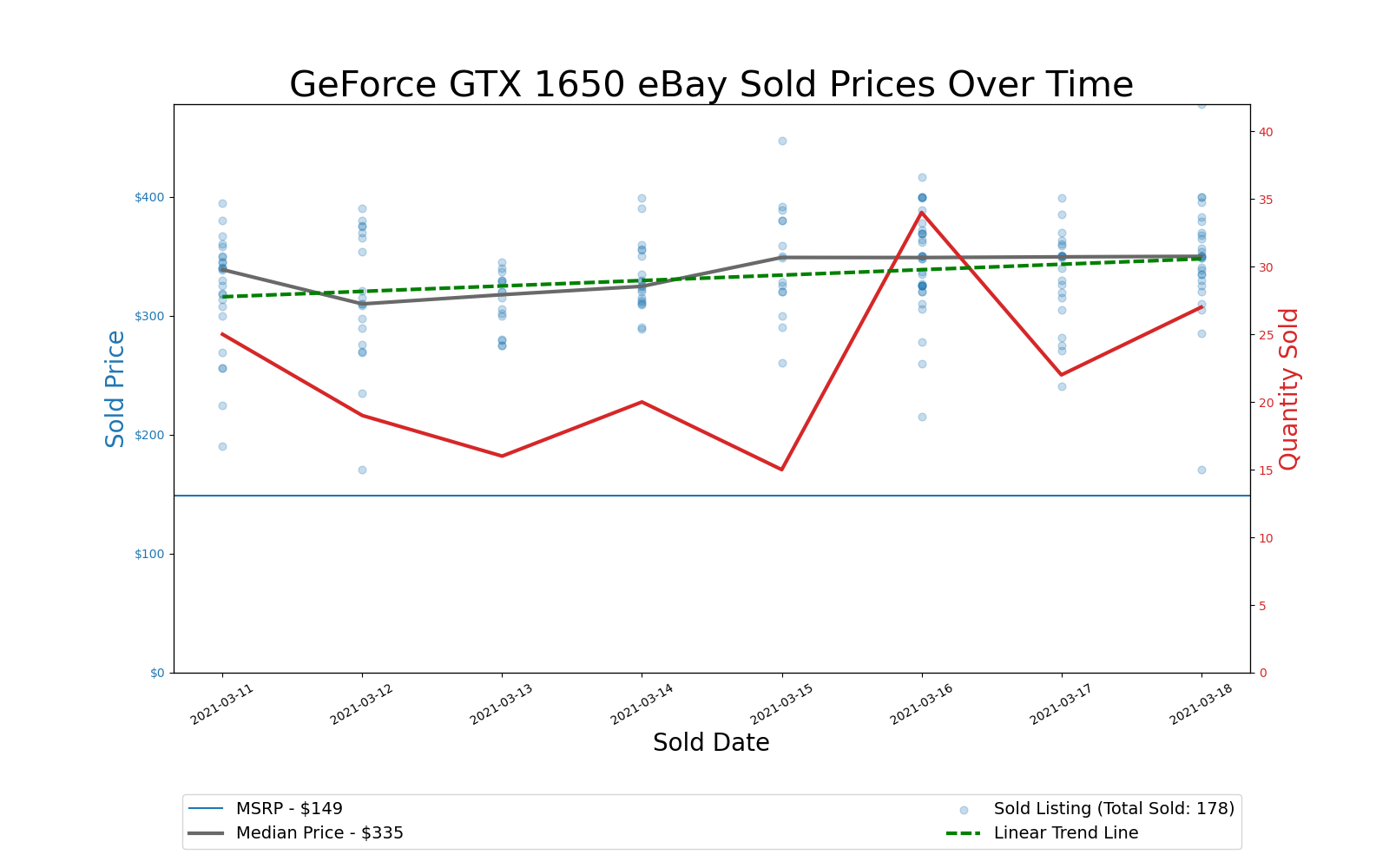




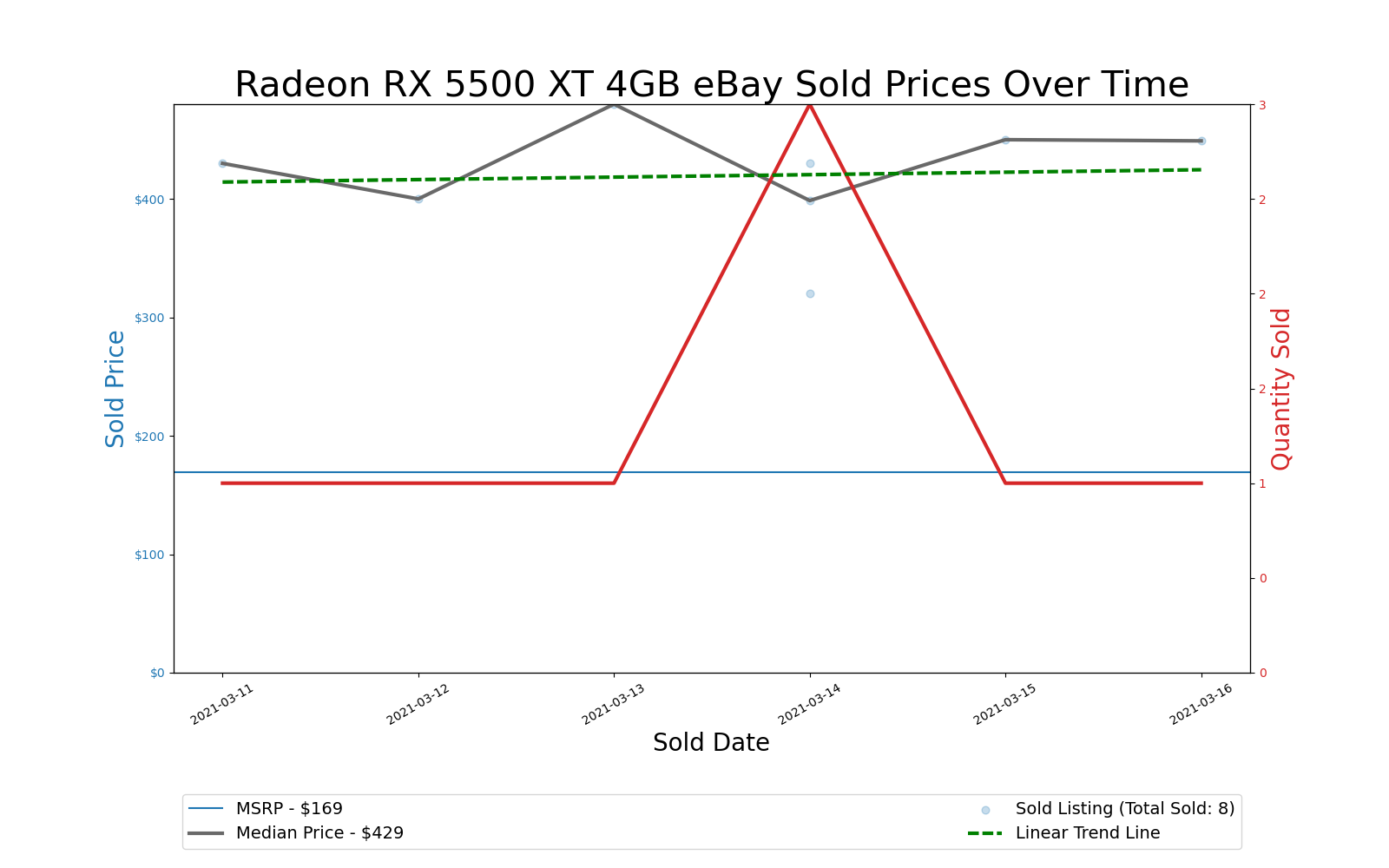
The previous generation Turing and RDNA1 cards tell a similar tale. Three showed a minor downward trend in eBay pricing, but all of the Turing cards combined only accounted for about 1,500 units sold. AMD's previous generation Navi GPUs on the other hand continue to outsell the RX 6000 models by around a 2:1 ratio, with 537 cards sold. About two thirds of those are RX 5700 XT models.
One interesting piece of information is that AMD's RDNA1 cards are often nearly as fast as RDNA2, as Ethereum mostly depends on memory bandwidth. The newer cards have a slight advantage, as their GDDR6 comes clocked at 16Gbps (and overclocks to 17.2Gbps), while the earlier models only did 14Gbps at stock. But RX 5700 XT can do 55MH/s vs. the RX 6800 XT's 64MH/s, so it's little surprise that miners are happy to take either card.
You might also wonder about the increase in pricing on cards with 4GB of VRAM. Ethereum mining isn't possible (at profitable rates, at least) on cards with less than 6GB VRAM. However, other hashing algorithms continue to work okay. Kawpaw for example can still net around $1 per day from the 5500 XT 4GB. That's a lot less than the 5500 XT 8GB's nearly $3 per day, but apparently not low enough to stop the miners.
Pascal, Vega, and Polaris Graphics Cards
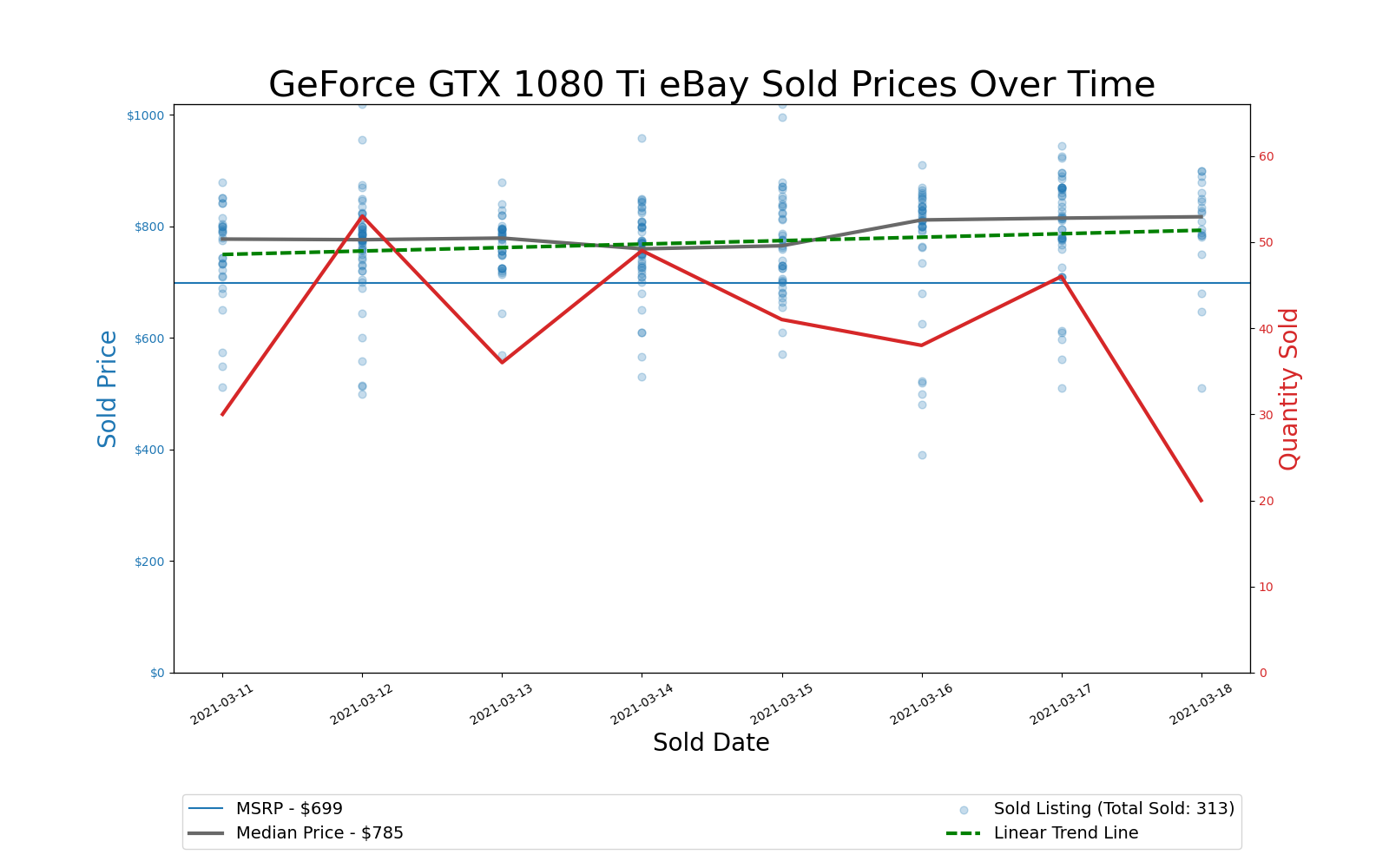









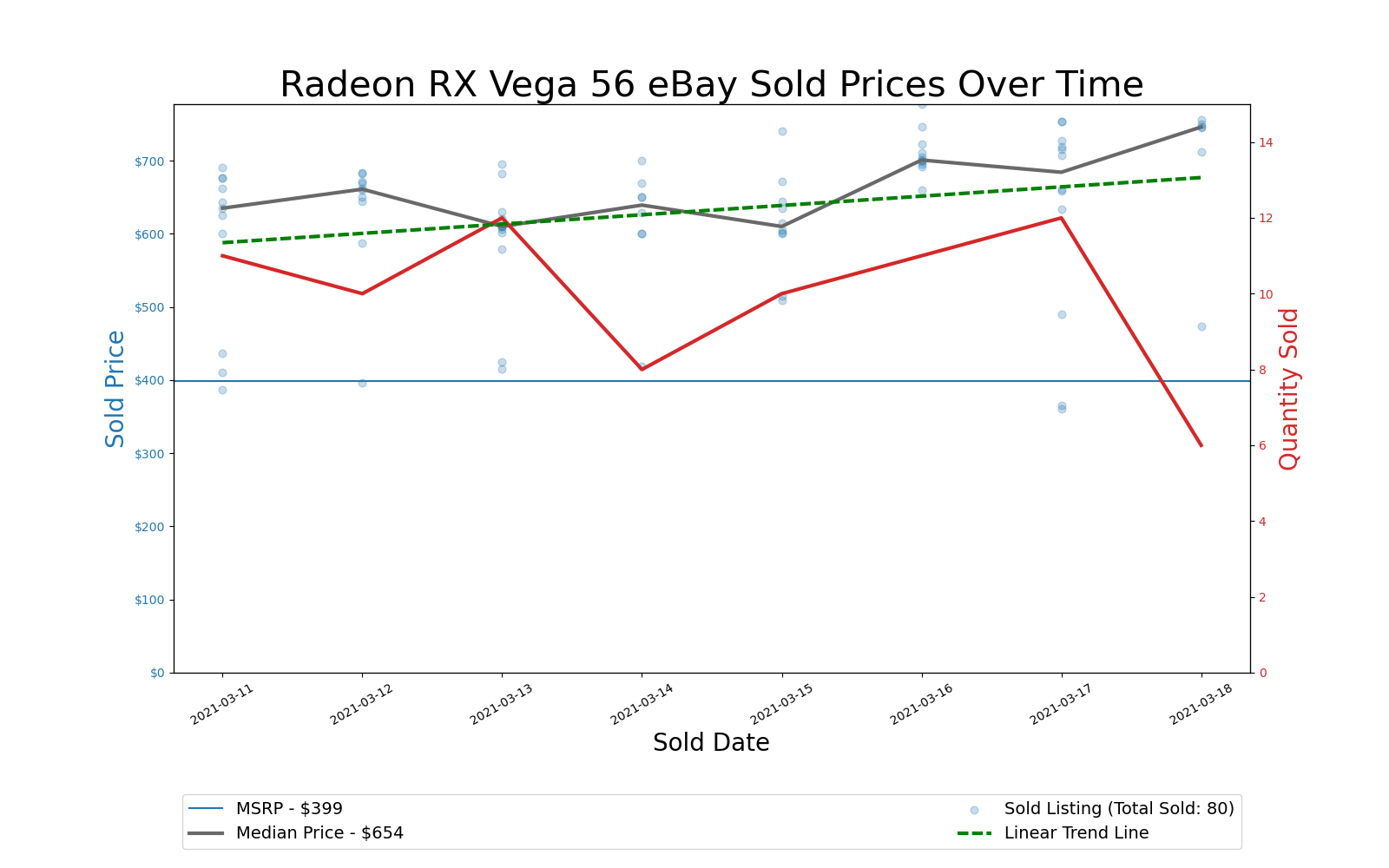









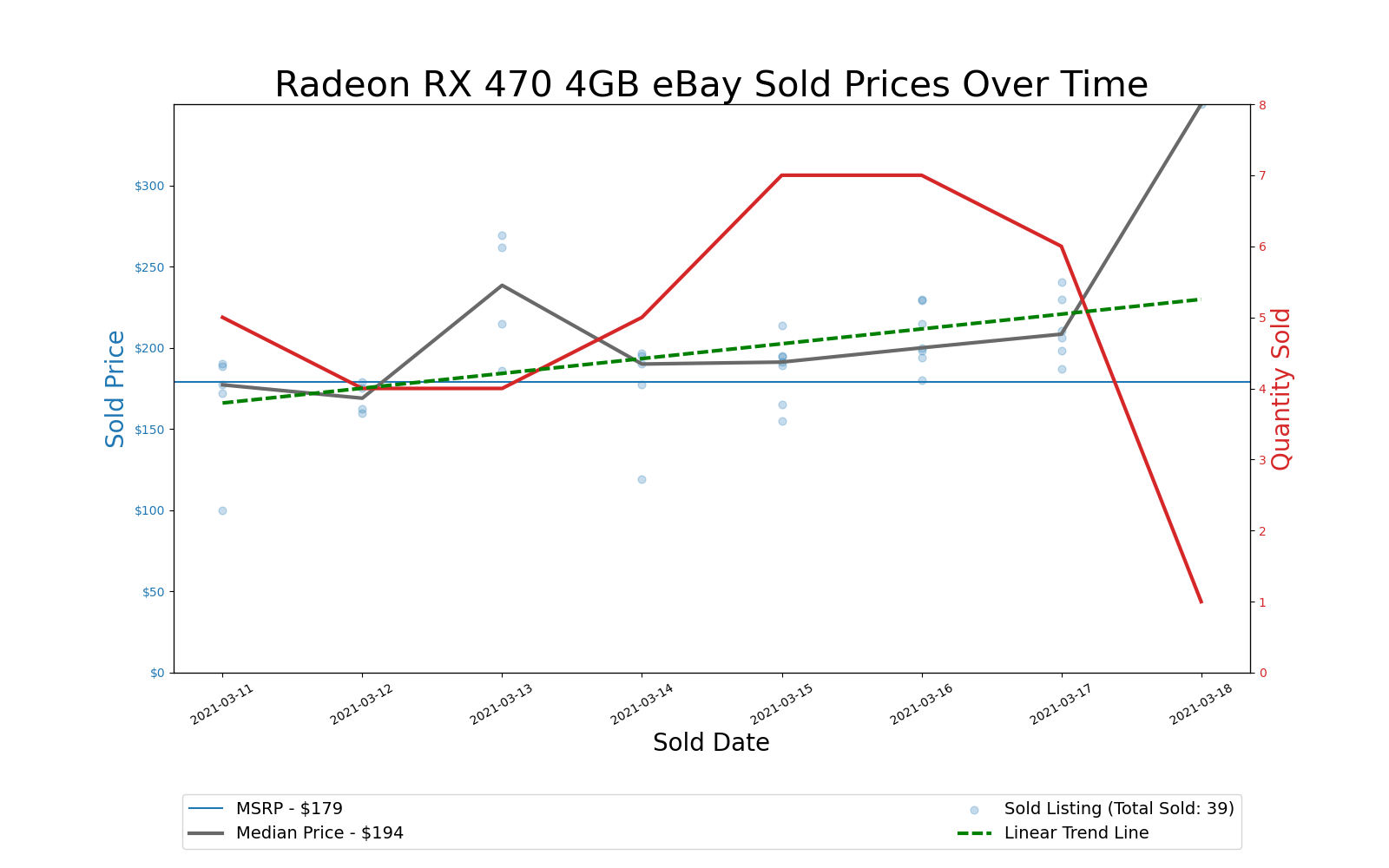

Even cards that mostly launched three or four years back remain in high demand. Normally, cards this old would cost less than half their launch prices. Or at least, that's about how much most gamers would be willing to pay. Pascal and Polaris GPUs might not be as fast as Ampere, Navi, and Turing for mining purposes, but they're still fast enough to turn a profit.
The exception (sort of) is cards with only 2GB or 3GB, like the GTX 1050 and 1060 3GB. While it's still possible to net about $0.75 per day after power costs with mining, most miners prefer going after higher performance models — connecting six or eight low-end cards to one PC takes some effort, so it's better to pay a bit more for higher performance parts.
If you just need a graphics card that can run games at modest settings, meaning 1080p medium or high, these old GPUs are your best bet right now. You're still looking at $200–$250, on eBay, but maybe you can find one for closer to $150 if you shop around.
Legacy GPUs and Titans








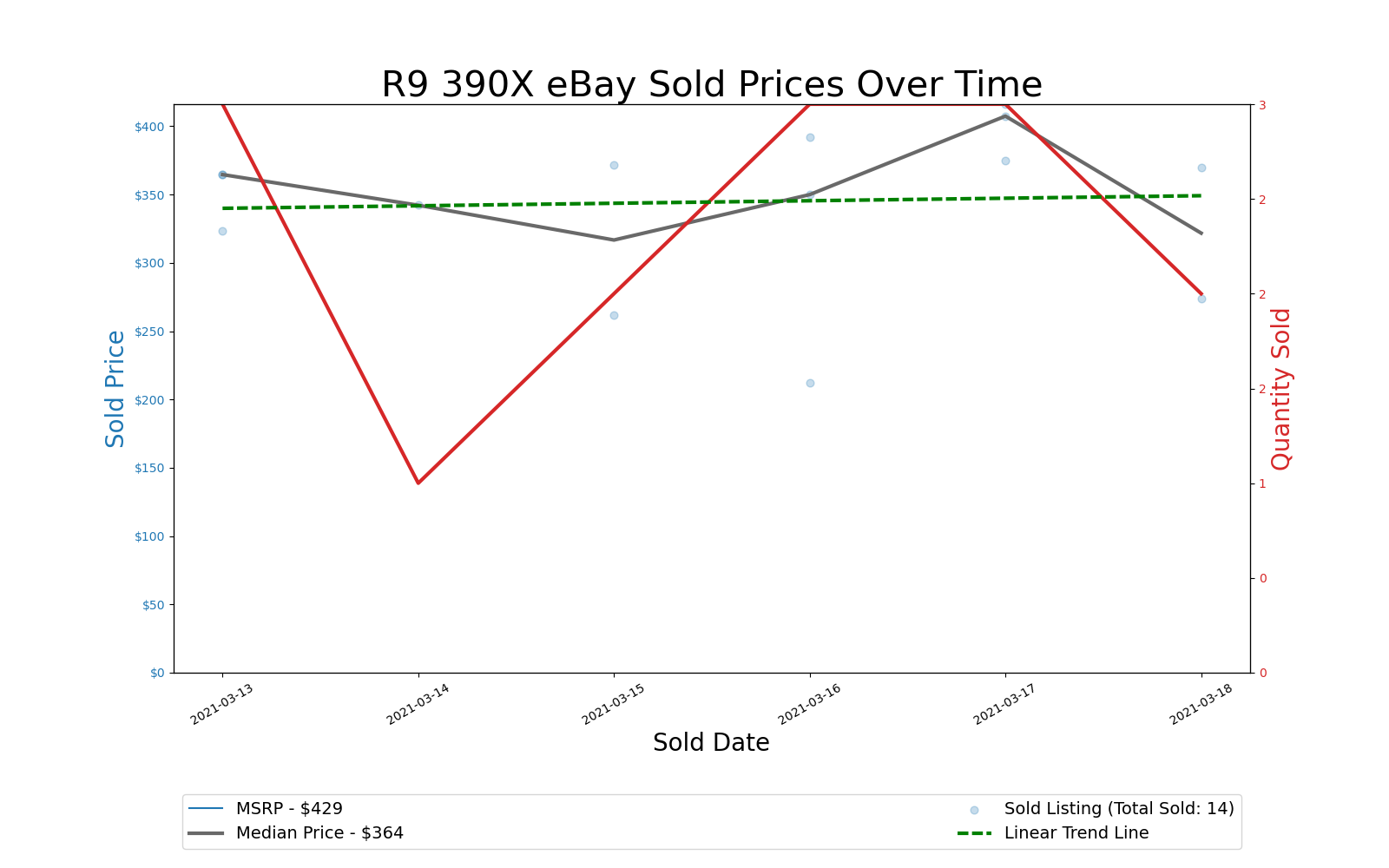

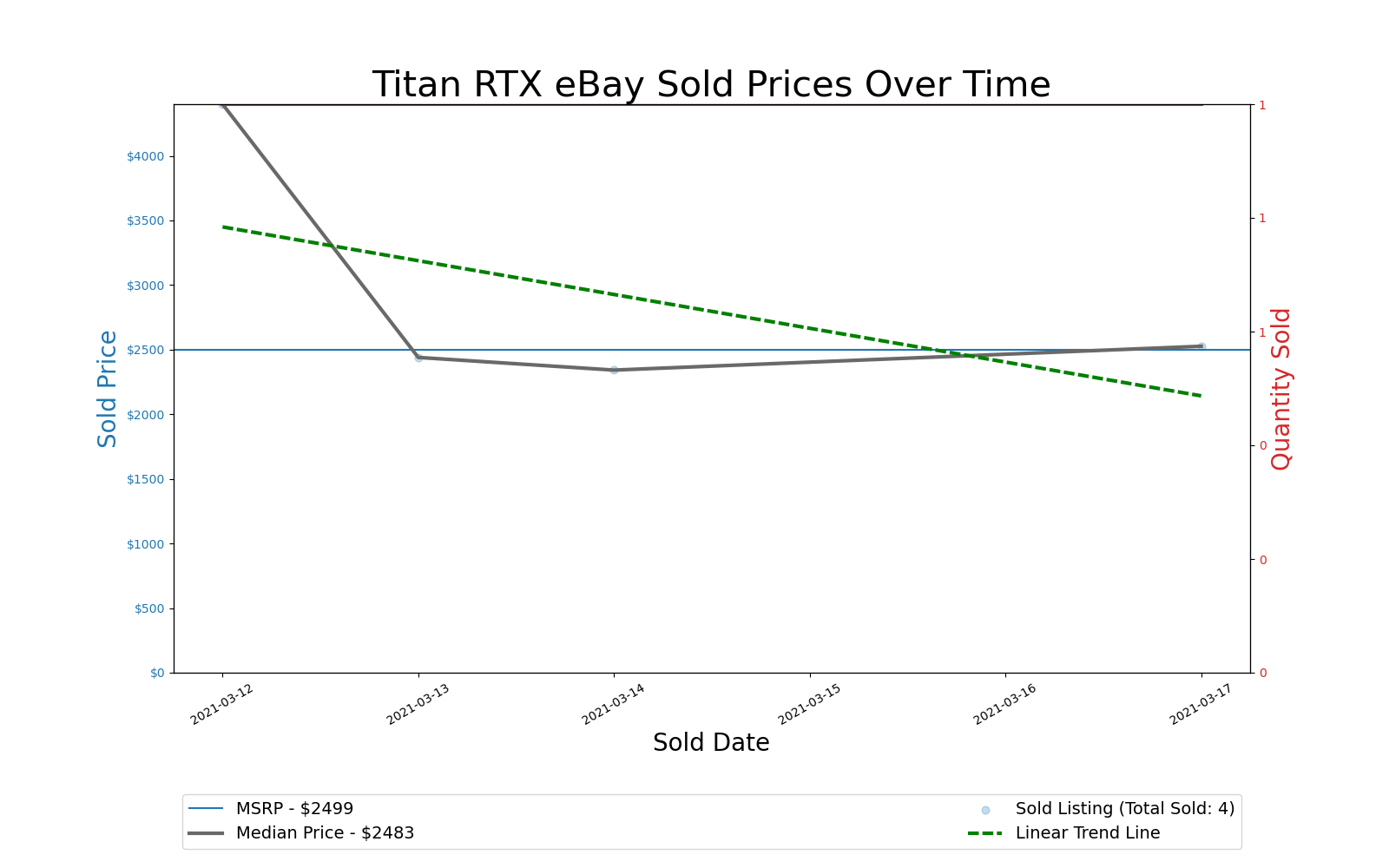



Even relatively ancient GPUs continue to cost a lot. Sure, it's only $350 or so for a GTX 980 Ti, which is about as fast as a GTX 1070, and at least the cards cost less than their original MSRPs. You can still play most games just fine on these GPUs as well, provided you turn down the settings and resolution. But paying $200 for a card that used to cost $300 and launched over six years back just hurts.
We've also included Nvidia's four most recent Titan cards for reference. Not surprisingly, there aren't many of these being sold, and prices are still higher than otherwise similarly performance GeForce models.
Weekly Summary: More Turbulence Ahead

While GPU prices on eBay remained relatively stable, the continued impact of mining profitability means there's no end in sight right now. Just when you start to think maybe the whole house of digital cards is ready to collapse, there was another jump in Bitcoin prices. It's not hard to see where the HODL mentality comes from, but at some point things will stabilize and return to something closer to 'normal.'
When will that happen? It's almost impossible to say, but certainly not before the supply issues get fixed, which means probably not until 2022 at least. GPU prices will almost certainly come down before then, but the lingering effects of the COVID-19 pandemic haven't cleared up.
Ethereum mining difficulty continues to go up, which means lower profits per GPU. Last week, Ethereum was at 5521 TH and this week it's at 5731 TH, so about 3.8% less coins for a given set of hardware. Even though you can only directly mine Bitcoin with ASICs, it's still possible to earn Bitcoin via GPU mining with services like NiceHash, which means it continues to impact demand for GPUs. Bitcoin doesn't adjust difficulty as often (about once every two weeks), and the last change on March 5 actually showed a drop of 1.3%. We'll have to see what happens during the next adjustment this coming week.
Here are the charts for Mar 4–11, 2021. We've gathered data on 61 different GPUs, which we'll organize into groups based on the GPU generations.
Ampere and RDNA2 Graphics Cards




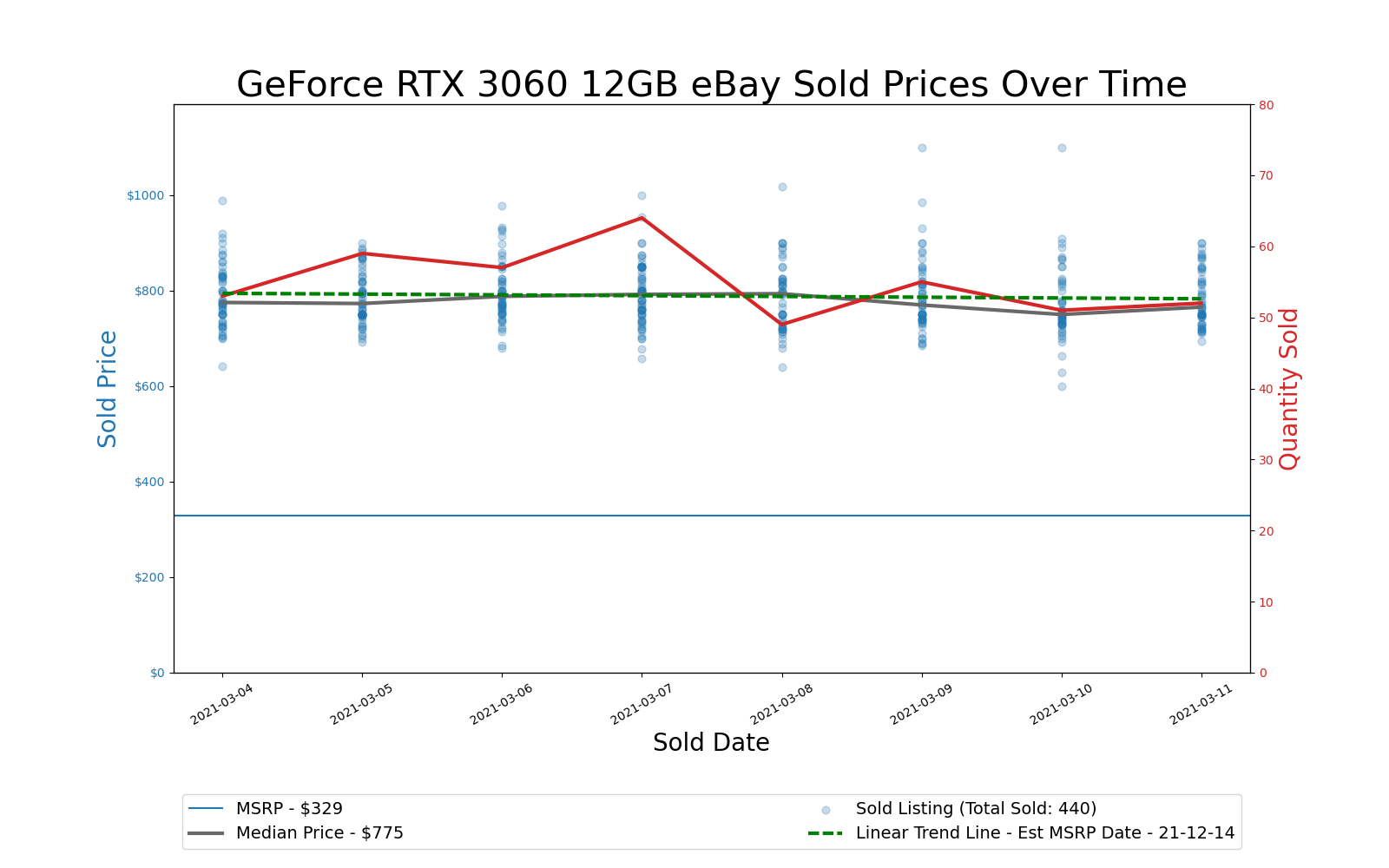



The latest generation graphics cards from AMD and Nvidia see the most demand, from gamers and miners alike. More people want the 'best' option available, and shiny new hardware tends to meet that requirement more than dusty cards from yesteryear. With retail supplies still limited, everything continues to sell for far above the official launch prices.
Not much has changed here, and after a slight downward trend a week ago, several of the cards went back up in average eBay pricing. RTX 3090, 3080, and 3060 Ti show the steepest upward slopes, while the new RTX 3060 12GB and AMD RDNA2 cards are all headed in the right direction (down) — but they're not getting back to MSRP any time soon.
Total numbers of each GPU sold (on eBay) continue to strongly favor Ampere over RDNA2, and the RTX 3060 12GB at comes in as the second most popular card in this group. Interestingly, RTX 3090 actual outsold RTX 3080 for a change, as well as the RTX 3060 Ti. Also, RTX 3090 sold as many units alone as the three RDNA2 cards combined — though retail sales (i.e., not eBay) could be very different.
Turing and RDNA1 Graphics Cards









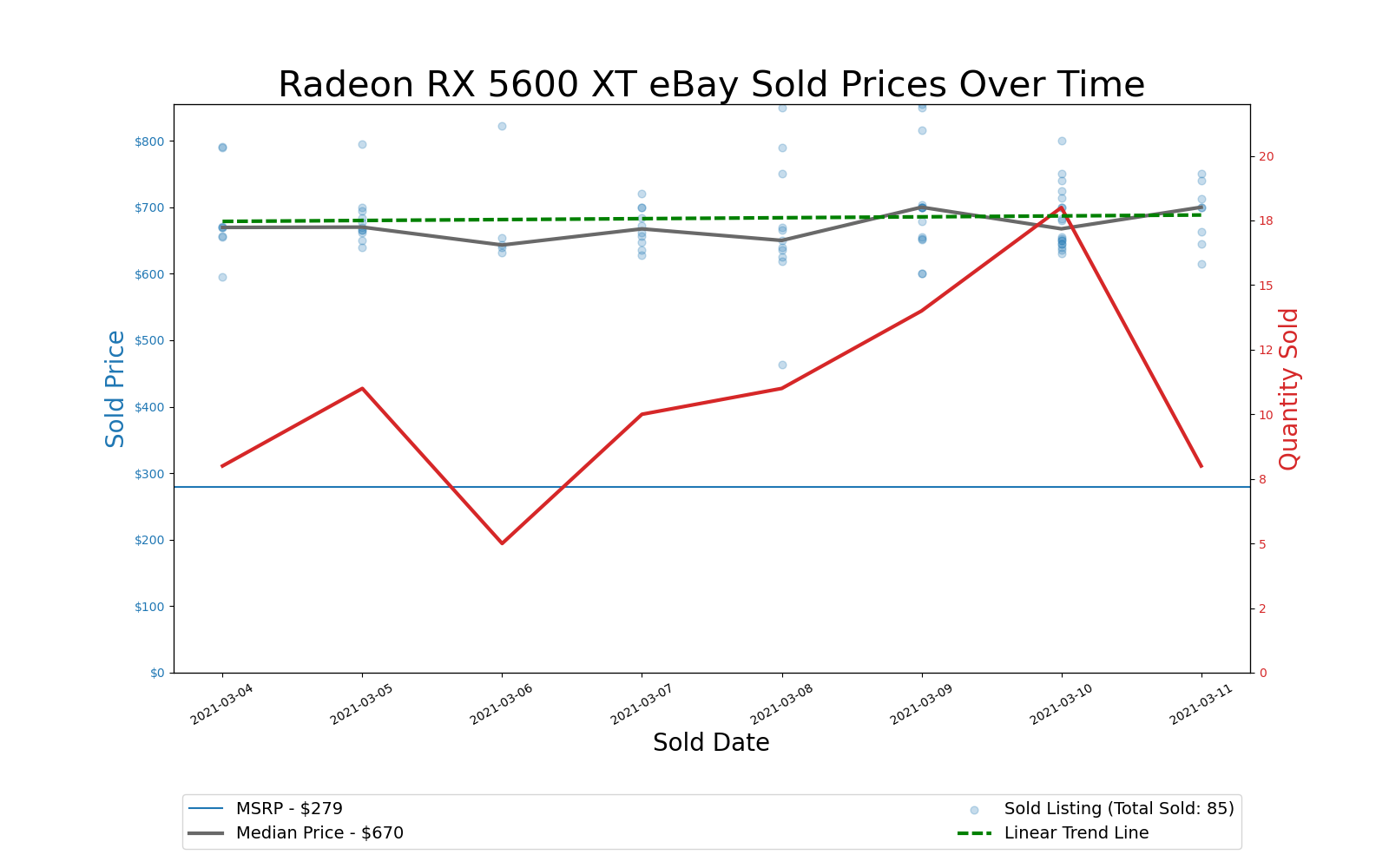







The previous generation Turing and RDNA1 cards are now coming up on two, sometimes three years old. Prices remain severely inflated on these cards, with all of them above their original MSRPs. As above, most cards are showing generally flat pricing trends, with a few exceptions. It's particularly surprising to see the GTX 1650 and 1650 Super — cards with 4GB VRAM that really aren't much good for mining — selling at such high prices.
AMD's RX 5700 XT and RX 5600 XT continue to be popular GPUs. The 5700 XT ranks as the highest selling AMD card, with a massive lead over the RX 5700. We have to assume there just weren't that many vanilla 5700 cards produced, which makes sense considering both use the same Navi 10 die. Those that couldn't make it as a full RX 5700 XT apparently ended up in the RX 5600 XT more often than not, at least in the later days of Navi 10.
Pascal, Vega, and Polaris Graphics Cards



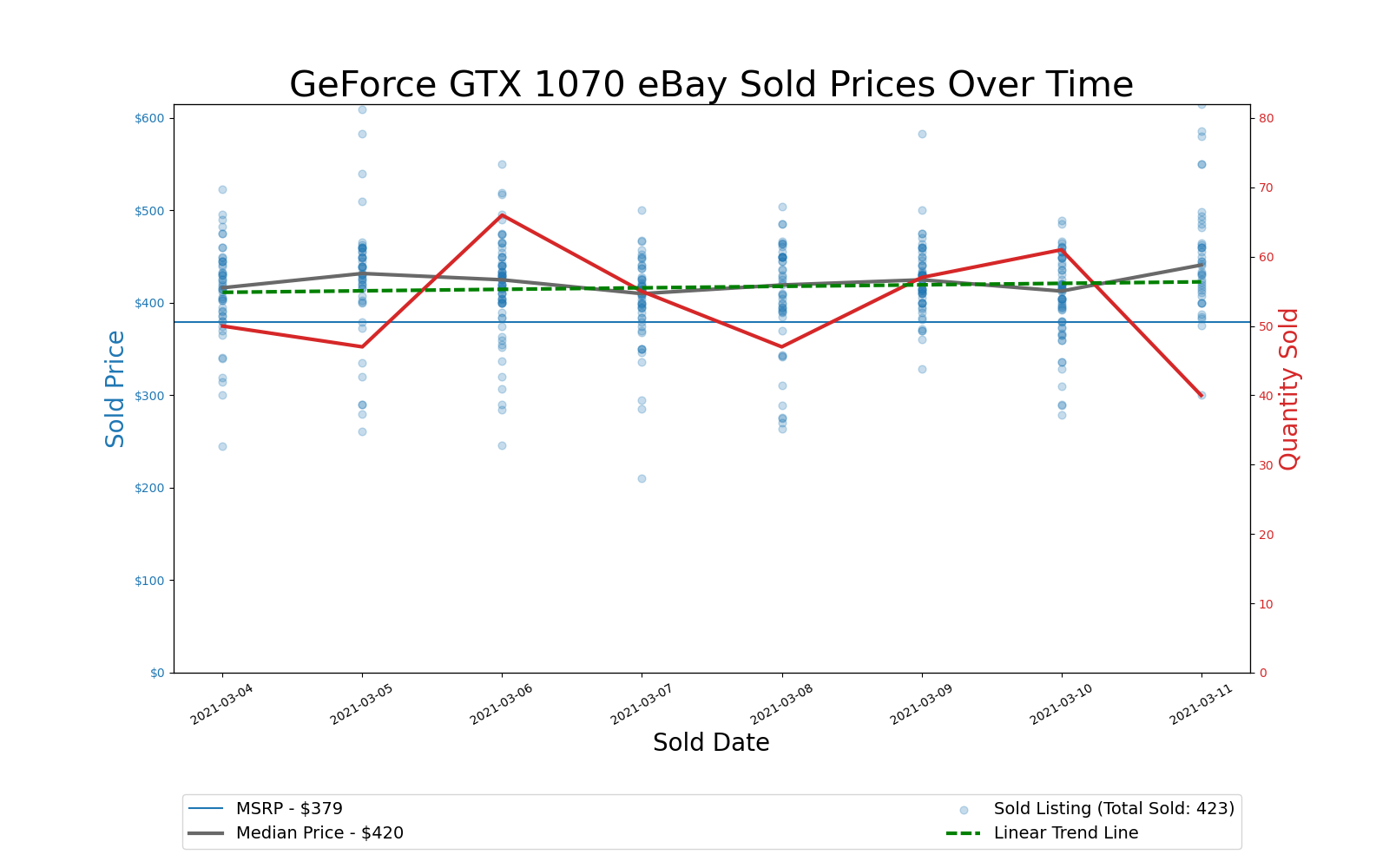


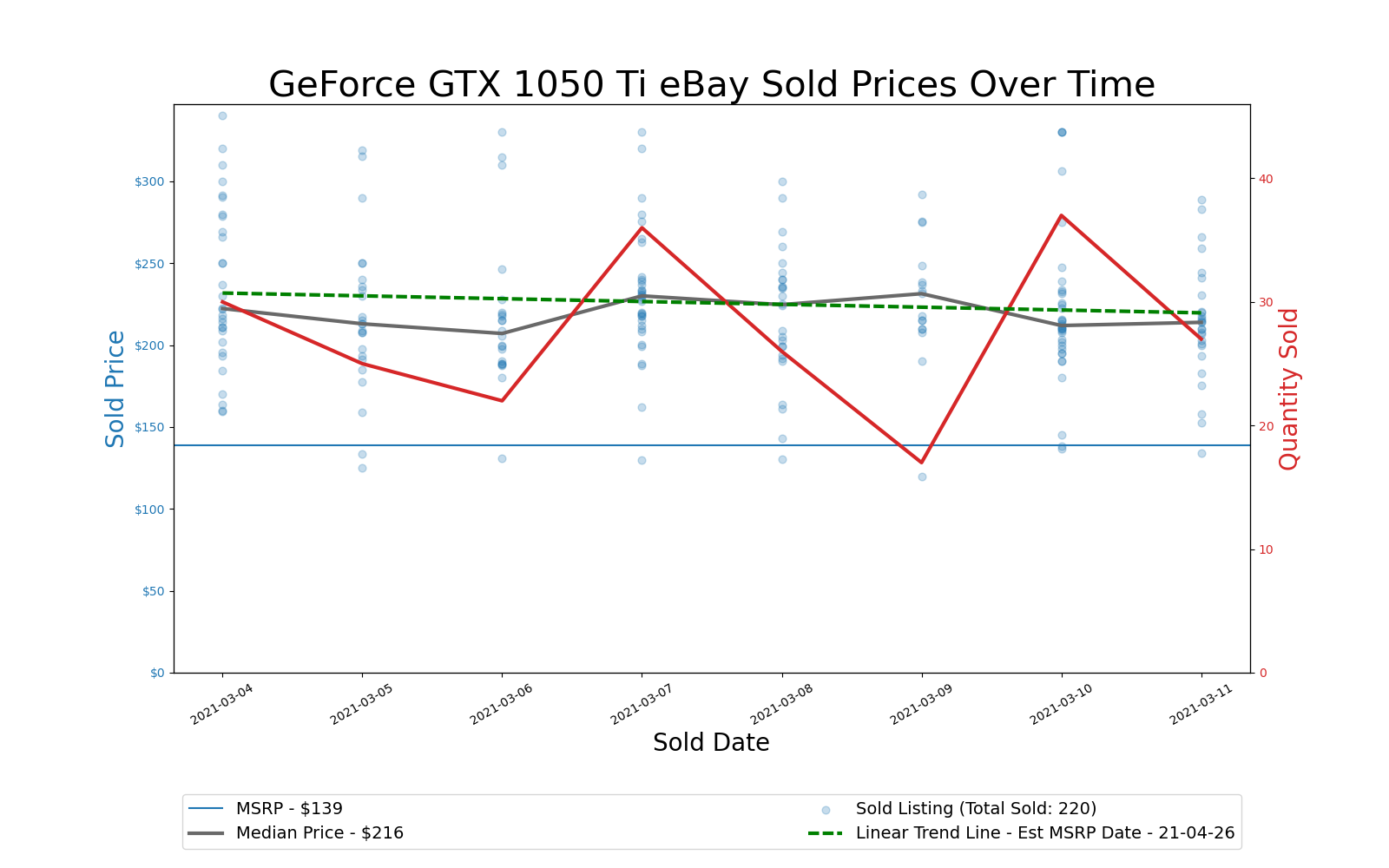
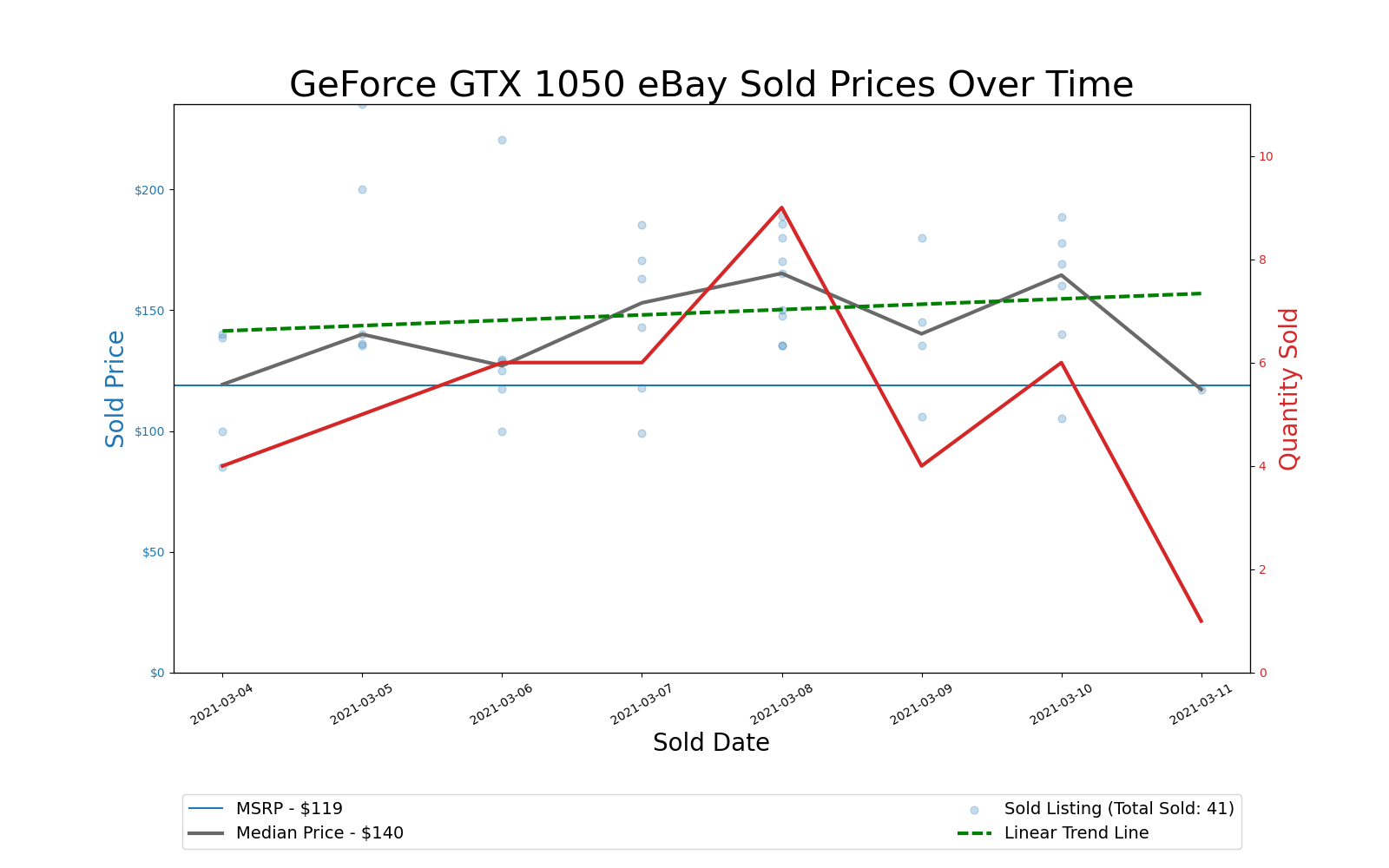

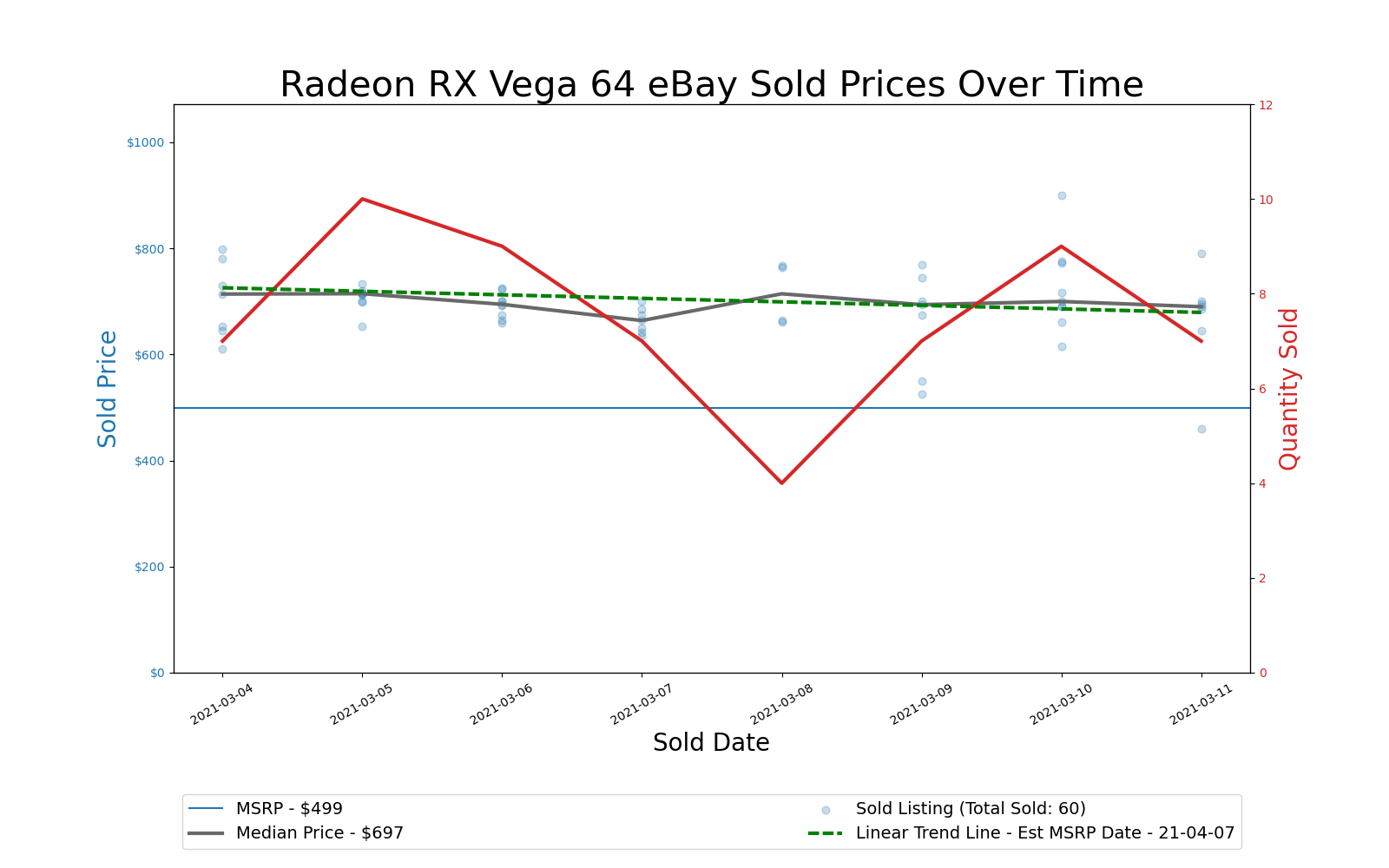












Even with cards that mostly launched three or four years back (or more), prices remain high. That's especially true of AMD's 8GB cards, which are all still double their launch prices on Polaris GPUs. The Vega cards also carry a significant price premium, with the Radeon VII at nearly triple its launch price. Miners, right?
Only cards like the GTX 1050 and 1060 3GB come close to MSRP, and the 4GB Polaris cards like the 570 and 580 aren't priced too badly. Well, until you remember they're three or more years old. Even the relatively ancient RX 400-series cards with 8GB command a premium.
If you just need a graphics card that can run games at modest settings, meaning 1080p medium or high, these old GPUs are the best bet right now. You're still looking at $200–$250, on eBay, but maybe you can find one for closer to $150 if you shop around.
Legacy GPUs and Titans

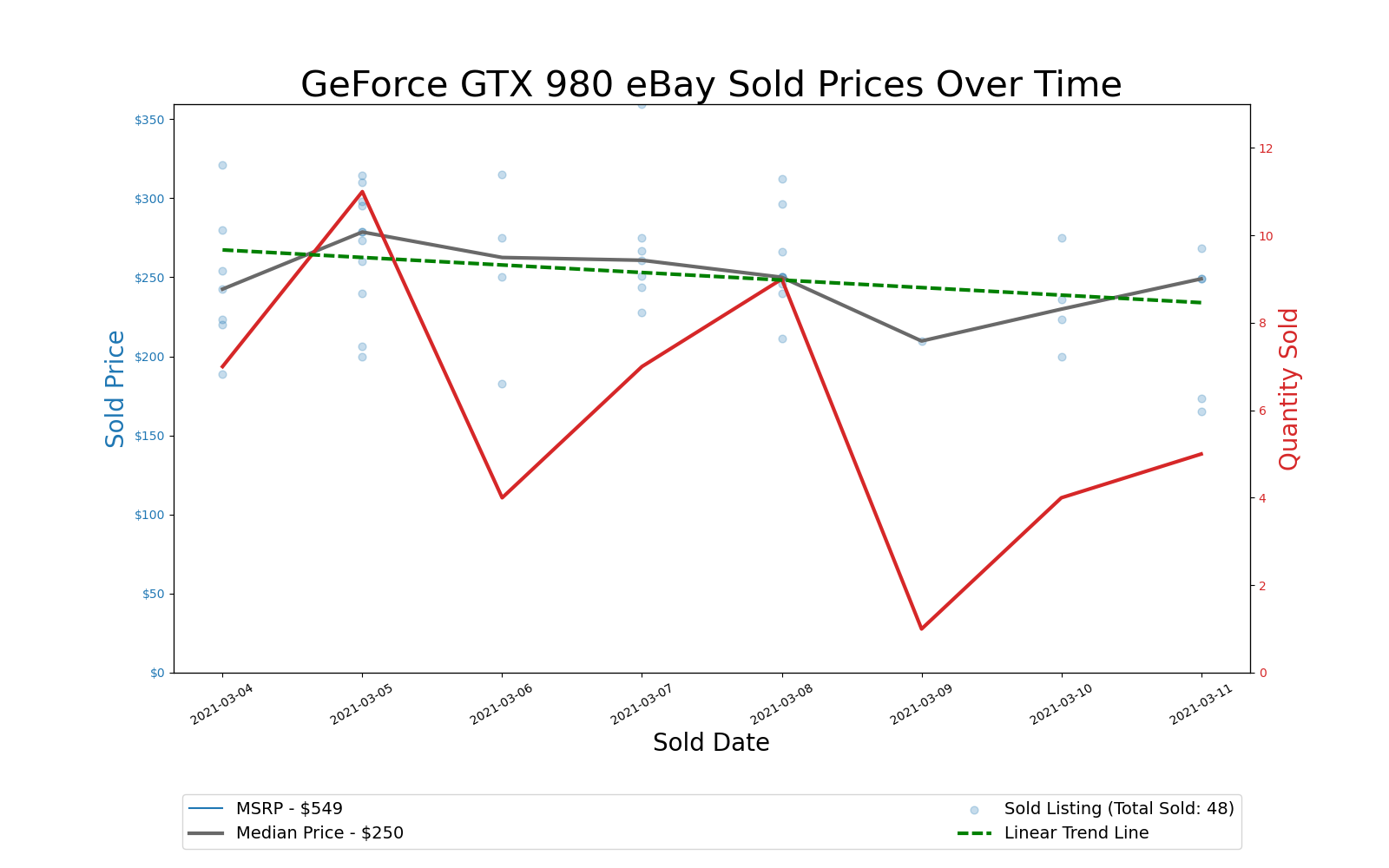




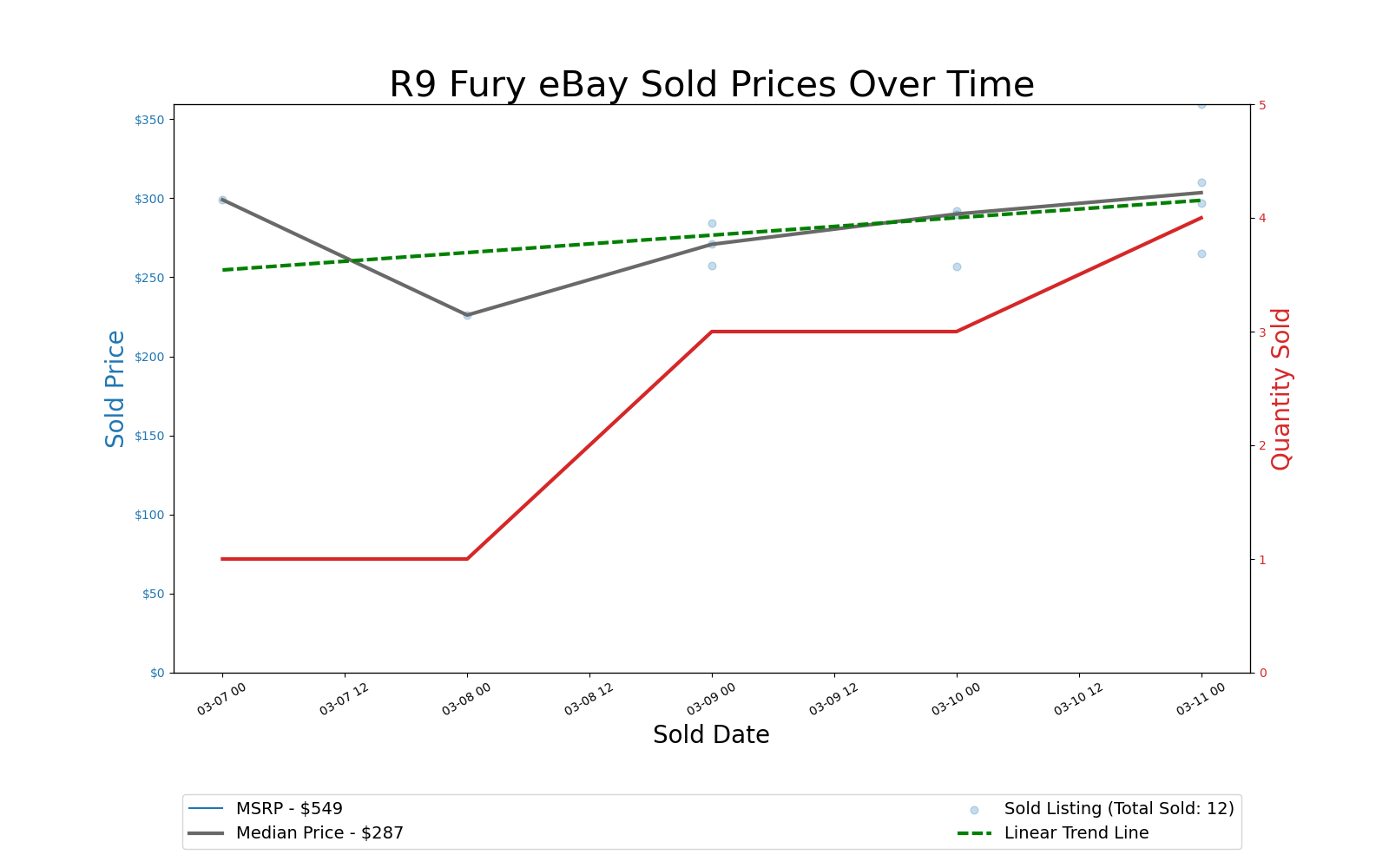







Last, we've lumped together some legacy GPUs along with Nvidia's four most recent Titan cards — the latter mostly being to satisfy our own curiosity. Not many people are buying or selling Titans, which makes perfect sense considering the price to performance ratio. (We didn't provide the charts, but we've also looked at Quadro cards, and most of those have tiny volumes as well.)
Nvidia's Maxwell series might also suffice in a pinch for modest gaming requirements. The 970 can't do 60 fps in the latest titles, but it's still fast enough to be playable, and at around $200 it's a reasonable choice to tide you over. The 960 also lands fairly close to the 1050 Ti in performance, and the GTX 950 comes close to the GTX 1050, for a lower price (but higher power requirements).
The GTX 980 and 980 Ti, along with AMD's Fiji GPUs (Fury, Fury X, and Nano) perform reasonably well, in the 1060 to 1070 range for the most part. Hawaii cards like the 390 and 390X that have 8GB still end up relatively close to their launch prices, sadly, and gaming performance is pretty underwhelming.
Weekly Summary: On the Rebound

After a slight dip in prices last week, many GPUs are trending back up again. That's not particularly suprising if you follow the cryptocurrency scene, as Bitcoin is back in the $56,000 range and Ethereum is around $1,775, both up over 15 percent in the past week. Will we get hit with another surge in crypto prices, leading to even more mining, or will this just be a temporary correction before things drop? That's the question.
We mentioned this as a possibility last week, though we didn't really hope it would happen. Mining and crypto prices still feel inflated, but then we thought the same thing when Bitcoin was at $10,000 so clearly we're not the best judges of value. All that volatility ends up being perfect for market manipulation and day trading, apparently.
With additional reports of various shortages popping up — mobile chips from Qualcomm have joined the 'party' — most analysts now predict supply problems and inflated prices to last throughout 2021. Here's hoping 2022 proves better.
Our GPU pricing index tracks all the best graphics cards and pretty much everything else in our GPU benchmarks hierarchy. Here are the charts for Feb 25–Mar 3, 2021 (with partial data from Mar 4). We've gathered data on 52 different GPUs, which we'll organize into groups based on the GPU generations. The text and content below here remains untouched since March 4 and is provided for historical reference.
Ampere and RDNA2 Graphics Cards



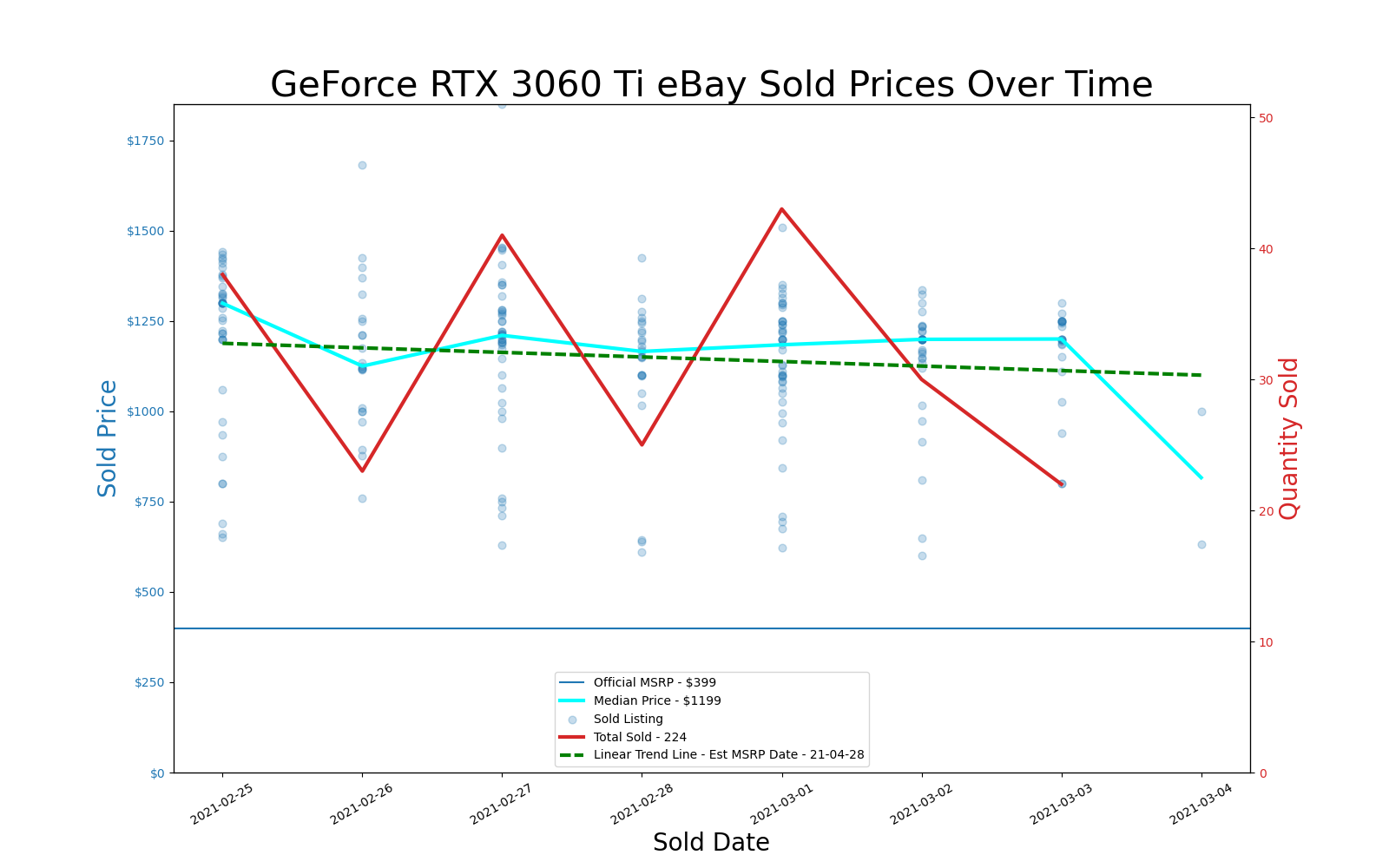


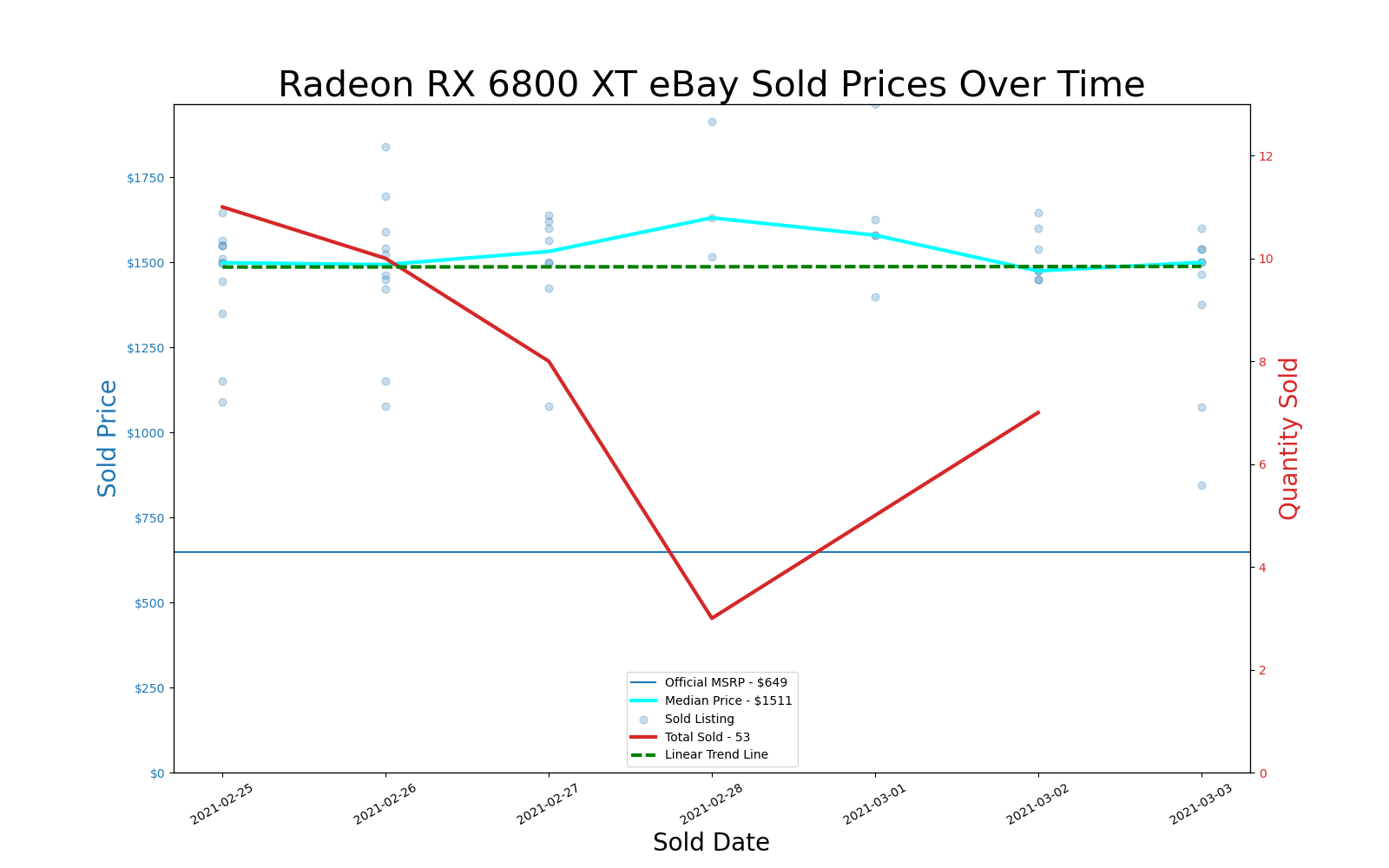

The latest generation graphics cards from AMD and Nvidia see the most demand, from gamers and miners alike. More people want the 'best' option available, and shiny new hardware tends to meet that requirement more than dusty cards from yesteryear. With retail supplies still limited, everything continues to sell for far above the official launch prices.
There's good news in that most of the Nvidia Ampere GPUs appear to be trending downward over the past week. Only RTX 3090 shows a slight upward trend (basically flat), while the others now have projected dates for when they might be back to MSRP. Yes, the projected dates are mostly useless since they're just based on a simple linear trendline, and so many other things can and will likely influence the rate of change. The RTX 3080 projection, for example, says 2031, so I guess by then, it will be selling at higher prices because it's an antique?
Meanwhile, AMD's Big Navi GPUs still have a slight upward slope across the board. That's either because there's more demand for the cards or — more likely — due to the more limited availability. In total, there were 131 RDNA2 cards 'sold' on eBay during the past week, compared to 1,954 Ampere cards. Nvidia's RTX 3070 continues to outsell all other cards by a factor of 3X more, though the new RTX 3060 12GB did brisk sales as well, considering it just launched and has crippled Ethereum mining performance.
Turing and RDNA1 Graphics Cards





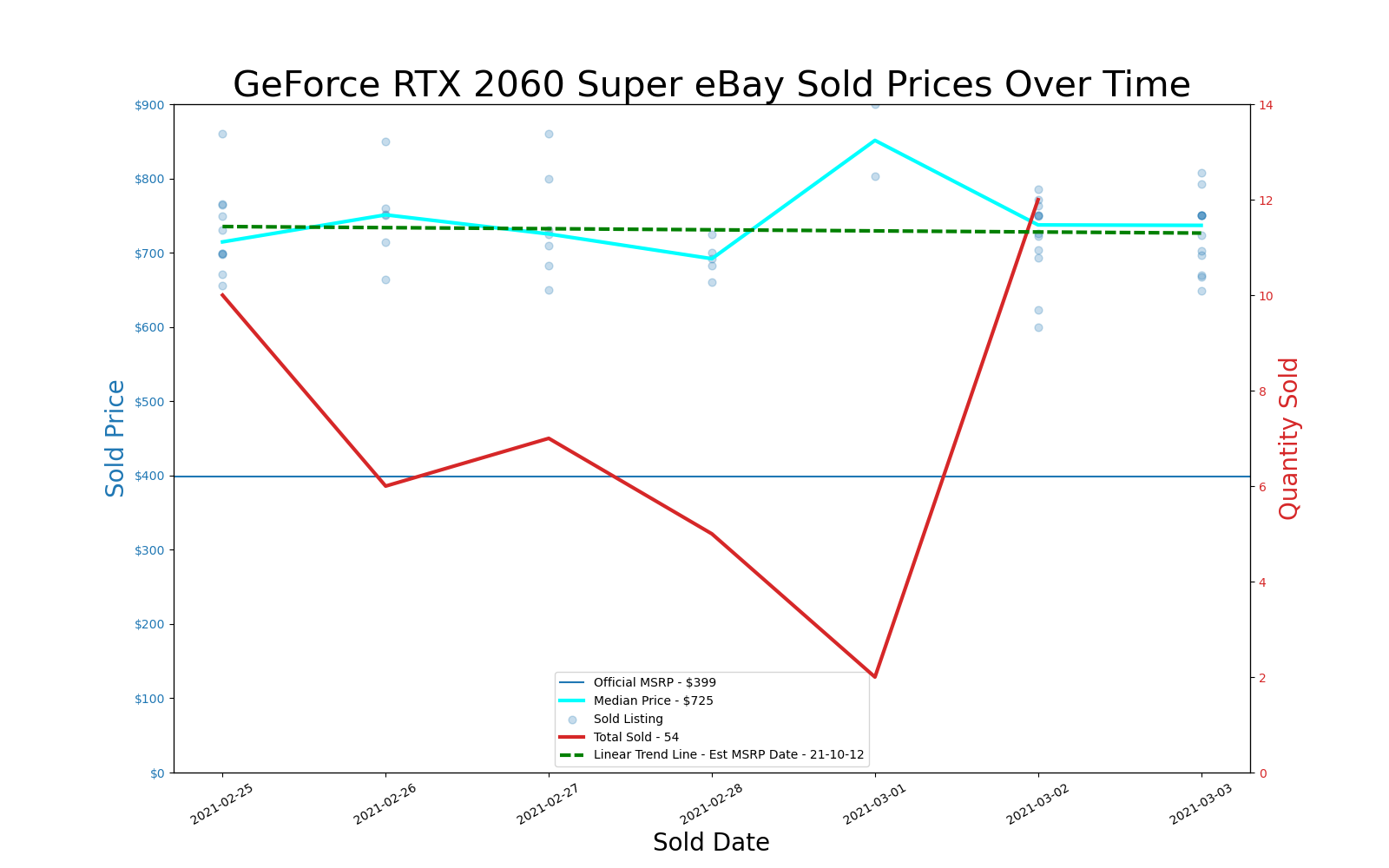

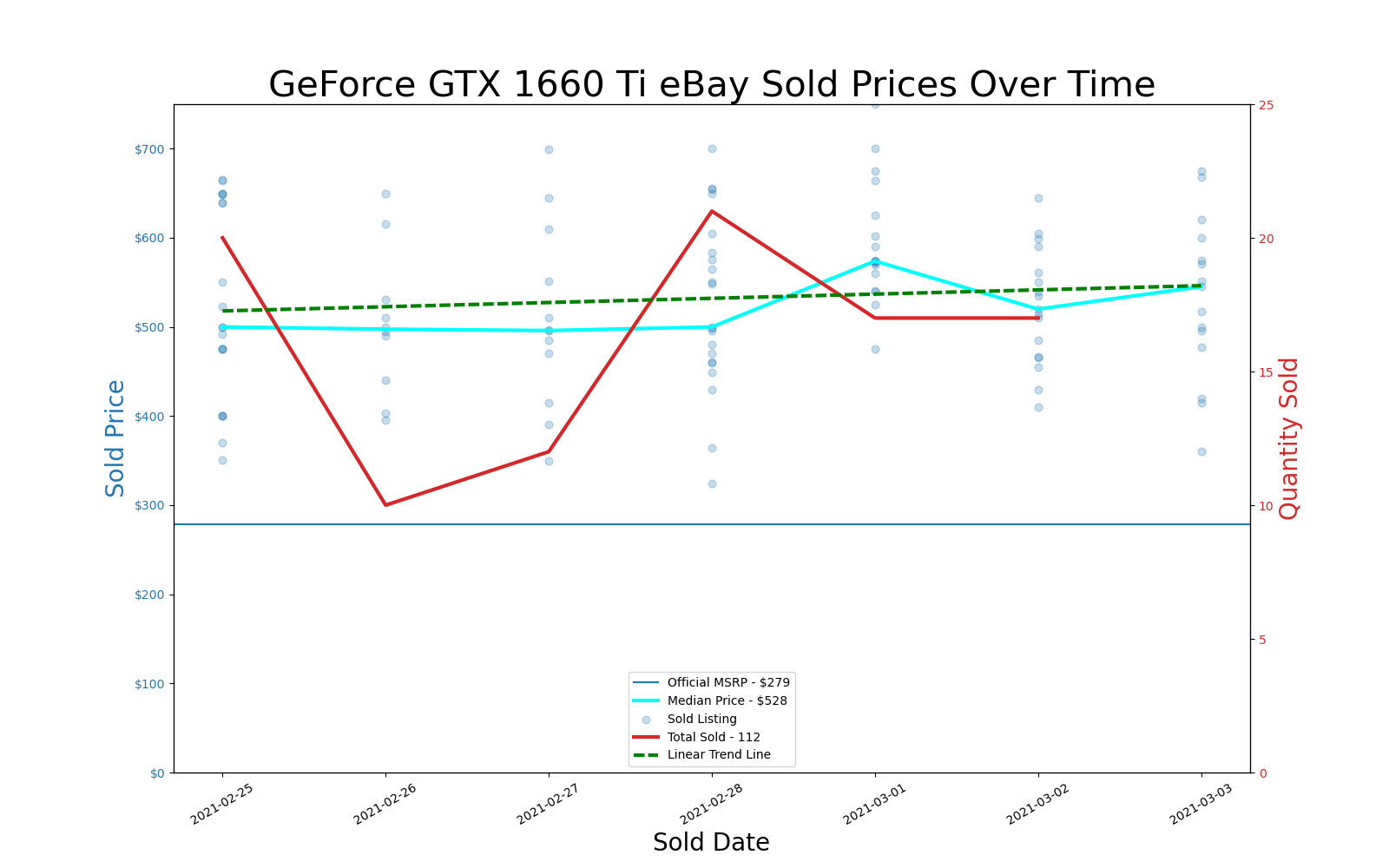





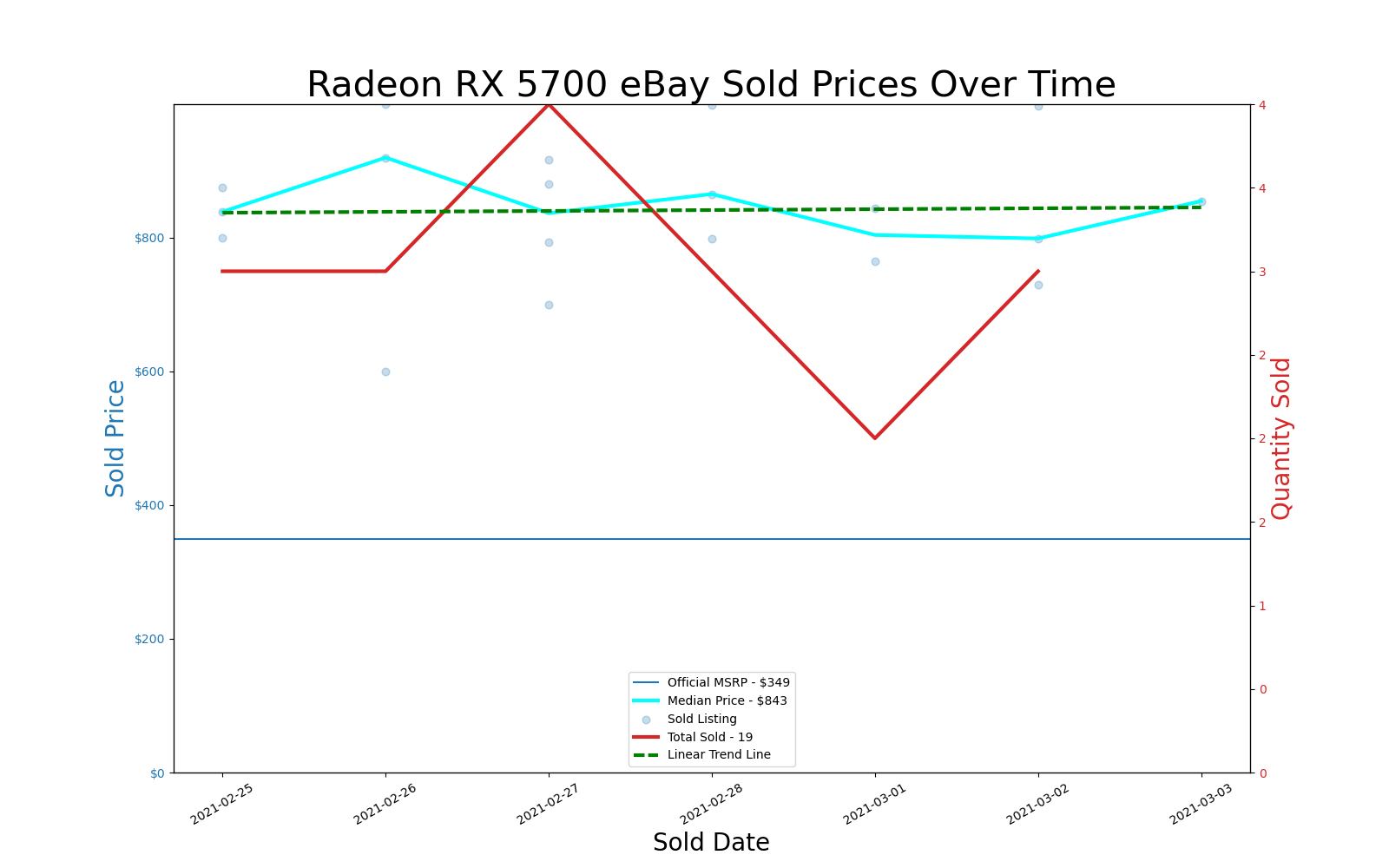



Stepping back one generation, the Turing and RDNA1 cards mostly launched in 2018 and 2019, with a few updates and additions in early 2020. Prices continue to be severely inflated on these cards, though it's good to see that, as above, nearly every Nvidia Turing GPU shows a downward trend (the 1660 Ti, 2080 Super, and 2080 Ti are the exceptions). Most of the prices show a very strong correlation with Ethereum mining performance, though even the GTX 1650 and 1650 Super (which aren't good mining options) are still priced far above MSRP.
AMD's RDNA1 cards likewise show many trending downward in price this past week. The 5500 XT 4GB and RX 5700 are the exceptions, neither of which shows much in the way of volume. AMD's RX 5700 XT and RX 5600 XT continue to be relatively popular GPUs on eBay — again, remembering that these stats aren't perfect and it's impossible to say if every one truly represents a sale, or if some are just eBay cruft. (Many show "auction ended by seller," which can mean a variety of things.)
Compared to Ampere and RDNA2, AMD's volumes are quite a bit closer with RDNA1 vs. Turing RTX. There were 686 Turing RTX cards, 484 RDA1 cards, and 626 Turing GTX sold. And the median price on all of these cards remains very high, with the 5700 XT selling at over twice its launch price.
Pascal, Vega, and Polaris Graphics Cards

















Even with cards that mostly launched three or four years back, prices remain high. They're much closer to launch MSRP, but after three or four years, we'd normally see these selling at around half the MSRPs.
The GTX 1050 and 1060 3GB come close to MSRP, probably because both are poor mining cards and aren't super desirable from a gaming standpoint. If you can live without 4GB VRAM, though, the 1060 3GB is still decent at 1080p medium settings. The remaining Pascal-era GPUs aren't nearly as desirable in terms of eBay price vs. performance. Interestingly, several of these older cards are also trending up in price still, though the most popular models (1060 6GB, 1070, and 1080 Ti) are all on the downward slope.
AMD's Polaris and Vega cards seem to have peaked as well, with the Radeon VII and RX 570 4GB being the only exceptions (and the VII hardly counts with only 28 sold in the past week). That doesn't mean any of these cards are a 'good' deal, but maybe they might get back to their original launch prices in a few more weeks. The RX 570 4GB is arguably the best 'deal' right now for AMD, especially if you need a modest card to tide you over until prices return to normal. It's not a fast card by any means, but it's fully capable of playing games at 1080p and medium to high settings. Cards with 8GB VRAM cost substantially more since Ethereum mining now requires over 4GB to be viable.
Legacy GPUs and Titans

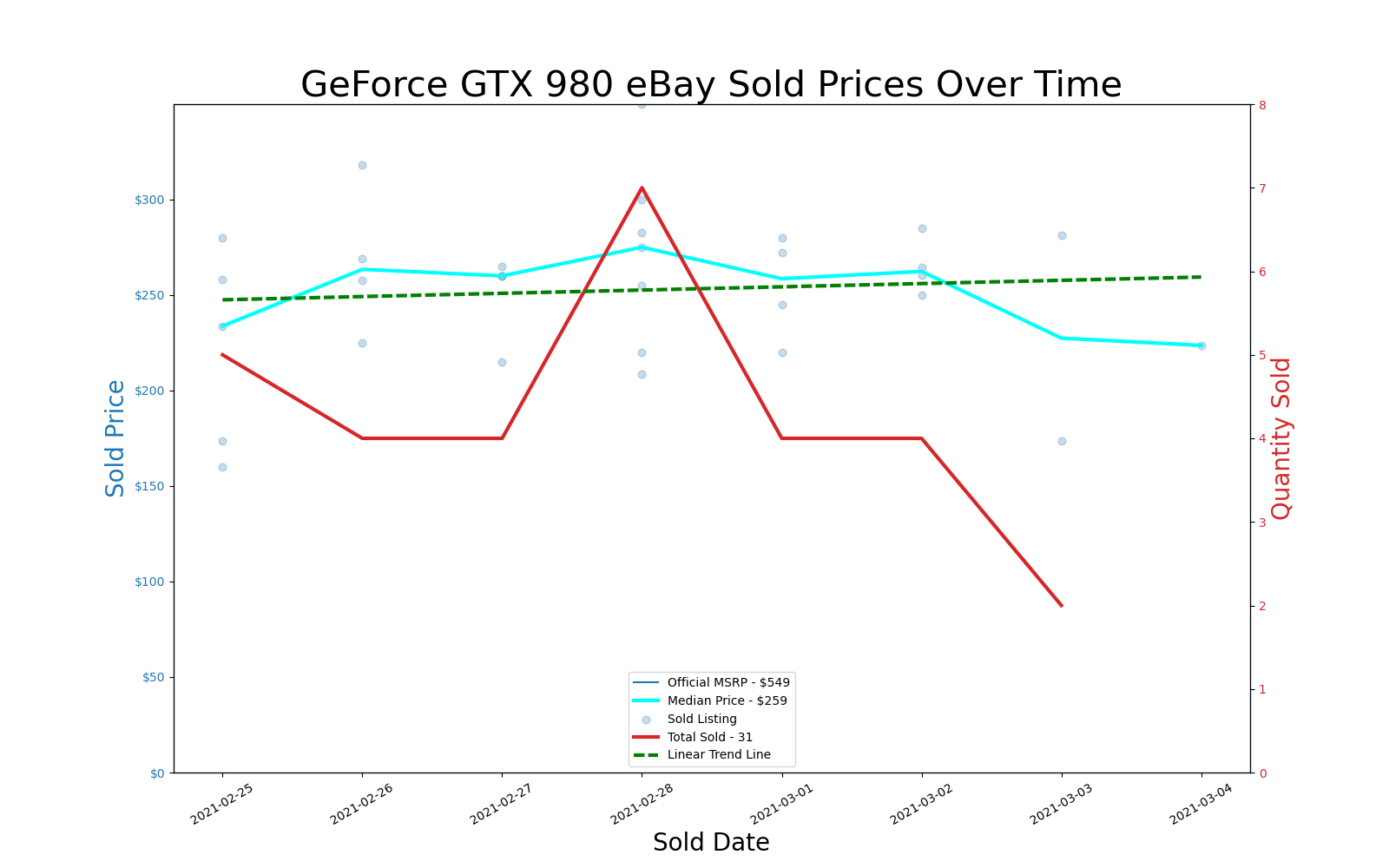








Last, we've lumped together some legacy GPUs along with Nvidia's four most recent Titan cards — the latter mostly being to satisfy our own curiosity. Starting with the Titans, as you'd expect the volume of sales is extremely small: 44 total sales, more than half of these being the old Titan X (which includes both Titan X Pascal and Titan X Maxwell variants, so it gets perhaps double the hits). I do appreciate the two Titan V sales, which happened on the same day, and that killed the trendline and other charting options. Anyway, Titan V is technically the fourth-fastest Ethereum mining GPU, behind the RTX 3090, RTX 3080, and Radeon VII — it can do around 80MH/s while using 160W, give or take.
Nvidia's Maxwell series (we didn't search for anything below the 970) is another old but reasonable gaming option, provided you're aiming for 1080p and medium or maybe high settings in most games. The 970 can't do 60 fps in the latest titles, but it's still fast enough to be playable, and at around $200 it's one of the best options to tide you over. GTX 980 and 980 Ti prices trended upward, which is a bit odd considering their age and features, though the 980 Ti isn't too far behind the 1070 in gaming performance these days.
The volume of AMD cards sold from the R9 era is very limited, and the cards were generally power hungry. With 8GB VRAM, the 390 and 390X also suffer from increased mining demand, so the R9 Fury is arguably a better buy — it's usually the faster gaming card, and priced about the same as the old Hawaii architecture cards. We didn't try to separate out the Fury vs. Fury X sales, though it appears only one of the cards was a standard Fury.
Weekly Summary: Have We Passed the Summit?

Anyone who has tried to buy a new graphics card in the past six months knows how difficult things have been. It started out bad, thanks to the pandemic, and the surge in Bitcoin and Ethereum prices made a bad situation that much worse. The good news: We have (maybe) reached the peak in mining profitability.
Looking at the various mining calculators — which tend to be a bit too favorable on actual profitability, in my view — daily potential profits have dropped off substantially in the past week. Part of that comes from a drop in Bitcoin and Ethereum prices. Bitcoin peaked at over $58,000 and now sits at $49,400, with a low of $43,500 during the past week. Ethereum likewise fell from a high of over $2,000 to a current price of just under $1,600, and the lowest price in the past week was $1,300. That showcases yet again the volatility of cryptocurrencies, and buying a GPU or ASIC today for mining purposes seems foolhardy.
Of course, things could swing the other way just as quickly, and other shortages are expected to continue throughout 2021. Even if mining trails off, we don't anticipate graphics cards selling at the AMD and Nvidia 'recommended' prices any time soon. Still, a 25–30 percent price premium feels almost desirable at this point in time. That's probably the new norm we're heading toward for the rest of the year.
Feb 18 – 24, 2021
These charts from Feb 18-24, 2021 represent the first time we pulled all of this data into one place. We gathered data on 39 different GPUs, the day the RTX 3060 12GB launched. These earlier charts also tend to be a bit more cluttered, but we're leaving them 'as is.' Everything below this point is unaltered since Feb. 25.
Ampere and RDNA2 Graphics Cards
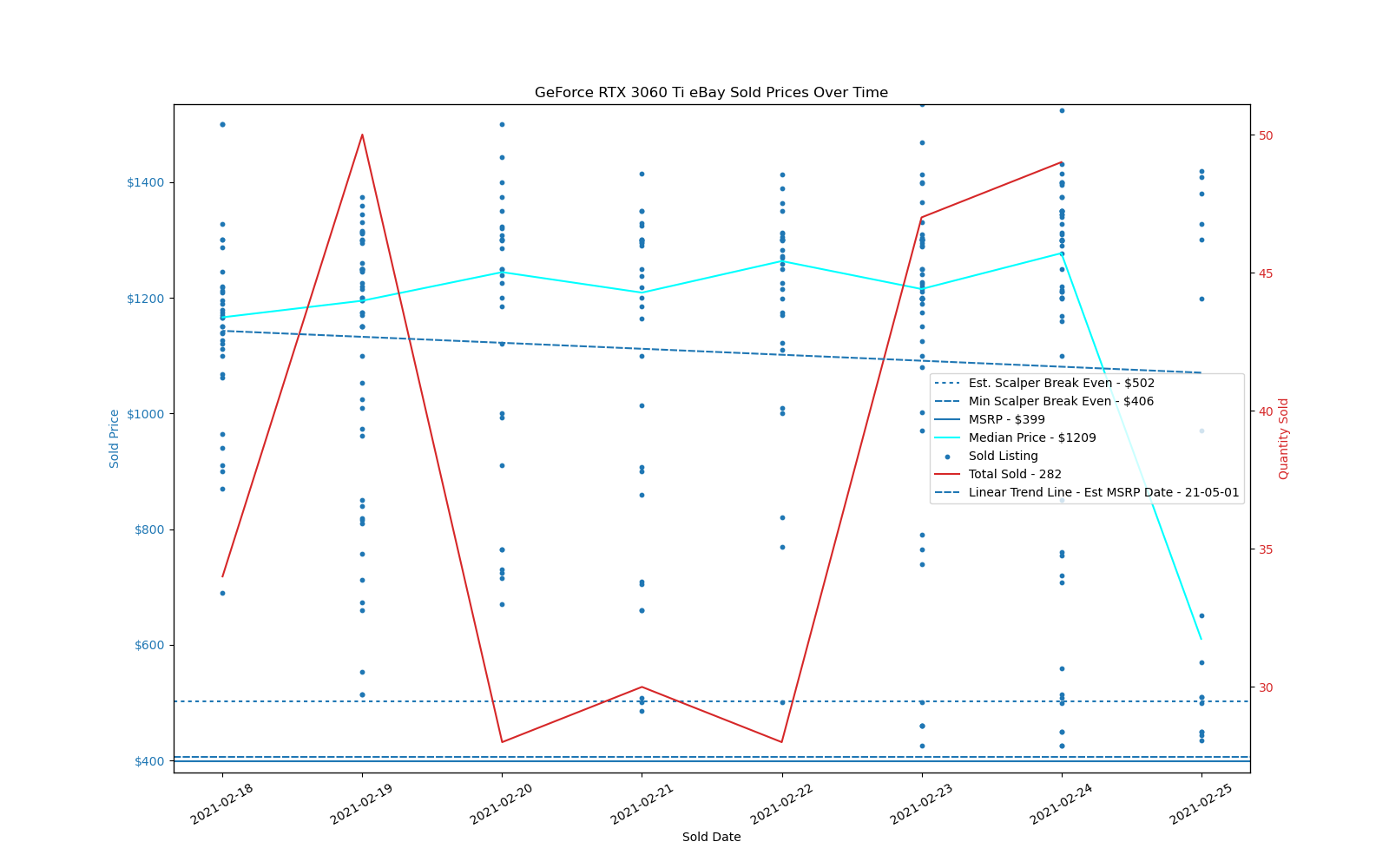


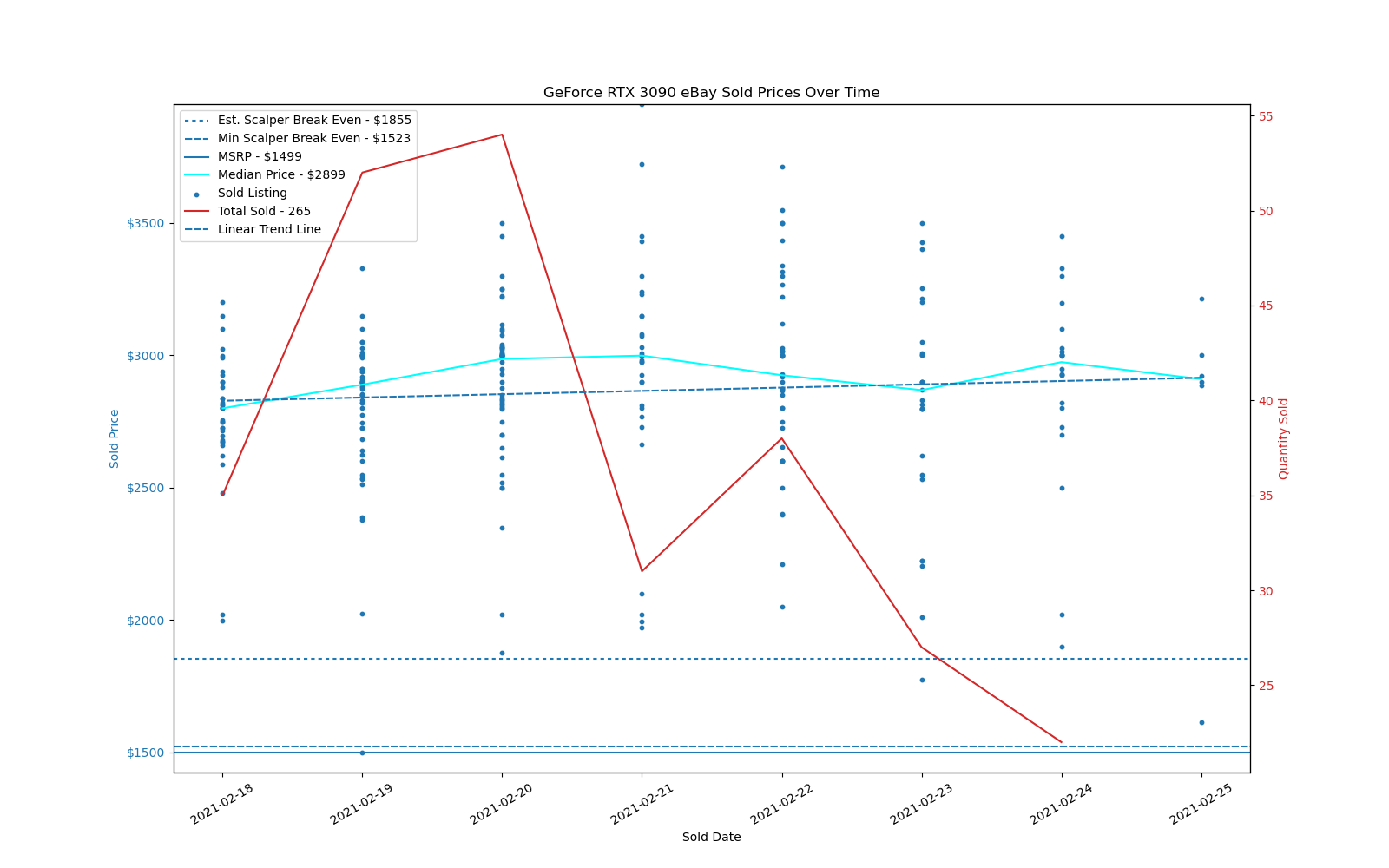

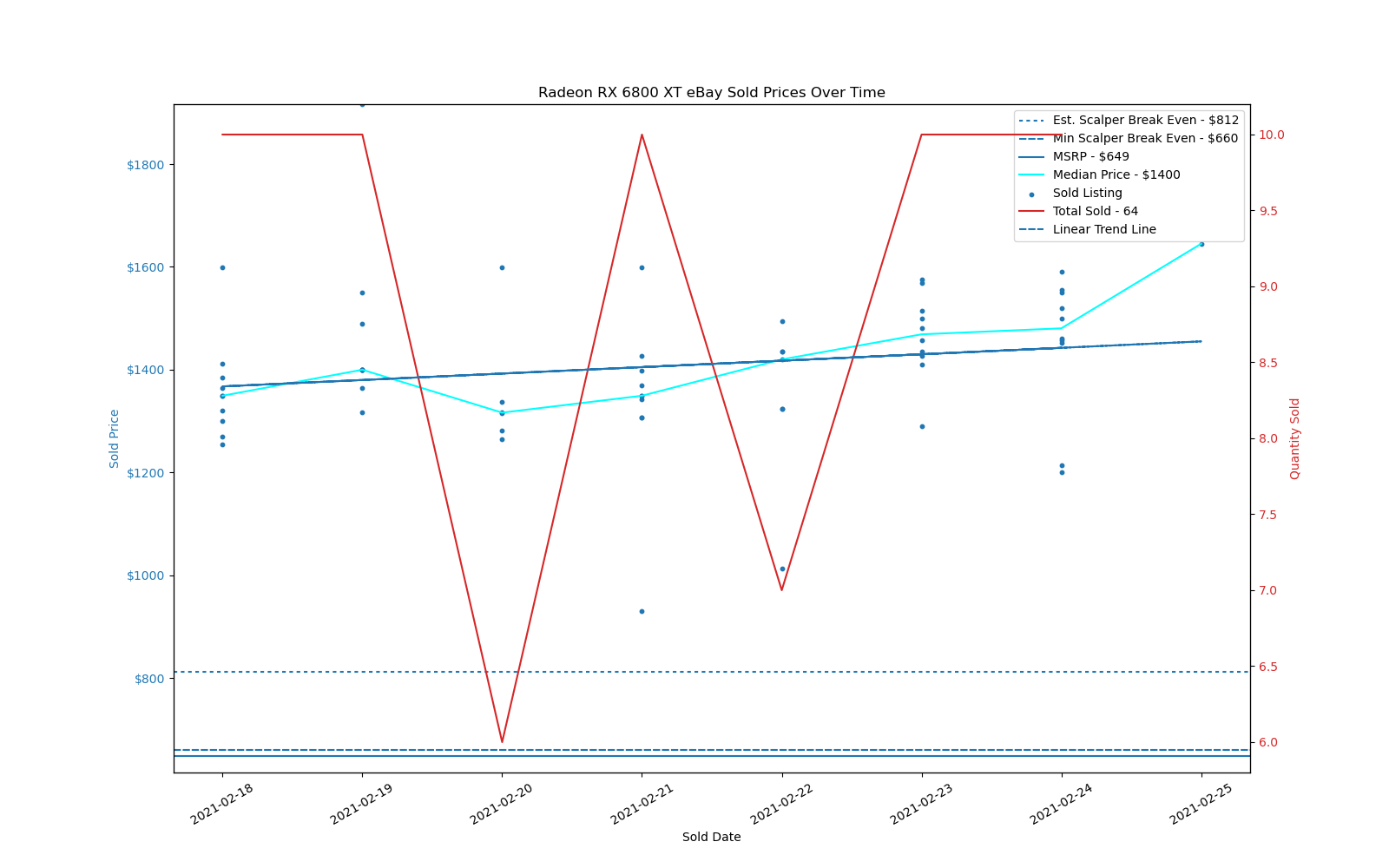

Starting with the latest graphics cards from AMD and Nvidia, everything continues to sell for far above the official launch prices. RTX 3080 has now breached the $2,000 mark for average eBay price during the past week, which actually starts to make the $2,889 median pricing of the 3090 seem almost reasonable. Okay, it's not at all 'reasonable,' but it's 10–15% faster for 42% more money, compared to a difference in MSRPs of 114%. Based on eBay price vs. MSRP, the RTX 3060 Ti ends up as the worst 'deal' right now: It costs more than the RTX 3070 and has a median price three times higher than its MSRP. The 3070 isn't that much better, however, selling for 2.38 times its launch price — it's also the most popular / available of the Ampere GPUs, selling more units than the other three combined. We don't have data for the newly launched GeForce RTX 3060 12GB yet, but given the reduced mining performance it will hopefully land closer to its official MSRP.
AMD's Big Navi GPUs tell a similar story. The RX 6800 costs more than double the official launch price, as does the RX 6800 XT. The RX 6900 XT is the closest to its MSRP, with a 73% markup on the median price, and given its real-world performance it might be slightly more desirable if you're willing to pay these prices. For miners, of course, the RX 6800 remains the best option of the three cards, since all three hit roughly similar hash rates.
Turing and RDNA1 Graphics Cards
















Stepping back one generation, the Turing and RDNA1 cards mostly launched in 2018 and 2019, with a few updates and additions in early 2020. Prices on some models at least get somewhat close to the original MSRPs, though normally we'd expect most of these cards to cost much less than their original launch prices. Median prices on the RTX 20-series GPUs range from just 10% over the launch price (2080 and 2080 Ti), to 80–90% above the lowest MSRP (2060 and 2060 Super). As we've noted elsewhere, most of the prices show a very strong correlation with Ethereum mining performance.
Nvidia's GTX 16-series Turing GPUs are also selling at elevated prices, and the cards with 6GB or more VRAM carry a premium. You can find lower prices on a GTX 1650 or 1650 Super compared to the 1660 cards, but performance is also quite a bit worse. The 1650 basically costs twice the launch price, as does the 1650 Super. Shift up to the 6GB cards and the 1660 GDDR5 model and 1660 Super are more than double the MSRP, while the 1660 Ti actually costs less than the 1660 Super — but only one third as many cards have been sold.
AMD's RDNA1 / Navi 1x cards are in a similar state. The most popular card, by far, is the RX 5700 XT, selling 280 units with a median price of $927. Yup, that's more than double the launch price. RX 5700 costs less but has only had 27 units sold in the past week, so good luck getting one. RX 5600 XT similarly costs 250% of the original price, and RX 5500 XT 8GB sits at nearly three times its launch price.
Pascal, Vega, and Polaris Graphics Cards
















Last, we have cards that mostly launch three or four years back. These are selling at much closer to their launch prices, but in the first half of 2020 you could often find them for less than half that. GTX 1050 and 1050 Ti can still be found for $200 or less, but those aren't even fast GPUs and at one point it was possible to pick them up for under $100. If you don't care about VRAM limitations (you probably should), the GTX 1060 3GB actually costs less than the original launch price — probably thanks to being a relatively poor mining GPU. The 1060 6GB meanwhile costs 40% more than its nominal launch price, and the 1070, 1070 Ti, and 1080 Ti land just above launch pricing as well. Only the GTX 1080 costs less than the old $549 price, which is the adjusted price after the 1080 Ti arrived (it was originally a $599 card for a while).
AMD's Polaris and Vega cards are also severely overpriced compared to early 2020. Remember when RX 570 4GB cards were readily available for just $120? Well, even though they're not great for mining these days, they're still selling for a median price of $220. The 8GB cards cost substantially more, at $413 for the 570 and $449 for the 580 — similar prices because they both deliver similar mining performance. The RX 590 actually costs a bit less than the 580 8GB, mostly because there aren't nearly as many of them floating around. RX Vega 56 and Vega 64 are also relatively close in price and currently cost about 50% more than at launch, while the Radeon VII — AMD's fastest mining GPU, thanks to its 1TBps of HBM2 bandwidth — is nearly triple its launch price. That's overpriced, but it's nearly double the hashing speed of Vega 56/64 and in relatively limited supply.
Weekly Summary: Mining Demand Remains Strong

Nearly every graphics card continues on an upward trajectory during the past week, mostly thanks to demand from the mining sector — at least, we can't imagine many PC gamers lining up to pay these prices. There are a few exceptions, but most aren't particularly noteworthy, especially with only one week's worth of data. The GTX 1650, GTX 1660 Ti, RTX 3060 Ti, RTX 3080, RX 590, RX 5500 XT, and RX 6900 XT all show a linear downward trend, but given they're far from returning to normal price levels.
There's perhaps some light at the end of the tunnel, though — faint and distant light, but these things can change quickly. After hitting a peak price of over $58,000 for Bitcoin and $2,000 for Ethereum, both have dropped a bit in the past few days. Mining profits from an RTX 3060 Ti now sit at an estimated $5.67 per day, which means it would take 213 days of 24/7 mining to break even at current rates, and the RTX 3080 has an estimated $8.84 per day in profits (after power), so it would require 232 days to reach the break even point (based on eBay's median pricing for the past week).
Ethereum difficulty continues to rise as well — it went up 5% in the past week — which means every GPU used for mining will make proportionately less money. What would really help GPU prices most is a big drop in cryptocurrency valuations, which has happened a bit this past week, but there's a long way to go. Bitcoin dipped by 5.4% over the past week, and Ethereum dropped 14.4% (that's from one week ago, not from the all-time high during that time frame). If both trends continue, sometime in the next month or two miners would likely stop investing in more hardware.
Meanwhile, Nvidia just announced that it made "$100 to $300 million" in estimated sales to cryptocurrency miners just in its last quarter. Let's be honest: It was probably a lot higher. Actually, that was for Q4 2020, so perhaps not, but miner sales in Q1 2021 probably account for at least half of all GPUs sold. That's just a guess, but given the massive spike in Bitcoin and Ethereum prices, it wouldn't be at all surprising. At least the new RTX 3060 12GB isn't a particularly attractive mining option, though that didn't stop it from selling out.







